Inbox and environment news: Issue 583
May 14 - 20 2023: Issue 583
Turimetta + North Narrabeen
Monday to Friday - May 8 to 12, 2023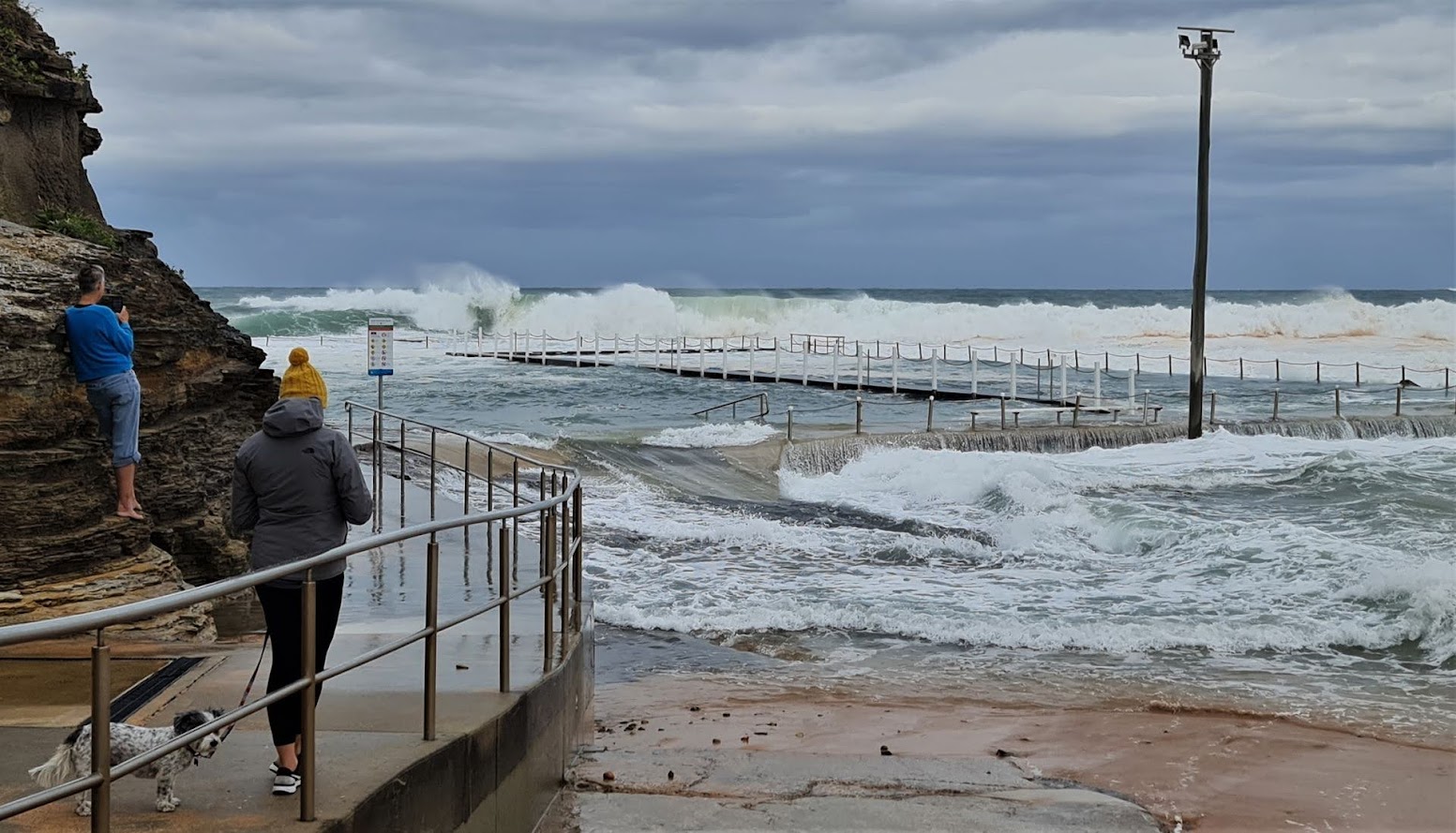
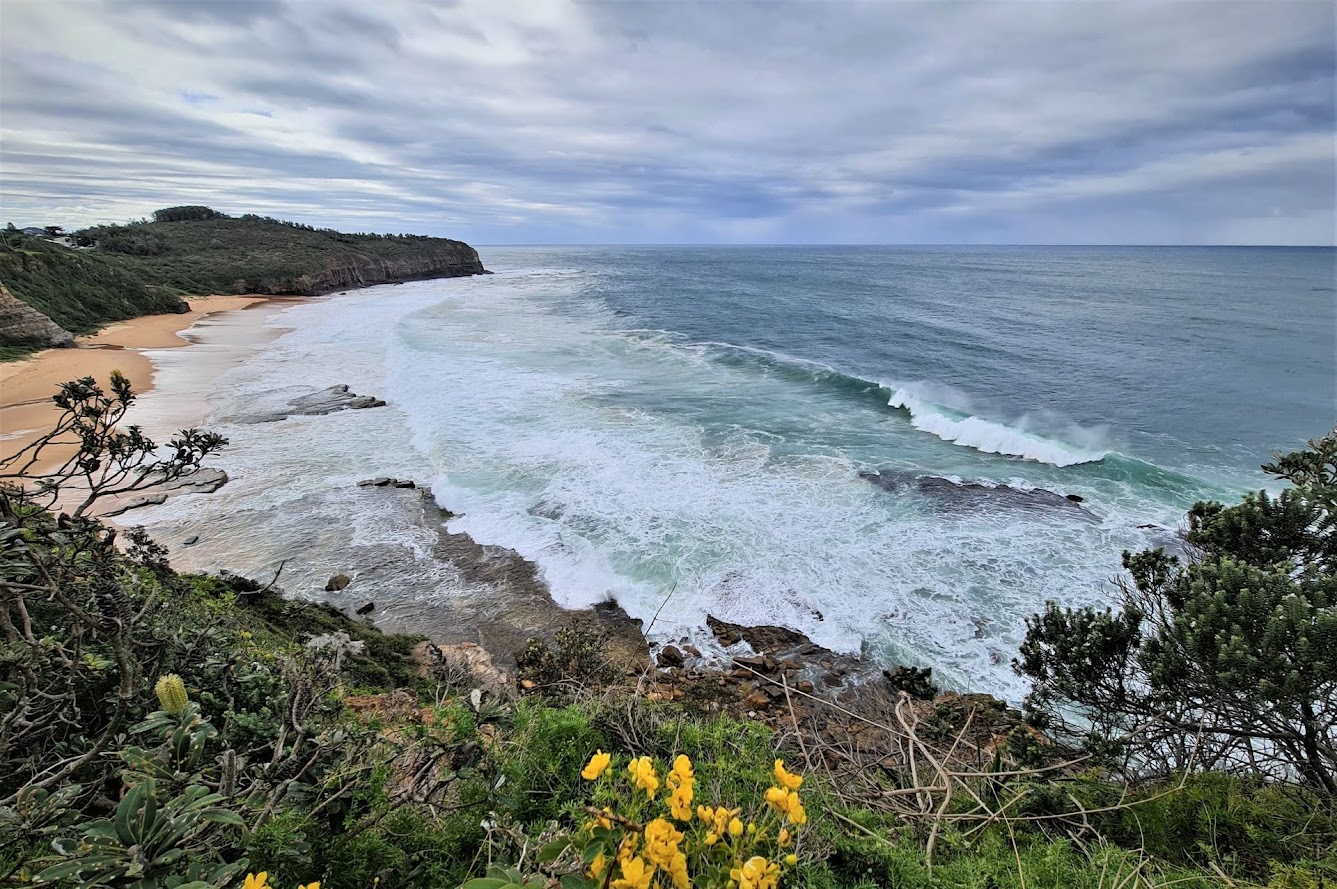
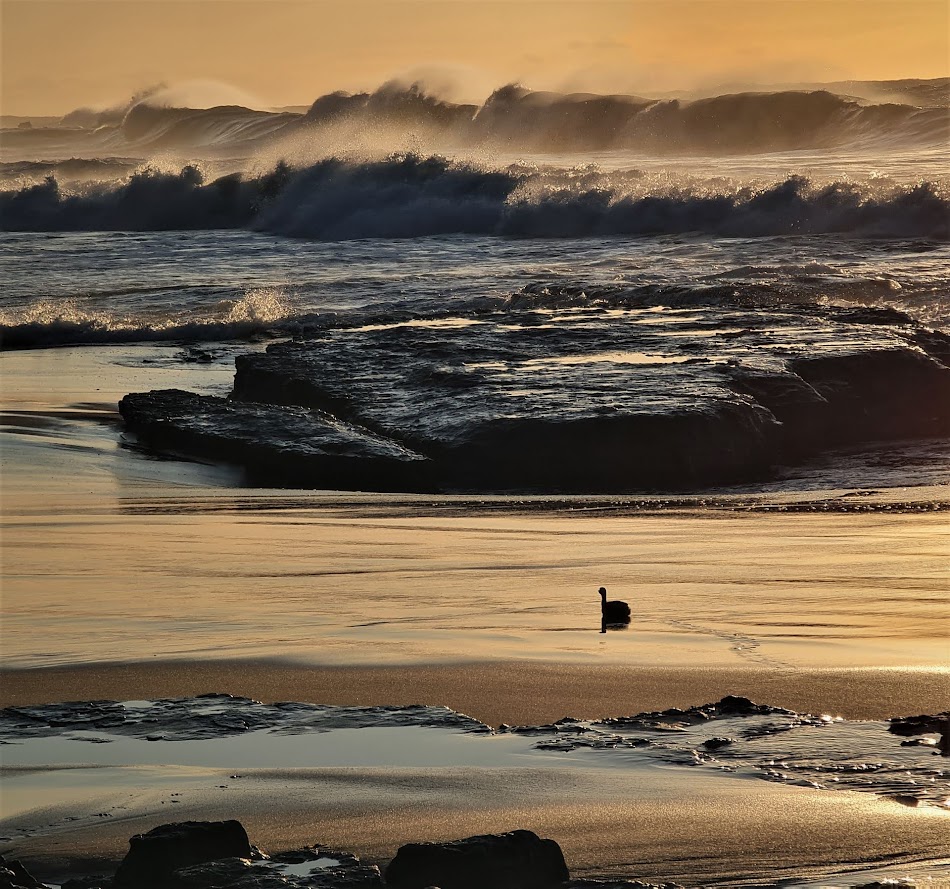
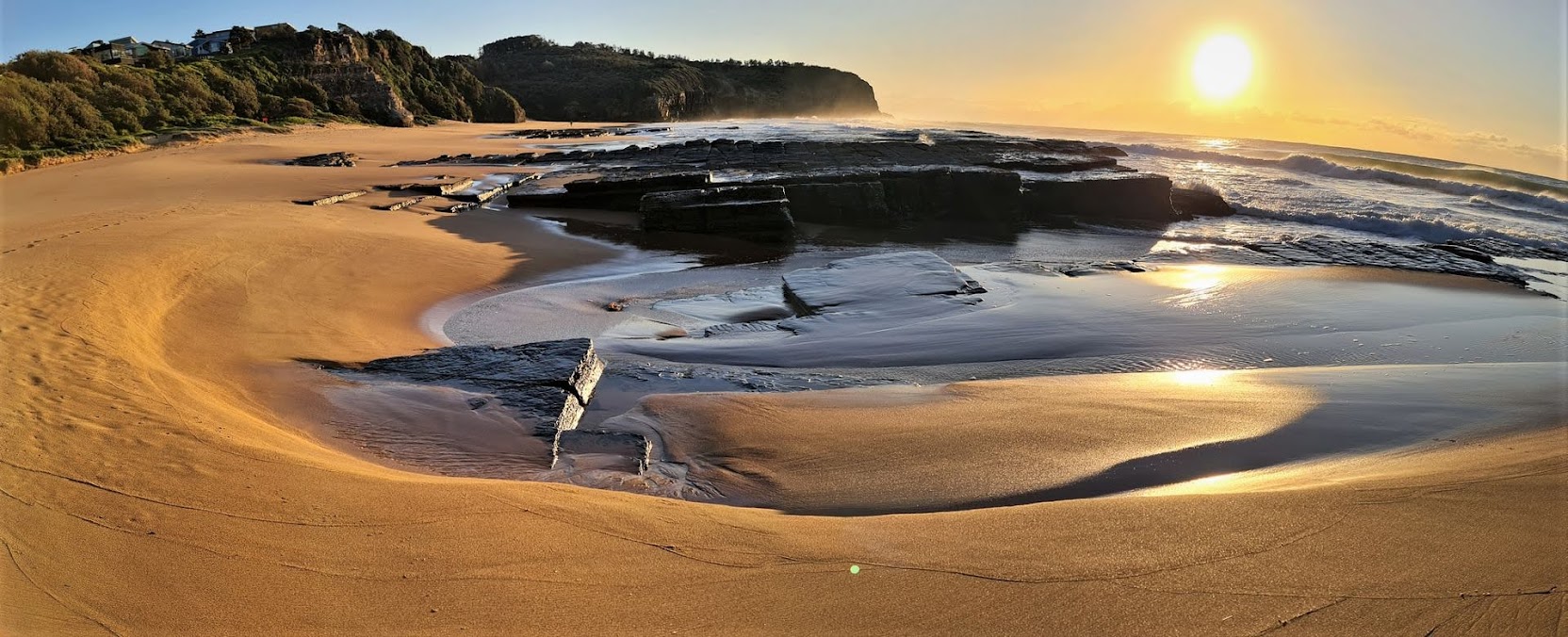

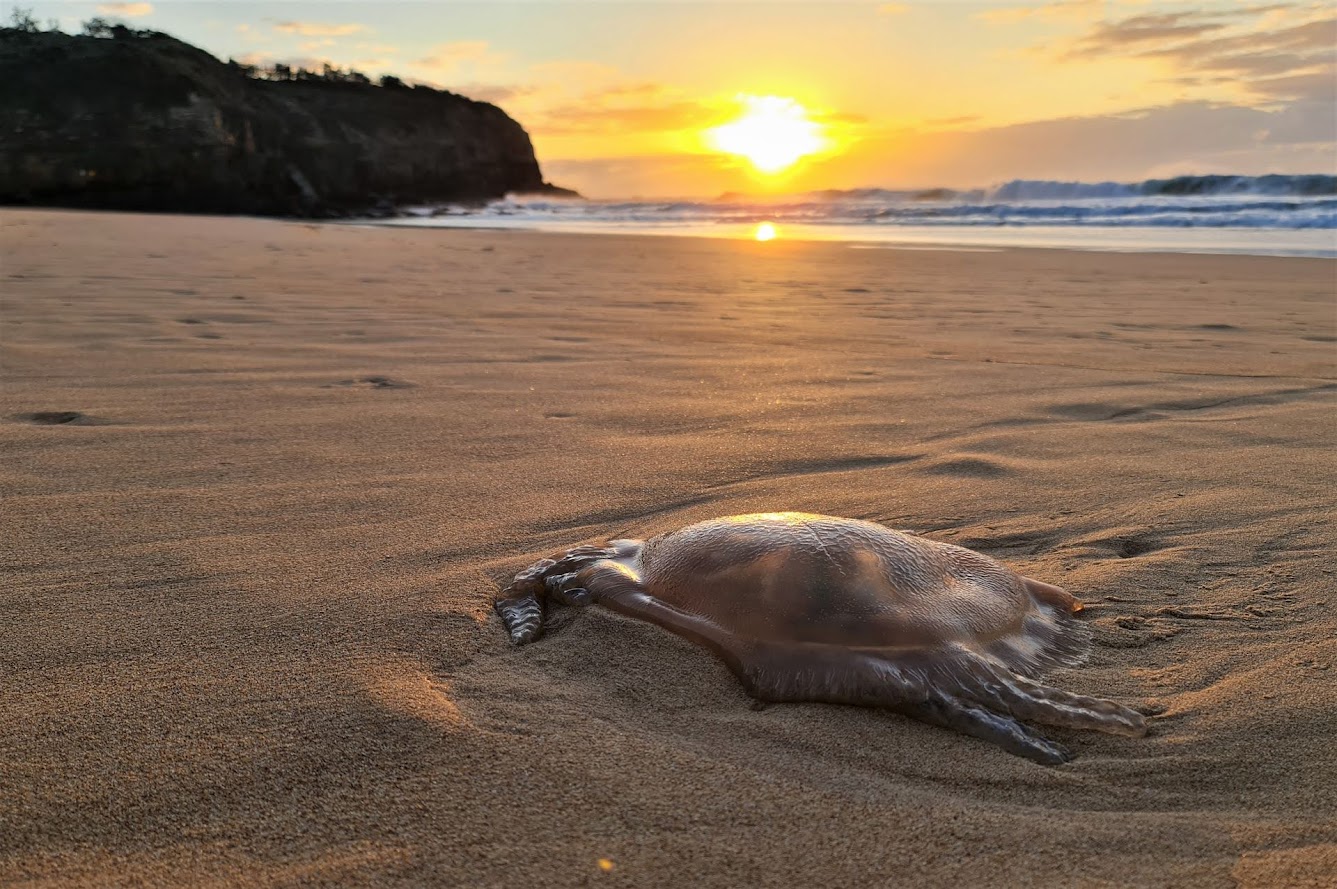
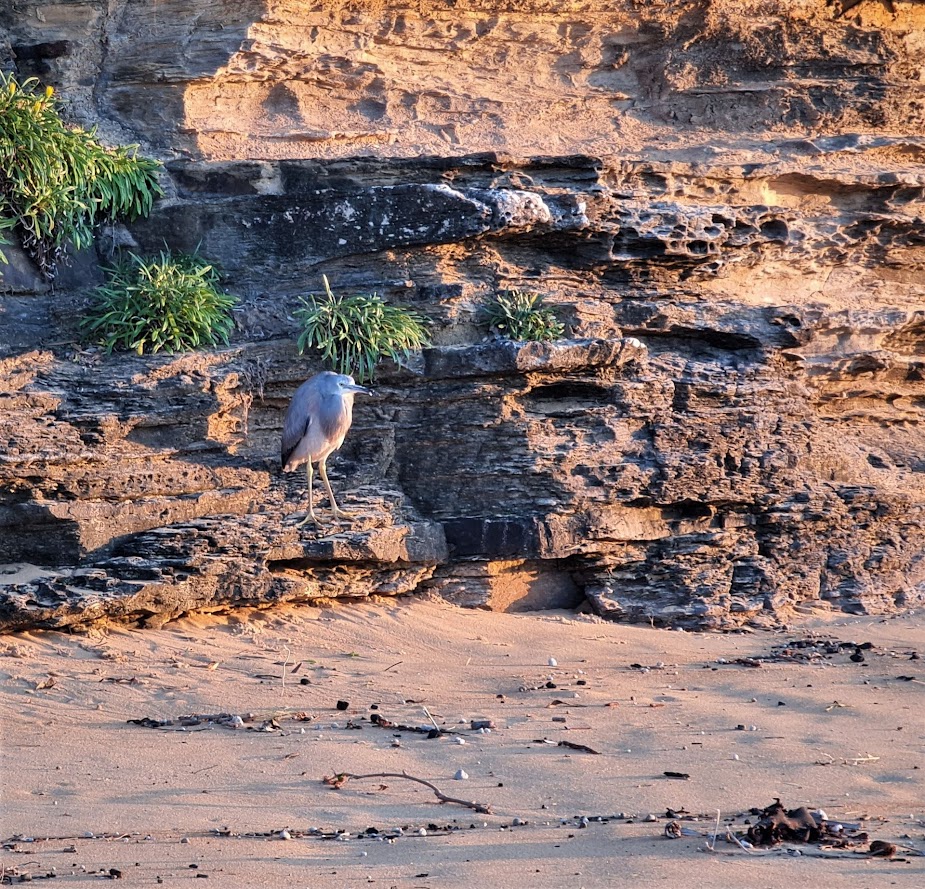
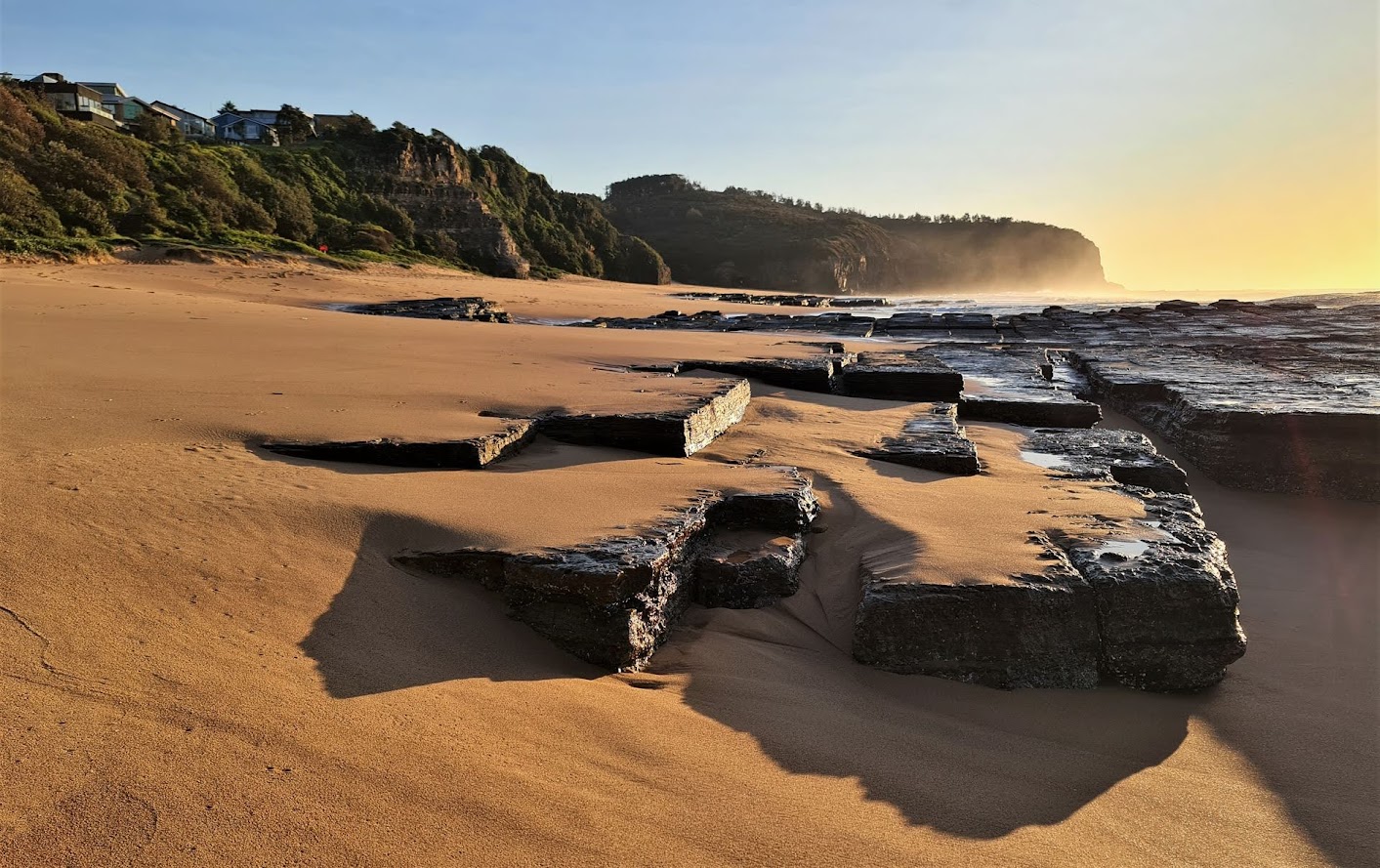
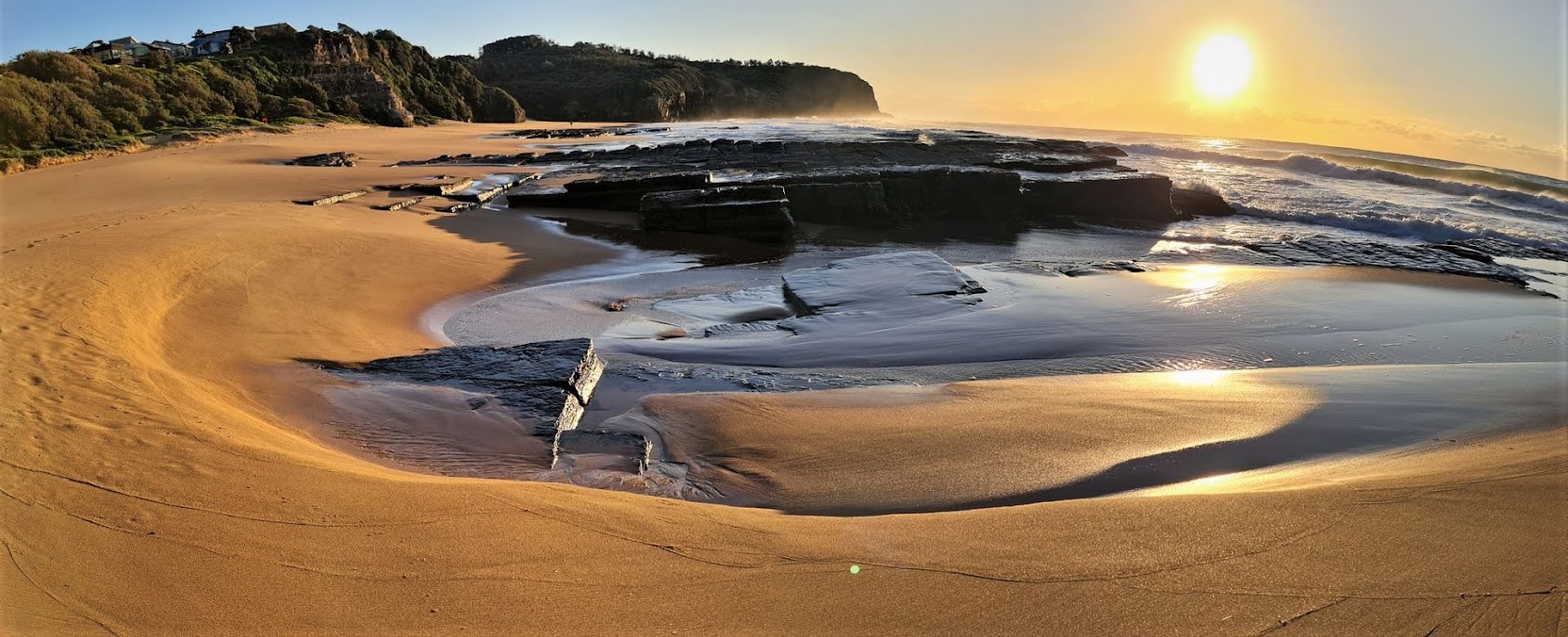
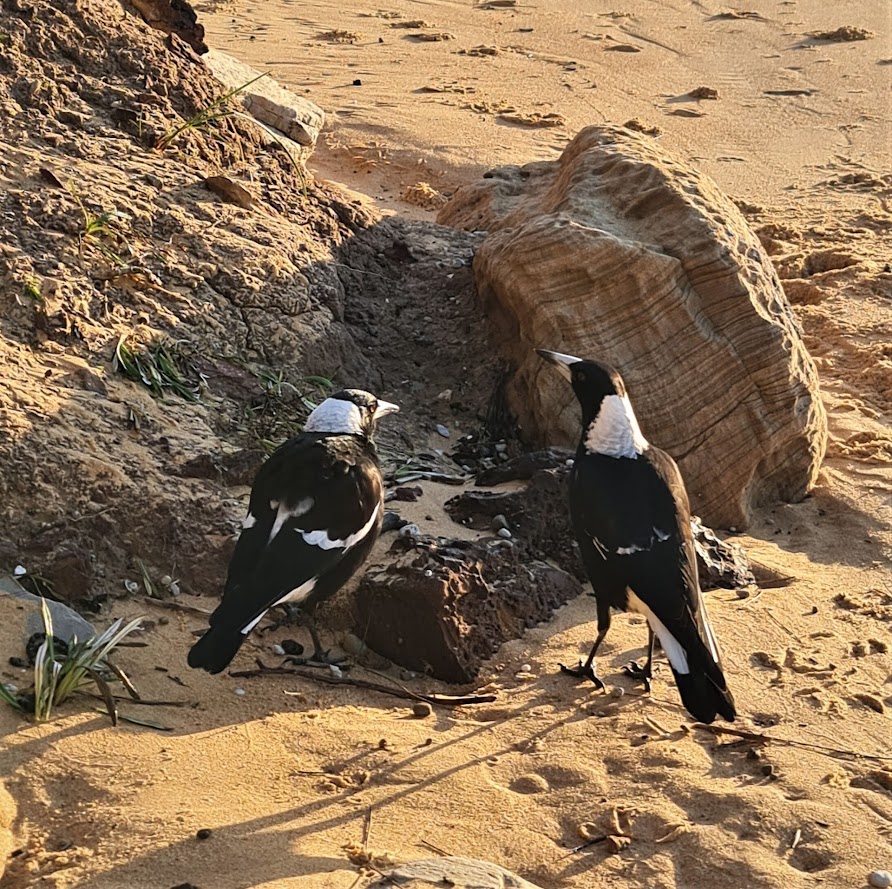
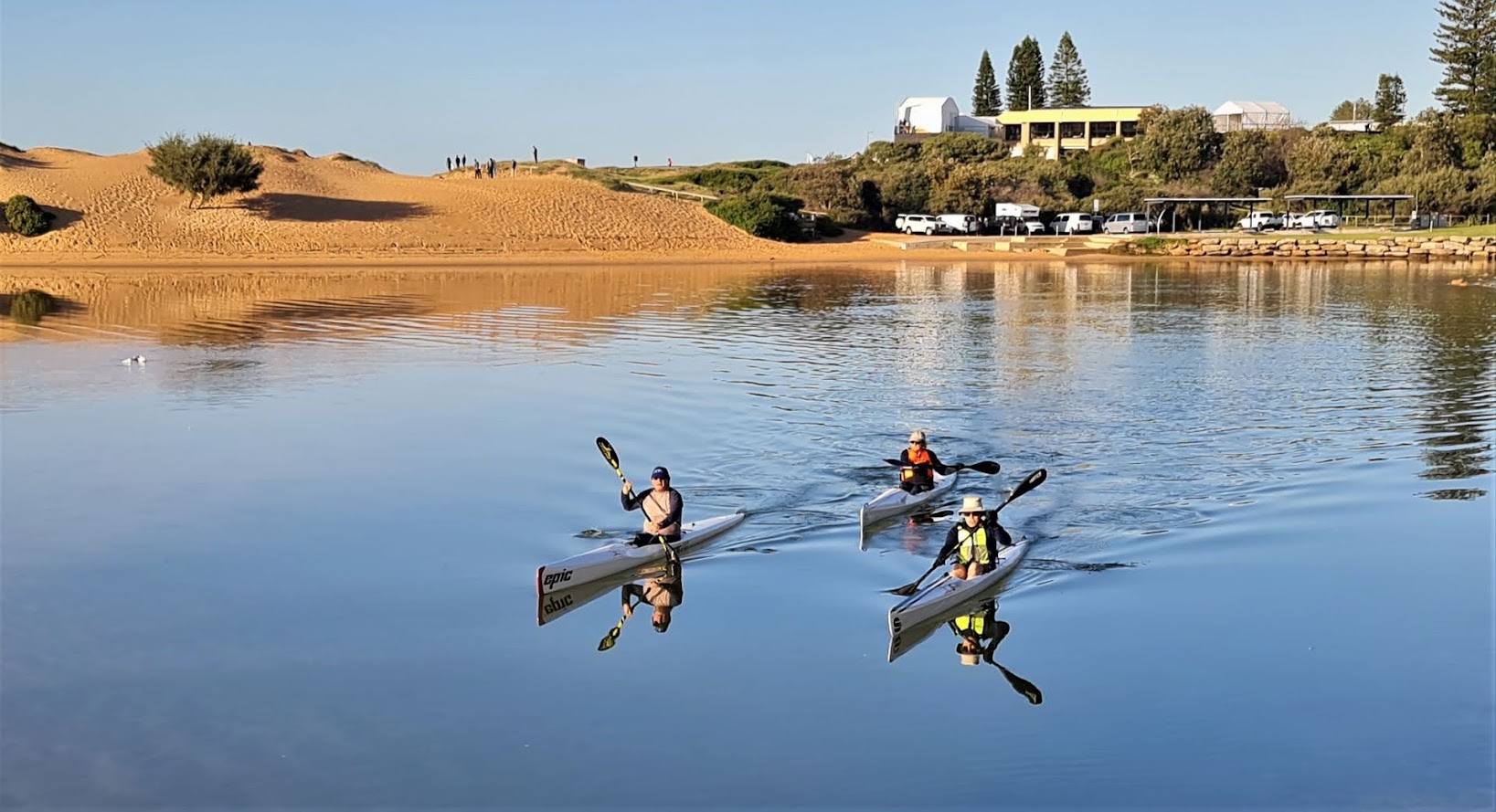
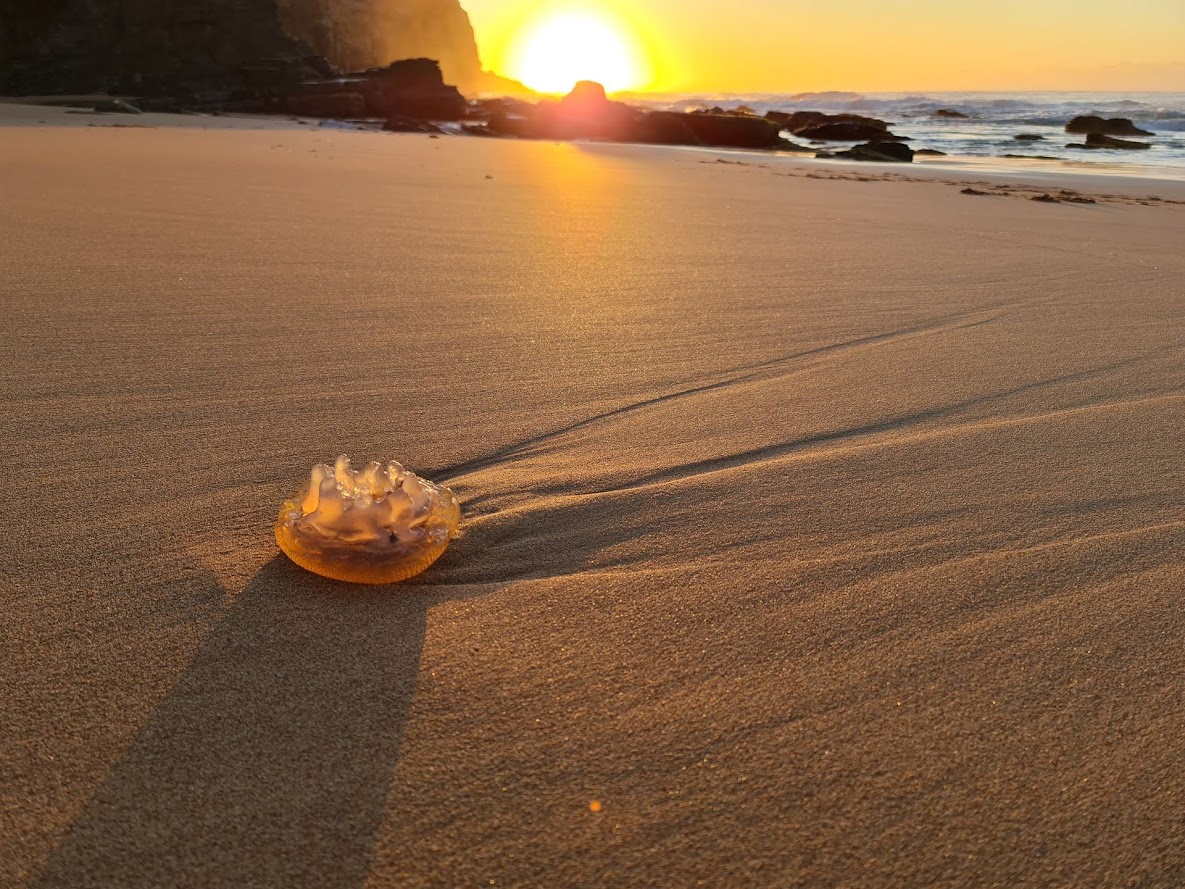
Protect Mona Vale's Bongin Bongin Bay - Establish An Aquatic Reserve
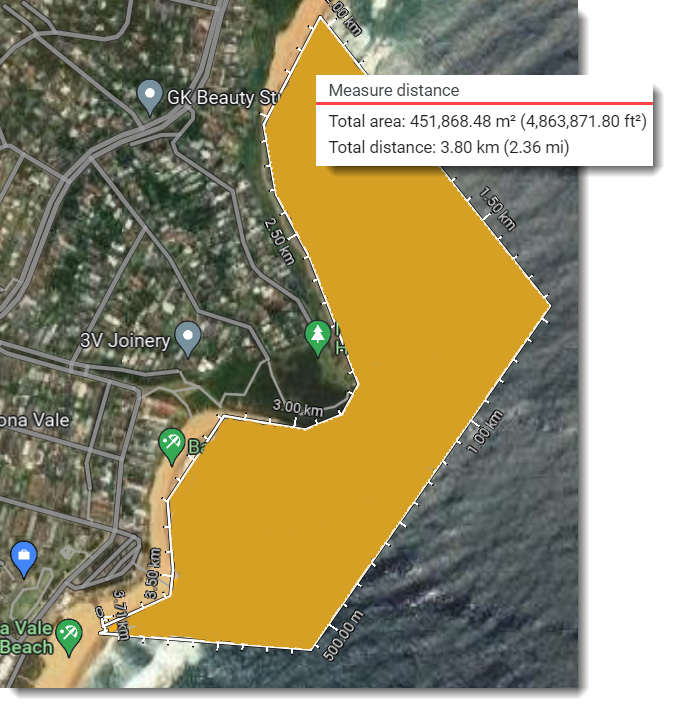
Friends Of Bongin Bongin Bay (Mona Vale Basin) Update: May 2023

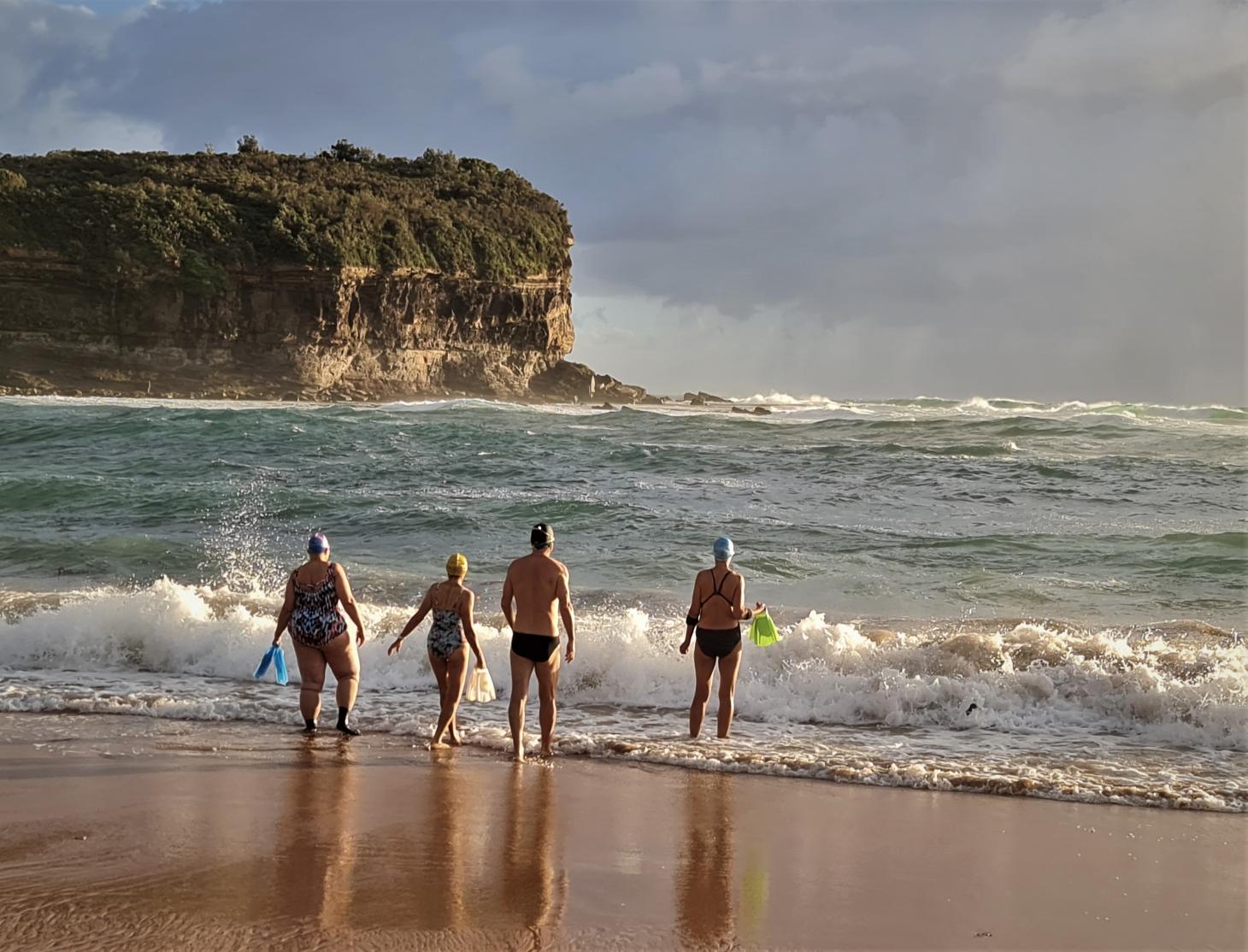
Northern Beaches Sustainable Business Solutions Forum: May 17 At Brookvale
WHEN: May 17, 2023 - 6pm - 8:45pm
WHERE: 4 Pines Brewery, Brookvale, 4f 9-13 Winbourne Rd
ACF Northern Beaches Community is excited to announce our free Sustainable Business Solutions Forum on Wednesday, 17 May at 4 Pines Brewery, Brookvale.
How do you run a successful business and protect the environment at the same time? Hear from our speakers who will share their journey on how they're doing just that. We want to inspire local businesses to transition to sustainable business practice moving towards a circular economy, connect consumers to local sustainable products and services and create a space for local businesses to connect and share ideas.
You'll hear from a range of speakers who will share their experiences implementing sustainable practices into their business, how they can help others, and what support is available to organisations to reduce their footprint on the planet.
Our speakers:
Victor Volpe, CEO & Founder
Chris Volpe, Co-founder
Fox Wardrobes
Yianni Mentis,
Executive Manager Environment and Climate
Northern Beaches Council
Mary Walker
Co-founder
devolver
David Stuart,
Managing Director
Colormaker Industries
Northern Beaches Clean Up Crew: Freshwater May 28
Come and join us for our family friendly May clean up, close to Freshwater Surf Lifesaving Club on the 28th at 10am. We meet in the grass area behind the surf life saving club.
We have gloves, bags, and buckets, and grabbers. We're trying to remove as much plastic and rubbish as possible before it enters the ocean. Some of us can focus on the bush area and sandy/rocky areas, and others can walk along the beach and even clean up in the water (at own risk). We will clean up until around 11.20, and after that, we will sort and count the rubbish so we can contribute to research by entering it into a marine debris database. The sorting and counting is normally finished around noon, and we'll often go for lunch together at our own expense. We understand if you cannot stay for this part, but are grateful if you can. We appreciate any help we can get, no matter how small or big.
No booking required - just show up on the day - we will be there no matter what weather. We're a friendly group of people, and everyone is welcome to this family friendly event. It's a nice community - make some new friends and do a good deed for the planet at the same time. For everyone to feel welcome, please leave political and religious messages at home - this includes t-shirts with political campaign messages. There is a council carpark, but it is often busy on Sundays, so check streets close by as well if it's full or please consider using public transport.
Message us on our social media or send us an email if you are lost. All welcome - the more the merrier. Please invite your friends too!
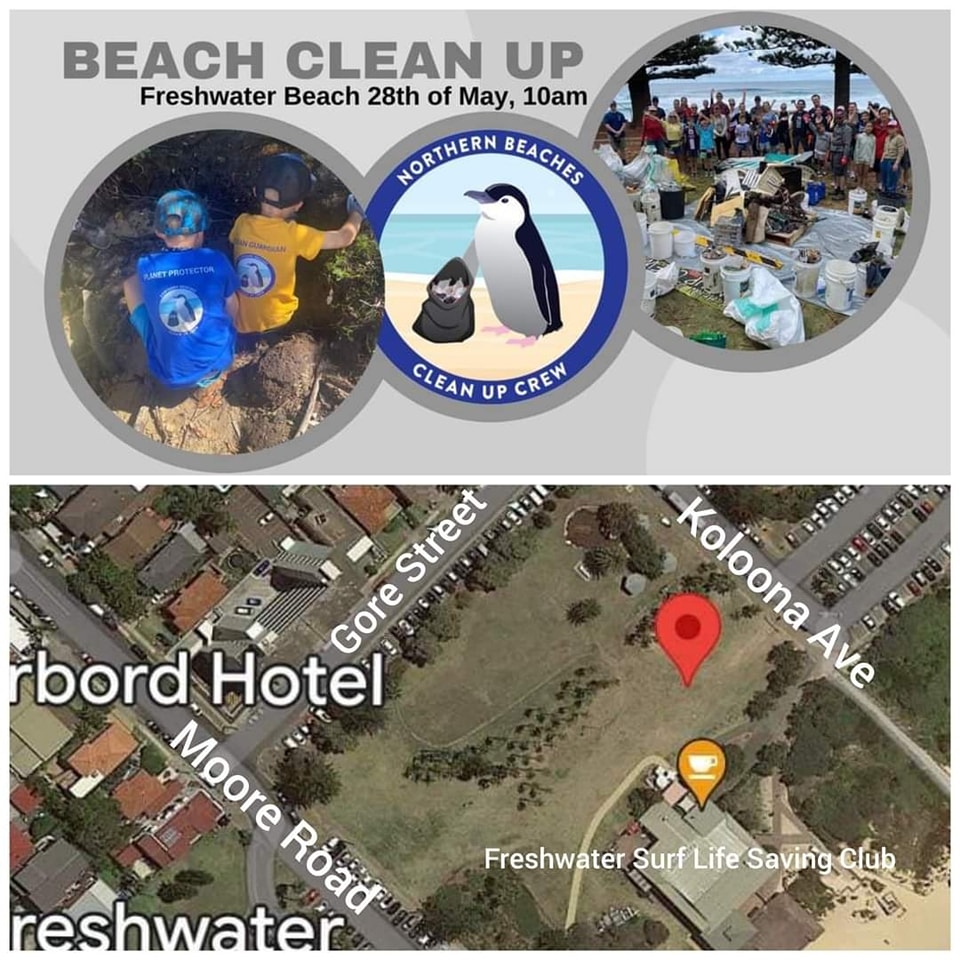
Permaculture NB: May To July 2023 Events
Permaculture Northern Beaches (PNB) is an active local group on Sydney's Northern Beaches working for ecological integrity and assisting you on a pathway to sustainability.
PNB holds monthly permaculture-related public meetings on the last Thursday of each month at the Narrabeen Tramshed Community & Arts Centre, Lakeview Room, 1395A Pittwater Road, Narrabeen. Buses stop directly at the centre and there is also car parking nearby. Doors open at 7:15 pm and meetings take place monthly from February to November.
Everyone is welcome!
We also hold a range of workshops, short courses, film and soup nights, practical garden tours, permabees (working bees), beehive installations, eco-product making sessions and much more.
KOORI KINNECTIONS
Thursday, May 25, 2023: 7:30pm – 9:00pm
Narrabeen Tramshed Arts and Community Centre, Lakeview Room
1395A Pittwater Road, Narrabeen
Join us for a night of education and connection, as we come together to learn about and celebrate the richness of Aboriginal culture.
This community gathering is an opportunity to deepen your understanding of connection to country and the diverse culture of Australia's First Peoples, and explore ways to work towards reconciliation and respect. Koori Kinnection Facilitator, Trent Kelly is a Yuin and Wailwan man, born and raised on Darawal country. Trent draws his cultural knowledge from his family, community and lived experience as a first nations person of this country.
Koori Kinnections runs educational programs for people of all ages: from bush food classes to school incursions, guided bush walks, resource talks, weaving workshops, and more. It is a 100% Aboriginal-owned and employed company.
Koori Kinnections: https://www.koorikinnections.com/
WORLD OCEANS DAY - BIG BLUE FUTURE
Thursday, June 8, 2023
World Oceans Day is held every year on 8th June to raise awareness of the vital importance of our oceans and the role they play in sustaining a healthy planet. A global celebration, it looks to bring people and organisations together across the globe in a series of events highlighting how we can all help protect and conserve the oceans.
Our ocean needs protection. Our ocean covers 70% of the planet and supports life as we know it. Every second breath we take comes from the ocean. Our ocean feeds billions of people. Our ocean hosts 80% of the world’s biodiversity.
However, our oceans are in crisis. They are being threatened by pollution such as abandoned fishing nets, overfishing, bycatch, and the effects of climate change.
We know the problems. We know the solutions.
World Oceans Day is a day to take action and raise awareness.
The 2023 theme for World Ocean Day is Big Blue Future.
To conserve our wonderful marine resources for future generations. Get involved in the conversation with #WorldOceansDay and #BigBlueFuture.
CELEBRATING WORLD OCEANS DAY
Thursday, June 29, 2023: 7:30pm – 9:00pm
Narrabeen Tramshed Arts and Community Centre, Lakeview Room
1395A Pittwater Road, Narrabeen
Join us in World Oceans’ month to learn more about the Blue planet we live on.
Two great speakers will tell us the wonders and threats facing our oceans.
Australia Marine Conservation Society works on the big issues that risk our ocean wildlife - protecting critical ocean ecosystems with marine reserves around the nation, including Ningaloo and the Great Barrier Reef. As well as issues such as over-fishing and supertrawlers, and protecting threatened and endangered species like the Australian Sea Lion.
Surfrider Foundation is actively working to stop drilling and exploration for oil and gas off our coast (PEP2). The organisation works to protect our oceans, beaches and waves through a powerful activist network.
$5 entry by donation to pay for room hire. Organic teas and coffee are available at the night + swap table - bring plants, seeds, food, books and permaculture items to swap and share.
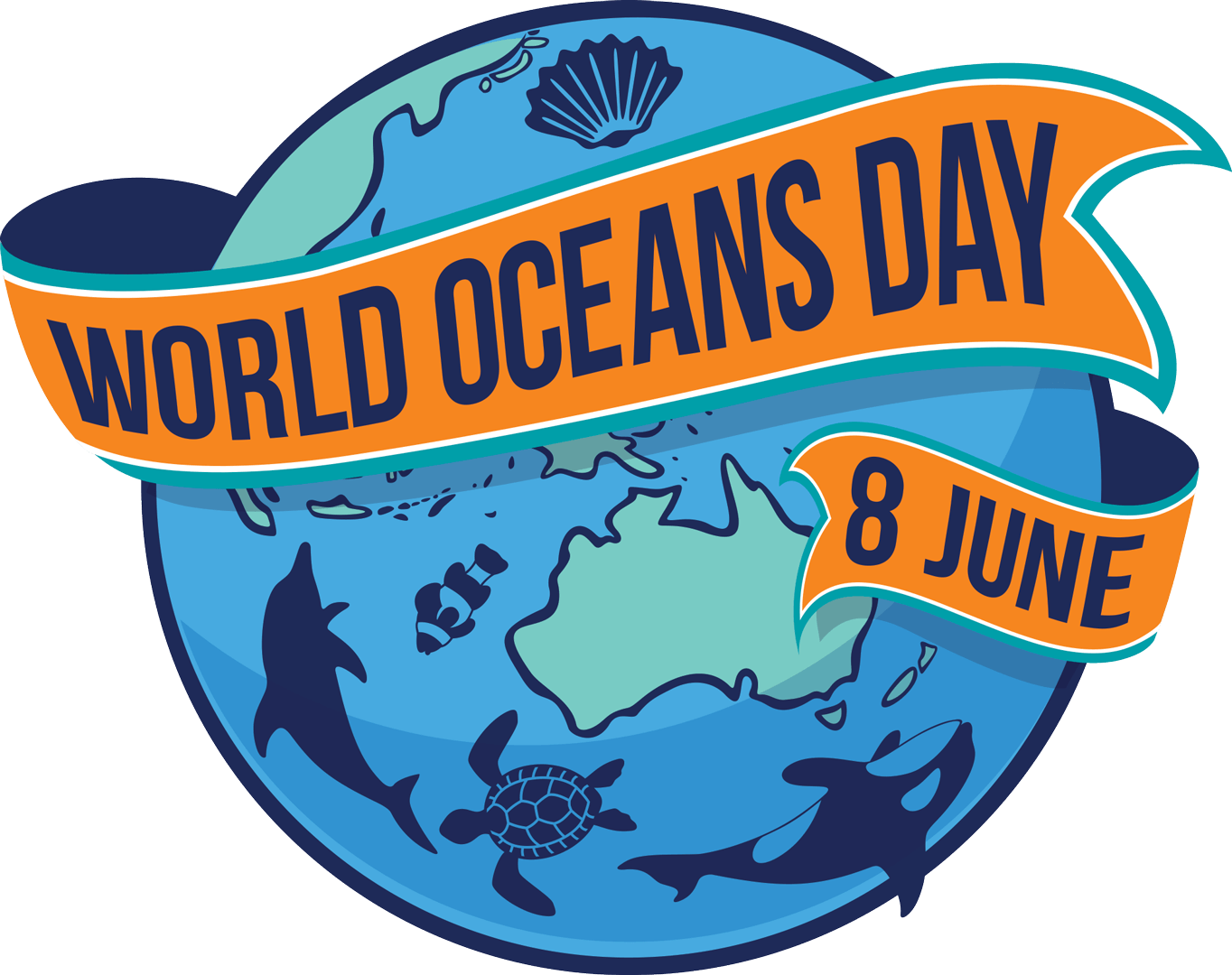
SEED SAVING CIRCLE
Saturday, July 8, 2023: 11:00am – 1:00pm
Balgowlah Community Garden
100 Griffiths Street, Balgowlah
Gather your seeds in winter for the coming spring. Share and swap seeds that are grown organically and locally. These seeds will be the best adapted you can find for the Northern Beaches climate and soils as many have been grown over generations.
Tap into the knowledge and the databank of seeds at Balgowlah Community Garden and PNB + share permaculture knowledge. This is an invaluable resource for the local community. Be part of the change - grow your own seeds and food.
Bring your non-alcoholic drinks and food to share on the day. The seed circle will be outdoors but under cover so dress weather-wise.
PLASTIC FREE JULY
Saturday, July 1, 2023 – Monday, July 31, 2023
Permaculture Northern Beaches is a part of the Plastic Free July challenge - Join Us!
The plastic bottles, bags and takeaway containers that we use for just a few minutes use a material that is designed to last forever. Every bit of plastic ever made still exists!
These plastics:
- Break up, not break down – becoming permanent pollution
- Are mostly made into low-grade products for just one more use or sent to a landfill
- End up in waterways and the ocean – where scientists predict there will be more tons of plastic than tons of fish by 2050
- Transfer to the food chain – carrying pollutants with them
- Increase our eco-footprint – plastic manufacturing consumes 6% of the world’s fossil fuels
Be part of the solution, by taking up these habits:
- Refusing plastic bags and packaging (choose your own alternatives)
- Reducing packaging where possible (opt for refills, remember your reusable shopping bags)
- Refusing plastics that escape as litter (e.g. straws, takeaway cups, utensils, balloons)
- Recycling what cannot be avoided by the use of alternatives.
Register to join 100,000 Australians and a million+ people worldwide stepping up in Plastic Free July www.plasticfreejuly.org
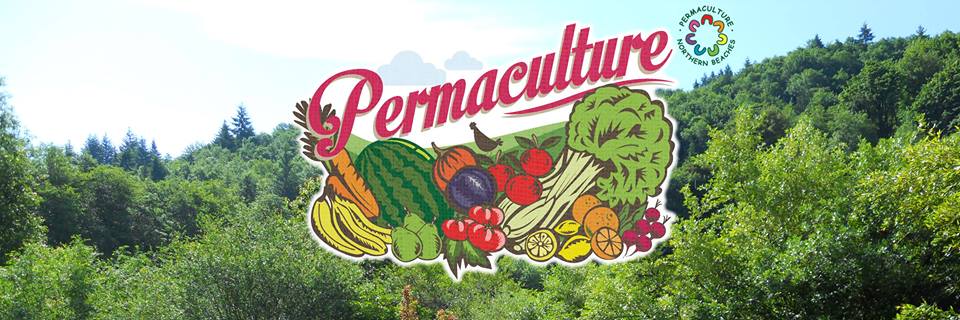
PNHA Guided Nature Walks 2023
Our walks are gentle strolls, enjoying and learning about the bush rather than aiming for destinations. Wear enclosed shoes. We welcome interested children over about 8 years old with carers. All Welcome.
Sunday June 25: Birdwatching and Bushland along Mullet Creek in Ingleside Chase Reserve
Swamp forest and coastal wetlands are rich habitat for fauna such as Swamp Wallaby and Diamond Python. Over 150 bird species have been recorded for the area. Red-Browed Finch is one.
Bring your binoculars and keep your ears pricked for bird calls. The track is mostly level, but with an optional steep climb near the Irrawong waterfall.
Meet: 8.30am near 31 Irrawong Rd North Narrabeen. Ends about 10.30.
So we know you’re coming please book by emailing: pnhainfo@gmail.com and include your phone number so we can contact you if weather is doubtful.
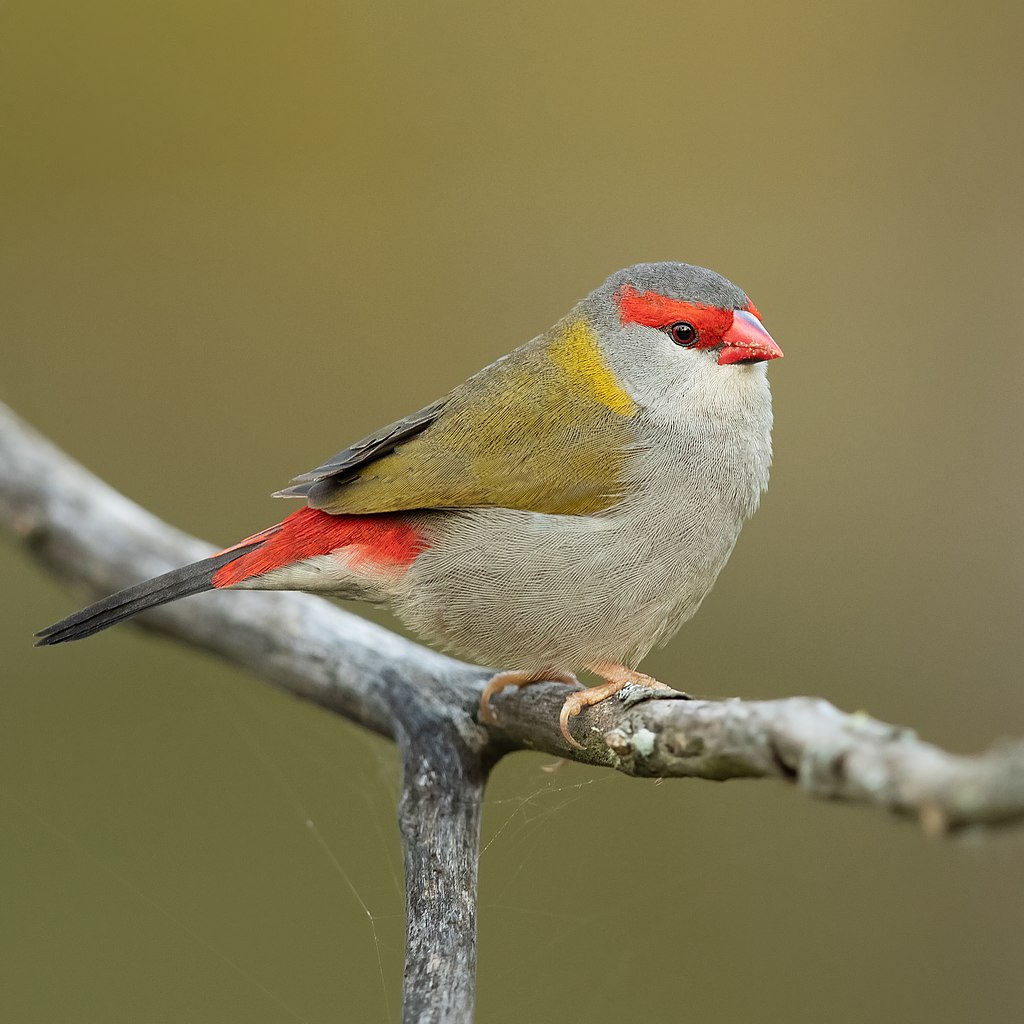
Red-browed finch (Neochmia temporalis). Photo: J J Harrison
Chemical CleanOut: June 2023
Mona Vale Beach Car Park: Sat 24, Sun 25 June 2023 - 9am-3:30pm
Surfview Road, Mona Vale
Only household quantities accepted. Maximum container size of 20kg or 20L per item.
*Up to 100L of paint (in 20L containers) now accepted at all Sydney, Hunter and Illawarra events.
Accepted:
Fluoro globes and tubes, Gas bottles and fire extinguishers, Household cleaners, Batteries, Paint*, Oils, Garden chemicals, Poisons, Smoke detectors.
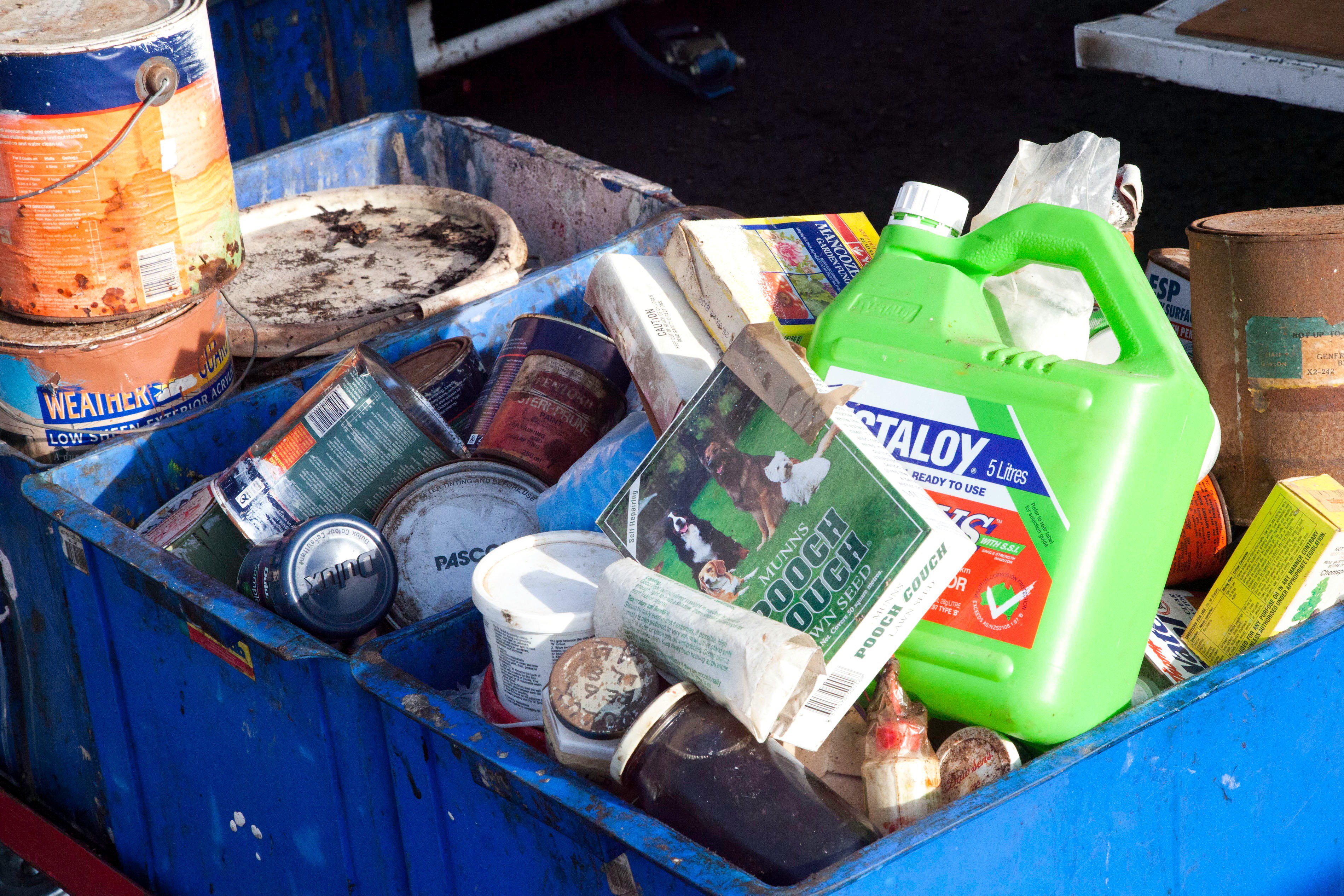
Bushcare In Pittwater
Where we work Which day What time
Avalon
Angophora Reserve 3rd Sunday 8:30 - 11:30am
Avalon Dunes 1st Sunday 8:30 - 11:30am
Avalon Golf Course 2nd Wednesday 3 - 5:30pm
Careel Creek 4th Saturday 8:30 - 11:30am
Toongari Reserve 3rd Saturday 9 - 12noon (8 - 11am in summer)
Bangalley Headland 2nd Sunday 9 to 12noon
Bayview
Winnererremy Bay 4th Sunday 9 to 12noon
Bilgola
North Bilgola Beach 3rd Monday 9 - 12noon
Algona Reserve 1st Saturday 9 - 12noon
Plateau Park 1st Friday 8:30 - 11:30am
Church Point
Browns Bay Reserve 1st Tuesday 9 - 12noon
McCarrs Creek Reserve Contact Bushcare Officer To be confirmed
Clareville
Old Wharf Reserve 3rd Saturday 8 - 11am
Elanora
Kundibah Reserve 4th Sunday 8:30 - 11:30am
Mona Vale
Mona Vale Beach Basin 1st Saturday 8 - 11am
Mona Vale Dunes 2nd Saturday +3rd Thursday 8:30 - 11:30am
Newport
Bungan Beach 4th Sunday 9 - 12noon
Crescent Reserve 3rd Sunday 9 - 12noon
North Newport Beach 4th Saturday 8:30 - 11:30am
Porter Reserve 2nd Saturday 8 - 11am
North Narrabeen
Irrawong Reserve 2nd Saturday 2 - 5pm
Palm Beach
North Palm Beach Dunes 3rd Saturday 9 - 12noon
Scotland Island
Catherine Park 2nd Sunday 10 - 12:30pm
Elizabeth Park 1st Saturday 9 - 12noon
Pathilda Reserve 3rd Saturday 9 - 12noon
Warriewood
Warriewood Wetlands 1st Sunday 8:30 - 11:30am
Whale Beach
Norma Park 1st Friday 9 - 12noon
Western Foreshores
Coopers Point, Elvina Bay 2nd Sunday 10 - 1pm
Rocky Point, Elvina Bay 1st Monday 9 - 12noon
Friends Of Narrabeen Lagoon Catchment Activities

Gardens And Environment Groups And Organisations In Pittwater
Report Fox Sightings
%20(1).jpg?timestamp=1675893929686)
Weed Of The Season: Cassia - Please Pull Out And Save Our Bush
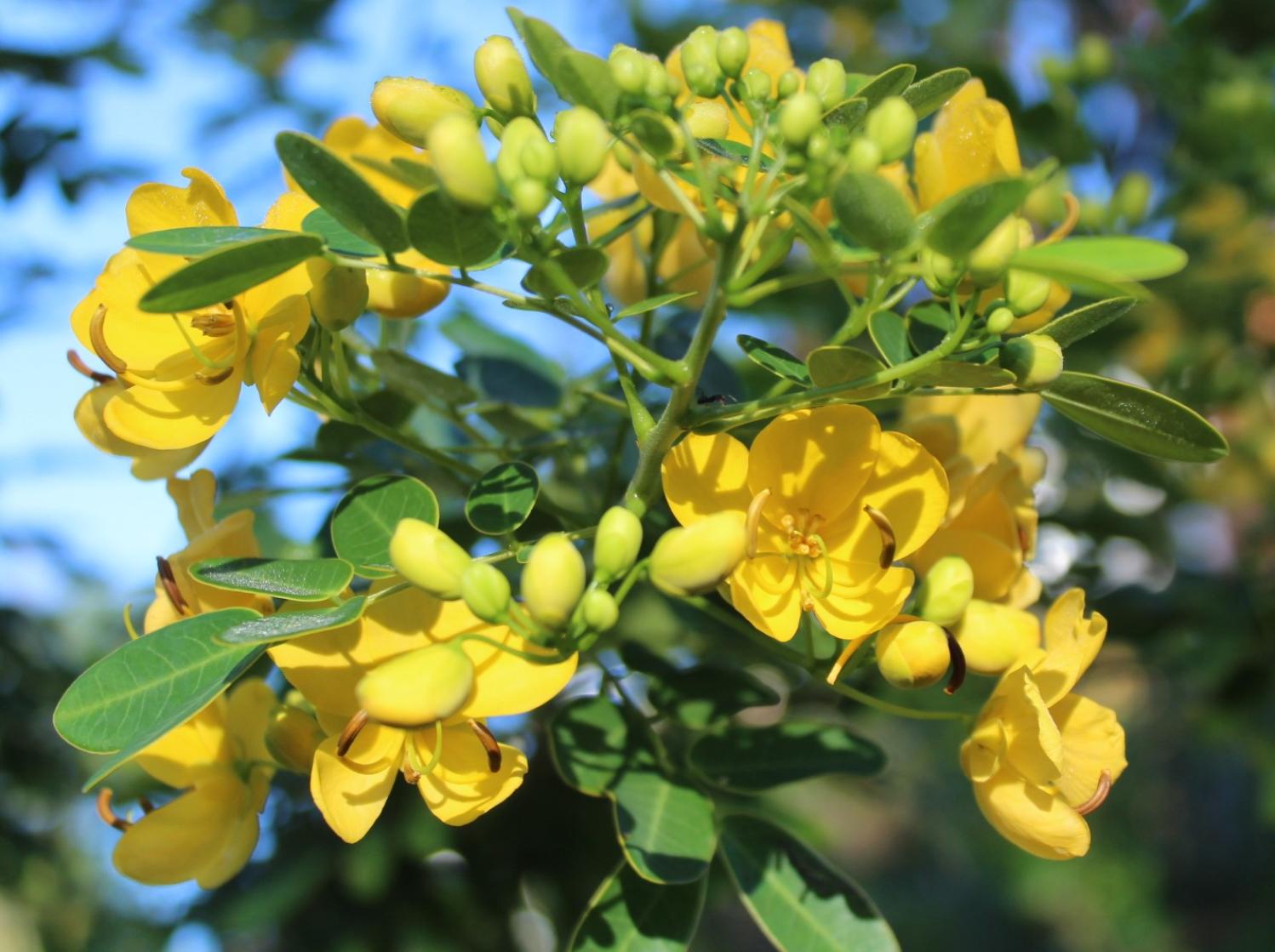
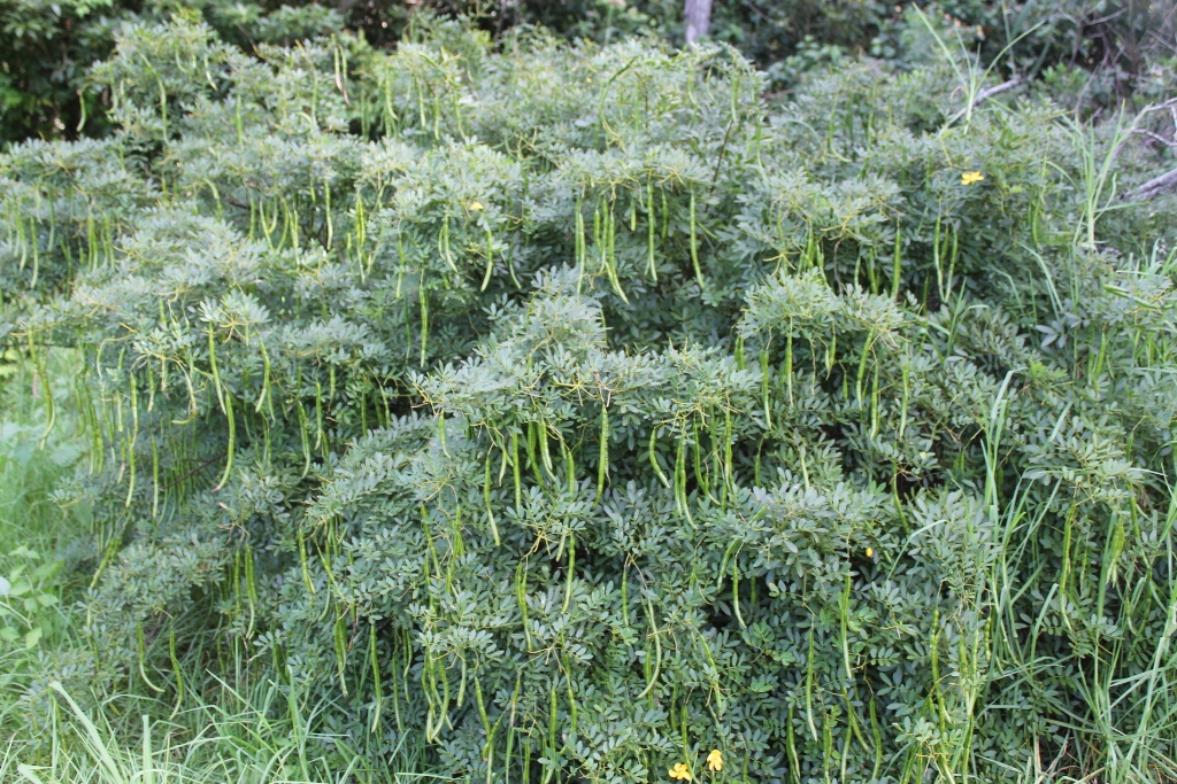
New Marine Wildlife Rescue Group On The Central Coast
A new wildlife group was launched on the Central Coast on Saturday, December 10, 2022.
Marine Wildlife Rescue Central Coast (MWRCC) had its official launch at The Entrance Boat Shed at 10am.
The group comprises current and former members of ASTR, ORRCA, Sea Shepherd, Greenpeace, WIRES and Wildlife ARC, as well as vets, academics, and people from all walks of life.
Well known marine wildlife advocate and activist Cathy Gilmore is spearheading the organisation.
“We believe that it is time the Central Coast looked after its own marine wildlife, and not be under the control or directed by groups that aren’t based locally,” Gilmore said.
“We have the local knowledge and are set up to respond and help injured animals more quickly.
“This also means that donations and money fundraised will go directly into helping our local marine creatures, and not get tied up elsewhere in the state.”
The organisation plans to have rehabilitation facilities and rescue kits placed in strategic locations around the region.
MWRCC will also be in touch with Indigenous groups to learn the traditional importance of the local marine environment and its inhabitants.
“We want to work with these groups and share knowledge between us,” Gilmore said.
“This is an opportunity to help save and protect our local marine wildlife, so if you have passion and commitment, then you are more than welcome to join us.”
Marine Wildlife Rescue Central Coast has a Facebook page where you may contact members. Visit: https://www.facebook.com/profile.php?id=100076317431064
- Ph: 0478 439 965
- Email: marinewildlifecc@gmail.com
- Instagram: marinewildliferescuecc

Watch Out - Shorebirds About
.JPG.opt1460x973o0,0s1460x973.jpg?timestamp=1663629195339)
Possums In Your Roof?: Do The Right Thing

Aviaries + Possum Release Sites Needed

NSW Reconstruction Authority Regulation: Have Your Say
- to prescribe actions in relation to which the NSW Reconstruction Authority may direct relevant entities
- to require relevant entities and the NSW Reconstruction Authority to have regard to the State disaster mitigation plan and any relevant disaster adaptation plan in exercising prescribed functions
- to prescribe exceptional circumstances in which the Minister may authorise the undertaking of development without consent or assessment under the Environmental Planning and Assessment Act 1979
- to provide for the determination and payment of fees under the NSW Reconstruction Authority Act 2022launch.
Draft Bush Fire Risk Plan: North Shore
The Mosman/ North Sydney/ Willoughby Bush Fire Management Committee is seeking feedback on a draft Bush Fire Risk Management Plan (BFRMP).
A Bush Fire Risk Management Plan (BFRMP) is a document that maps and describes the level of bush fire risk across an area and sets out treatment strategies to reduce the risk of bush fires and better protect the community over 5 years.
Download the draft Bush Fire Risk Management Plan for Mosman/North Sydney/Willoughby at:
The Mosman/ North Sydney/ Willoughby Bush Fire Management Committee, consisting of fire agencies, land managers and other stakeholders, have been working to identify ways of reducing the impact of fires on this area – protecting lives, homes, businesses, the environment, cultural values and other assets that are important to the communities within these Local Government Areas.
Your input is important – and by planning together, we will help shape the Bush Fire Risk Management Plan for this area for the next 5 years.
Your comments are invited on the draft Mosman/ North Sydney/ Willoughby Bush Fire Risk Management Plan. You can view the plan online or at your local Council.
Have your say
Have Your Say by 5pm 30th June 2023
There are three ways to submit your feedback, listed below.
- Provide your feedback online by visiting the Mosman/ North Sydney/ Willoughby Bush Fire Risk Management Plan website: https://www.rfs.nsw.gov.au/plan-and-prepare/managing-bush-fire-risk/bush-fire-management-committees/mosman-north-sydney-willoughby
- Email: me2admin@fire.nsw.gov.au
- Formal submission: Address: Executive Officer, Mosman North Sydney Willoughby BFMC, 99 Shirley Road, Crows Nest NSW 2065
Getting The Scoop On The Pelican Travel Brief: Please Report Any Pelicans With Bands
May 9, 2023
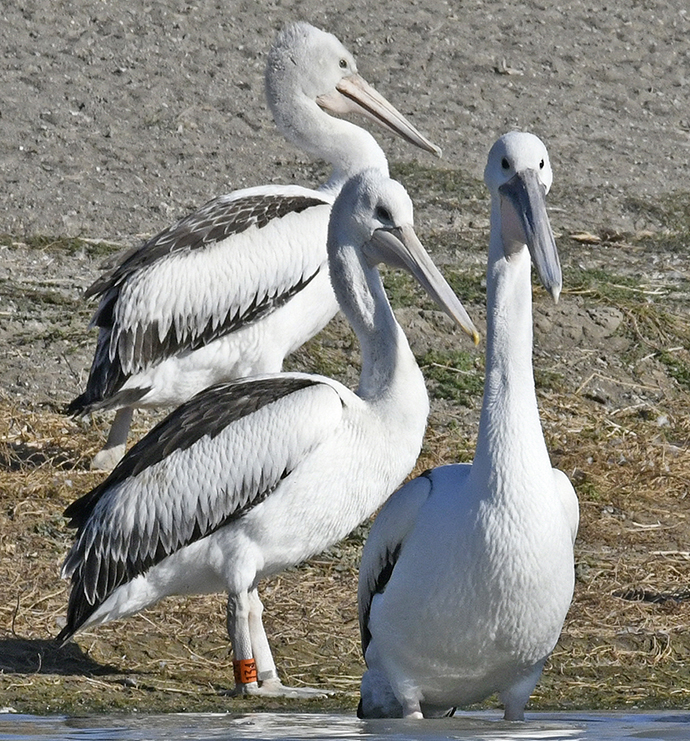 Scientists hope the secret lives of Australian Pelicans will be revealed in more detail thanks to a project tracking the travel habits of these majestic birds. More than 1,200 birds across three locations have so far been fitted with brightly coloured leg bands which show where the pelican hatched.
Scientists hope the secret lives of Australian Pelicans will be revealed in more detail thanks to a project tracking the travel habits of these majestic birds. More than 1,200 birds across three locations have so far been fitted with brightly coloured leg bands which show where the pelican hatched.
Scientists from the Department of Planning and Environment (DPE) are now calling on the public to log any sightings of the banded birds to help build a picture of their movements.
"Once pelican chicks fledge, they take to the skies but where they choose to go and nest is critical data we are keen to collect," said senior scientist Dr John Porter.
"We can use this information to make decisions on wetland and water management for sites favoured by the pelicans and to find out if pelicans prefer to return to where they hatched to breed."
Almost 400 birds were banded at Narran Lake in late March and bird watchers should look out for pelicans returning to coastal regions from May.
The pelican banding project has been running since 2017, with Narran Lake added for the first time this year.
Narran Lake birds will sport a numbered black band. Blue bands indicate the pelican hatched in the Gayini Wetlands while birds from Lake Brewster have orange leg bands.
Victorian pelican nesting sites use red and green leg bands.
The pelican research includes the University of NSW, WaterNSW and the Lake Cowal Foundation as project partners. The Nari Nari Tribal Council who manage Gayini Wetlands and a private property owner at Narran Lake have generously allowed access to breeding pelicans.
Fully grown pelicans have a wingspan of around 2.5 metres which means they can travel considerable distances. One adventurous Lake Brewster banded bird has been spotted 650 kilometres away in St George, Queensland, while two Lake Brewster banded birds recently arrived at the Narran Lake colony. Narran Lake is 400km from Lake Brewster.
UNSW Sydney Centre for Ecosystem Science, Senior Research Fellow, Dr Kate Brandis, said learning where juvenile pelicans travel to once they fledge is important in understanding which wetlands they use, to help us better manage the species and wetlands.
"In the case of the Narran Lake colony, until this year pelicans had not bred at the Lake since the 1990s as there had not been sufficient flooding to support them for the 6 months needed to successfully raise chicks.
"If we find pelicans do return to their hatching place to breed, maintaining suitable habitat at Narran Lake for this cohort to return to in a few years' time is essential to helping support Australian Pelicans into the future," Dr Brandis said.
To report a banded pelican sighting, email peli.bands@environment.nsw.gov.au, including location, band number, condition of the bird, behaviour and a photograph if possible.
Photo: NSW Dept. of Environment
Dungowan Dam Project Will Not Proceed
May 10, 2023
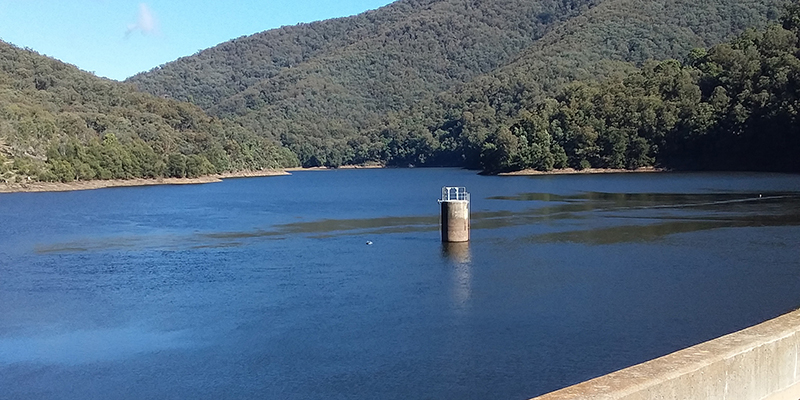 Following the Federal Government’s decision last night to withdraw funding the NSW Government will not proceed with the Dungowan Dam project.
Following the Federal Government’s decision last night to withdraw funding the NSW Government will not proceed with the Dungowan Dam project.
This follows advice from various experts and agencies, including Infrastructure NSW, that the Dungowan Dam project should not proceed.
Minister for Water Rose Jackson said the move will save NSW taxpayers $632 million and would enable the NSW Government to look at more affordable and effective water security options for the region.
In the coming weeks, the NSW Government will be releasing the final Namoi Water Strategy which will outline the path forward and plan to improve water security in the region.
“We know there is a major water security issue in this region and we are committed to addressing it but at the end of the day the numbers didn’t stack up,” Minister Rose Jackson said.
“Both Infrastructure NSW and Infrastructure Australia had serious concerns about the cost-benefit ratio of the new Dungowan Dam and did not recommend putting this project on the infrastructure priority list, and now the Australian Government has pulled funding for the project.
“On top of this, I have always had serious concerns about the viability of the project because it would take 10 years to build and fill the new dam, putting the region’s shorter term water security at serious risk.
“It is going to take more than just a new dam to solve the water security issues for Tamworth. It is why I am now receiving briefings from my department on a range of infrastructure and non-infrastructure options that could be implemented within a shorter timeframe.
“In coming weeks, I will be publishing the final version of the Namoi Regional Water Strategy that puts forward a shortlist of options that will boost drought resilience for Tamworth.
“But I want to be clear that any projects we support must be affordable and effective and are not increase the divide between agriculture and the environment.
Some of these options including advanced water treatment plants, purified recycled water facilities along with water efficiency and demand management options to make existing water supplies go further.
The other ideas on the table include intervalley pipelines from the west of Tamworth between Keepit Dam or Split Rock Dam and from the east of Tamworth from the Manning Valley. There are also off-river storages and better use of the reserve in Chaffey Dam in the mix.
“We need to investigate every option and whatever decisions we make will be based on evidence, including state-of-the-art climate science, so Tamworth is in a stronger position to manage water in a drier climate.” Ms Jackson said.
The NSW and Australian Government’s funding for stage one of the pipeline has not been impacted by the Federal Budget. The pipeline is due for completion mid-2023.
Builders Urged To Contain Site Litter And Construction Waste
With the construction industry generating more than 12 million tonnes of waste per annum, this year’s Get the Site Right campaign is reminding builders and developers that they have a critical role to play in reducing environmental impacts on waterways in NSW.
Figures released by the Australian Bureau of Statistics show that in 2020 construction activities generated the second largest amount of solid waste in Australia, behind manufacturing.1
While much of this waste is produced by construction and demolition activities, a considerable amount comes from building supply packaging materials and food and drink containers.
NSW Environment Protection Authority (EPA) A/Executive Director Regulatory Operations Arminda Ryan said poorly managed construction waste can have serious environmental impacts.
“Incorrectly contained waste can be blown or washed off sites, blocking stormwater infrastructure and impacting our creeks, rivers and harbours,” Ms. Ryan said.
“Plastic litter, soil and other waste carried off building sites can cause harm to aquatic life, contribute to flooding and algal growth and increase human health risks in foreshore areas.
“Correctly disposing of litter and waste and putting robust erosion and sediment controls in place not only prevents these risks but is a vital way to meet the NSW EPA’s litter reduction targets2.”
Parramatta River Catchment Group Chair, Cr Mark Drury, said that the plan to open four more swimming and recreational sites on the Parramatta River over the next few years was dependent on continued efforts to improve water quality.
“In addition to sediment runoff, litter from building sites that enters local waterways can impede our ability to achieve a clean, safe and swimmable river,” Cr Drury said.
“Get the Site Right remains an important part of our ongoing strategy to manage the environmental impacts of construction on waterway health.
“The construction industry has an important role to play in reducing the amount of litter and waste generated on sites and protecting waterways by adopting sustainable resources and building practices.”
Builders and developers are required to correctly contain and dispose of litter and other waste as part of a waste management plan for their site, in addition to their comprehensive erosion and sediment control plans.
Failing to put these protections in place can attract fines ranging from $8,000 to $15,000 per offence under the Protection of the Environment Operations Act 1997 or the Environmental Planning and Assessment Act 1979.
Get the Site Right is a joint taskforce between the Cooks River Alliance, Georges Riverkeeper, Parramatta River Catchment Group, Sydney Coastal Councils Group, local councils, Department of Planning and Environment (DPE), NSW Environment Protection Authority (EPA), and WaterNSW.
The campaign will run throughout May with more than 20 councils participating in a one-day inspection blitz of construction sites on Thursday, 18 May 2023. A follow-up inspection blitz week will be held in October 2023.
Members of the public are encouraged to report pollution incidents, including poor sediment control, to their local council or the EPA’s 24-hour Environment Line on 131 555.
1https://www.abs.gov.au/statistics/environment/environmental-management/waste-account-australia-experimental-estimates/latest-release
2 https://www.dpie.nsw.gov.au/our-work/environment-energy-and-science/plastics-action-plan
EPA Issues Tougher Licence For Metropolitan Collieries
May 9, 2023
Metropolitan Collieries has been ordered to overhaul their operations after the NSW Environment Protection Authority (EPA) revised the mine’s licence imposing a suite of strict operating conditions.
The licence has been scrutinised since November 2022, after being bought forward for review in response to multiple alleged non-compliances resulting in significant pollution events at Camp Gully Creek.
The tougher licence conditions will require rigorous monitoring, real-time water quality testing and a water impact discharge assessment.
NSW EPA CEO, Tony Chappel said the EPA expects Metropolitan Collieries to have strong environmental practices and operational inadequacies resulting in pollution will not be tolerated.
“The revised licence requires them to take immediate action to change their operations to reflect best practice,” Mr Chappel said.
“Pollution events by any operator, particularly those in fragile environments, put unique wildlife and habitats at risk”.
“The Royal National Park is one of Sydney’s most pristine natural environments and we are requiring the mine to take immediate actions to protect the park.
“I want to thank the community who have been vocal and provided extensive feedback during the licence review. More than 200 submissions have informed these licence changes.
“Everyone in the community will now have access to real-time water quality data, both down and upstream of Camp Gully Creek, and results from extensive water monitoring including testing for chemicals.
“As we collect more information through enhanced monitoring, we will not hesitate to make more changes to ensure the park is protected for generations to come.”
The EPA is still investigating the 2022 major incidents but has issued Metropolitan Collieries with two penalty notices, imposing fines totalling $30,000 for a separate alleged water incident in November 2022.
To view the licence variations, visit the EPA’s website
Rising River Alert – Snowy River Below Jindabyne Dam
May 11, 2023
The NSW Department of Planning and Environment today issued a rising river alert for the Snowy River downstream of Jindabyne Dam in southern NSW for Thursday 18 May 2023.
The river will rise due to the first high-flow event in a series of eight planned environmental releases from Jindabyne Dam to the Snowy River during 2023.
The highest flow release rate for this event will occur at Jindabyne Dam from 8am to 4pm on Thursday 18 May and will be equivalent to 8,864 megalitres per day for the eight-hour period.
It is expected to see the river level at Dalgety rise by approximately 0.9 metres. These levels do not include the effect of rainfall or wet conditions in the catchment, which may increase flow rates and water depths.
For the remainder of Thursday 18 May, the flow rate from Jindabyne Dam will be 3,068 megalitres per day. The flow rate from Jindabyne Dam will drop to a target of 2,039 megalitres per day on Friday 19 May.
The environmental benefits from this release are expected to be greatest between the dam wall and the junction with the Delegate River. However, the flow pulse will be noticeable well down into Victoria.
Water released from Jindabyne Dam at this flow rate may take several hours to reach Dalgety Weir and around 3 to 4 days to reach at Orbost in Victoria, subject to catchment conditions.
Landholders downstream of the Jindabyne Dam are advised to take all necessary precautions with stock, fencing and property in proximity to the river. As the release flows through the system, people should refrain from entering or crossing swollen waterways.
Conditions will be closely monitored in the lead up to the release. It may be necessary to modify or cancel flows in the lead up to the event due to environmental, climatic or operational conditions, and an announcement will be made accordingly.
The Department will work with the NSW State Emergency Service and the Bureau of Meteorology to provide information to the community regarding the management of this release, should weather conditions warrant.
More information can be found at Increased flows.
Plumwood Mountain Added To NSW State Heritage Register
May 11, 2023
Plumwood Mountain, the remote 120-hectare bush property where Australia's most prominent environmental philosopher Dr Val Plumwood resided and worked, has been listed on the NSW State Heritage Register.
Executive Director of Heritage NSW, Sam Kidman, said Dr Plumwood was a key figure in the emergence of the Australian environmental movement, right here in New South Wales.
“Dr Plumwood made a major contribution to the development of the Australian environmental movement, in the realm of environmental humanism, during the mid-1970s.
“The Plumwood Mountain residence was where Dr Plumwood composed her pioneering scholarly works between 1975 and 2008, and was a key location where environmentalists, scholars, and protesters congregated to rally, talk through, and plan,” said Mr Kidman.
Deputy Chair for the Heritage Council of NSW, The Hon Robyn Parker, said the property protects an untouched, ancient rainforest, home to a variety of plants and animals, including the ancient and uncommon plumwood tree.
“Dr Plumwood’s quirky, off-the-grid octagonal stone home looks a bit like a 50-cent coin.
“It was designed by Dr Plumwood and co-built in 1976 with her then partner, environmentalist and philosopher Dr Richard Sylvan,” Ms Parker said.
Today, Plumwood Inc. manages the property, stone building and personal collection of Dr Plumwood.
Dr Lara Stevens, Treasurer, Plumwood Mountain Committee, who put forward this nomination, wanted recognition of the site’s environmental significance.
“The Plumwood Committee welcomes this listing as a testament to the legacy of Dr Val Plumwood for her pioneering work as an ecofeminist philosopher, environmental activist and an affirmation of the extraordinary forest home that inspired her thinking,” said Dr Stevens.
Listing Plumwood on the State Heritage Register is an important step in preserving the history and culture of New South Wales. Not only does it protect the significance of the place and its associated stories, but it provides a platform for local communities to share and celebrate their cultural heritage.
The NSW Government is proud to be protecting our past and creating a legacy for future generations. More information can be found on the Heritage NSW website.
Val Plumwood
Val Plumwood (11 August 1939 – 29 February 2008) was an Australian philosopher and ecofeminist known for her work on anthropocentrism. From the 1970s she played a central role in the development of radical ecosophy. Working mostly as an independent scholar, she held positions at the University of Tasmania, North Carolina State University, the University of Montana, and the University of Sydney, and at the time of her death was Australian Research Council Fellow at the Australian National University. She is included in Routledge's Fifty Key Thinkers on the Environment (2001).
Plumwood spent her academic life arguing against the "hyperseparation" of humans from the rest of nature and what she called the "standpoint of mastery"; a reason/nature dualism in which the natural world—including women, indigenous people, and non-humans—is subordinated.
Between 1972 and 2012, she authored or co-authored four books and over 100 papers on logic, metaphysics, the environment, and ecofeminism. Her Feminism and the Mastery of Nature (1993) is regarded as a classic, and her Environmental Culture: The Ecological Crisis of Reason (2002) was said to have marked her as "one of the most brilliant environmental thinkers of our time". The Fight for the Forests (1973), co-authored with the philosopher Richard Sylvan, Plumwood's second husband, was described in 2014 as the most comprehensive analysis of Australian forestry to date.
Plumwood's posthumously published The Eye of the Crocodile (2012) emerged from her survival of a saltwater crocodile attack in 1985, first described in her essay "Being Prey" (1996). The experience offered her a glimpse of the world "from the outside", a "Heraclitean universe" in which she was food like any other creature. It was a world that was indifferent to her and would continue without her, where "being in your body is—like having a volume out from the library, a volume subject to more or less instant recall by other borrowers—who rewrite the whole story when they get it".
Early life and education
Plumwood was born Val Morell to parents whose home was a shack with walls made of hessian sacks dipped in cement. After obtaining a land grant, her parents had set up home in Terrey Hills, near the Ku-ring-gai Chase National Park. Her father worked at first as a hod carrier, then started a small poultry farm. According to Martin Mulligan and Stuart Hill, the beauty of the area made up for Plumwood's lack of toys.
The poultry farm failed, and when she was ten the family moved to Collaroy, where her father found work in the civil service. They moved again to Kogarah in southern Sydney. Plumwood attended St George Girls High School in Kogarah, where she was dux of the school. Offered a Commonwealth Scholarship to attend the University of Sydney, she turned it down for a Teacher's Scholarship instead, also at Sydney—her parents wanted her to do something practical—although she soon became interested in philosophy.
Plumwood's studies were interrupted in 1958 by her brief marriage to a fellow student, John Macrae, when she was 18 and pregnant, a marriage that had ended in divorce by the time Plumwood was 21. The couple had two children, both of whom died young. Their son, John Macrae, was born when Plumwood was 19 and died in 1988 after an illness. Their daughter, Caitlin Macrae, born in 1960 and given up for adoption when she was 18 months old, was murdered in her teens. Plumwood resumed her studies at Sydney in 1962, this time with a Commonwealth Scholarship to study philosophy, and graduated with first-class honours in 1964.
Personal life and activism
Plumwood, fourth from the left, 2004, at the home she built with Richard Sylvan near Plumwood Mountain
Soon after commencing postgraduate studies in Logic at UNE in Armidale, Plumwood married the philosopher Richard Sylvan (then known as Richard Routley), whom she had met while in Sydney, and changed her name to Val Routley. They spent time travelling in the Middle East and UK, which included living near a beech forest in Scotland for a year. Returning to Australia, they became active in movements to preserve biodiversity and halt deforestation, and helped establish the trans-discipline known as ecological humanities. Referred to as Routley and Routley, from 1973 to 1982 they co-authored several notable papers on logic and the environment, becoming central figures in the debate about anthropocentrism or "human chauvinism". Together they wrote the influential book The Fight for the Forests (1973), which analysed the damaging policies of the forestry industry in Australia. The demand for the book saw three editions published in three years.
Commencing in 1975 the couple spent several years building their home near Plumwood Mountain on the coast, 75 km from Canberra, an octagonal stone house on a 120-hectare clearing in a rainforest. They divorced in 1981. Plumwood continued living in the house and changed her name again after the divorce, this time naming herself after the mountain, which in turn is named after the Eucryphia moorei tree. Routley changed his surname to Sylvan ("of the forest") when he remarried in 1983; he died in 1996.
At the time of her death, she was Australian Research Council Fellow at the Australian National University. She was found dead on 1 March 2008 in the house she had built with Sylvan; she is believed to have died the previous day, after suffering a stroke.
.jpg?timestamp=1683841635336)
Val Plumwood, Australian philosopher, in 1990. Photo: Sean Kenan; cropped and mark removed by SarahSV
If the budget ditched the Stage 3 tax cuts, Australia could save every threatened species – and lots more
Sarah Bekessy, RMIT University; Brendan Wintle, The University of Melbourne, and Rachel Morgain, The University of MelbourneThe Albanese government has made bold environmental promises over the last year. Given the parlous state of nature in Australia, these commitments are important.
The promises include ending new extinctions, fixing national nature laws and protecting 30% of our land and waters. Achieving these goals requires a lot of money. So how does last night’s federal budget stack up?
Our collective expertise spans biodiversity conservation science and policy. In our view, the budget takes very small steps towards making good on the many government’s promises, but falls well short of what is needed.
Australia’s threatened species and ecosystems will not survive more funding neglect. It’s time to question our national priorities, and start funding the environment that sustains us.
A Suite Of Big Promises
First, let’s take a closer look at what the federal government said, ahead of the budget, it would achieve for Australia’s environment.
The government has promised to prevent any further species from becoming extinct. In the words of the government’s own report, “the challenges to the existence of the plants and animals that define Australia are bigger than ever”.
It will also strengthen national nature laws, otherwise known as the Environment Protection and Biodiversity Conservation (EPBC) Act. It follows a scathing independent review of the act in 2020.
As part of those reforms, the government pledged to establish a new national environmental watchdog to enforce the law and decide on project approvals and conditions.
And the Australian government has also promised to protect 30% of land and water by 2030, as well as restore 30% of degraded ecosystems, as part of a United Nations agreement it signed last year. This includes pledges to create ten new Indigenous Protected Areas and double the number of Indigenous Rangers.
So how far does the federal budget go to achieving the government’s ambitious conservation agenda?
Getting Tough On Environmental Laws
The most promising budget announcement was A$121 million over four years to set up the new watchdog agency, to be known as Environment Protection Australia. A further $34 million will be spent on implementing national law reform and delivering a needed overhaul of conservation planning.
The new agency is sorely needed to address the national crisis of threatened species habitat loss in Australia. Research has found 93% of this destruction occurs without formal federal approval.
This is a good start, but the agency will need much greater funding, as well as independence, to function fearlessly as is intended. And it will only be effective if new environmental laws – currently being negotiated – give it the powers to prevent further biodiversity loss.
The budget also promises $51 million to create another new agency, Environment Information Australia. This body would provide high quality environmental data to support environmental regulation, planning and reporting.
This function is sorely needed to guide effective regulatory assessments and investments. There is also growing demand for biodiversity data for environmental accounting, business disclosures and the proposed Nature Repair Market.
However, the funding promised will only provide a basic data management and storage system. Far more is needed to fund the data collection necessary to fill the immense gaps in our biodiversity mapping and monitoring systems.
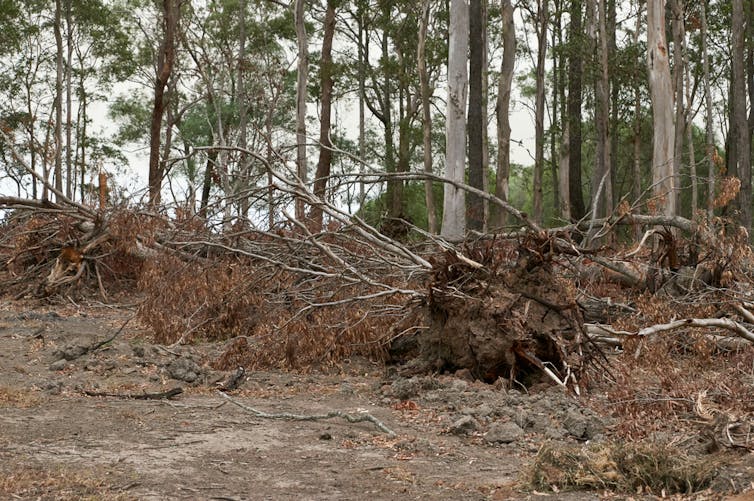
What Else For Nature?
The budget allocates $262 million over four years to Commonwealth national parks and marine reserves. A significant portion will be spent maintaining and upgrading infrastructure.
Effective protected area management needs stronger investment and active conservation, including management of invasive species and restoring degrading environments.
Many of Australia’s existing protected areas are badly damaged by feral pests such as weeds, foxes and feral cats, as well as inappropriate fire regimes and more. The budget commitment is tepid relative to the scale of these challenges.
Our current Commonwealth reserve system is already under-managed and many species and ecosystems are being neglected. It’s crucial that expanding the reserve system does not exacerbate these existing problems.
The lack of funding for Commonwealth reserves means Indigenous Protected Areas must take on an even greater share of the burden when it comes to improving biodiversity. However, this will require a dramatic increase in resourcing.
The budget includes significant commitments to climate action, funding for the Australian Institute of Marine Sciences, a review of the Murray Darling Basin Plan, and further investment to improve water quality flowing into the Great Barrier Reef. All of these should deliver some benefits for biodiversity.
The budget also contains $28 million to develop a much-needed national climate risk assessment, which includes risks to biodiversity. But a far greater investment will be needed to adapt to these risks.
And $439.2 million was committed over five years to support programs that repair World Heritage properties, restore Ramsar wetlands and conserve threatened species and habitats. This is a continuation of existing funding for natural resource management.
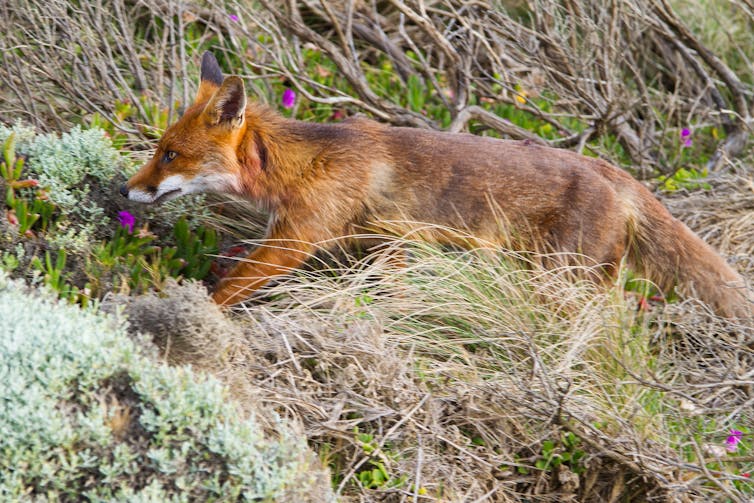
Getting Our Priorities Straight
Overall, the budget spending does not represent the substantial increase to existing funding needed to halt biodiversity declines or recover threatened species.
Research suggests Australia must spend $2 billion a year to save its 1,900 most-imperilled species. And an additional $2 billion a year for 30 years could also restore 13 million hectares of Australia’s degraded land.
Meanwhile, the cost of adequately conserving our World Heritage areas and Ramsar wetlands is not yet known.
In light of this, the federal government’s budget investment is way off the mark.
The federal government could have scrapped the Stage 3 tax cuts, and redeployed the many billions of dollars a year to conserving species and ecosystems and properly funding Indigenous Protected Areas and ranger groups.
If it did that, Australia could recover all its threatened species by 2030 and have plenty left over for meeting national commitments to protecting and restoring degraded lands, and ensuring Indigenous people have more of a say over how Country is managed.
We endorse the government’s plans to strengthen Australia’s environment protection laws. But it must increase, by an order of magnitude, spending on threatened species and damaged ecosystems.
This is not a trade-off between the environment and the economy. Roughly half our GDP relies on natural systems. And nature has enormous benefits for the health and wellbeing of people and communities.
We must seriously examine our national priorities, and demand that Australian governments invest our national wealth in the species and ecosystems we depend on.![]()
Sarah Bekessy, Professor in Sustainability and Urban Planning, Leader, Interdisciplinary Conservation Science Research Group (ICON Science), RMIT University; Brendan Wintle, Professor in Conservation Science, School of Ecosystem and Forest Science, The University of Melbourne, and Rachel Morgain, Senior Research Fellow, School of Ecosystem and Forest Sciences, The University of Melbourne
This article is republished from The Conversation under a Creative Commons license. Read the original article.
Tail first and making an early splash, some whales just can’t wait to be born
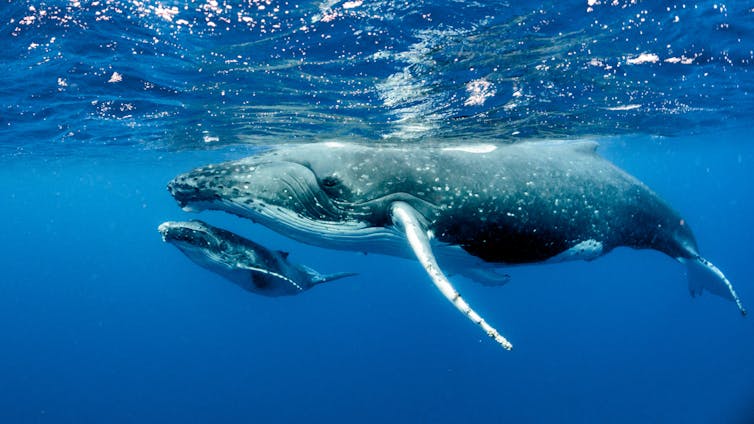
Did you know whales are born tail first? They enter their water world being able to swim from day dot. From the moment they’re born, their first instinct is to swim to the surface for air.
While most enjoy the comforts of hanging out in mum’s tummy until she reaches warm northern Australian waters, some just can’t wait to enter the big blue.
May marks the official start to the whale watching season and we’ve already had an exciting teaser with the recent sighting of a pygmy blue whale mother and calf in Western Australian waters.
While this sighting is rare, it’s not likely to be the last mother and calf whale sighting we’ll see this year. We’ll soon start seeing various whale species moving along the west and east coasts of Australia.
Why Are Whales Coming Here?
Generally speaking, whales migrate to Australian waters in the winter to breed.
Depending on where you are on the Australian coast, you’ll probably see at least the main migratory baleen (toothless) whale species.
These include the iconic humpback whale, the southern right whale, dwarf minke whale (east coast mainly) and possibly the pygmy blue whale (west coast).
The first three species typically migrate north to warmer waters to breed and calve. They’ve spent the summer feeding in Antarctic/Southern Ocean waters, putting on a lot of weight. Now, they’re ready to spend their energy going north to reproduce.
In contrast, pygmy blue whales typically stay in Australian waters over summer. They then travel along the west coast of Australia, past Perth into international waters such as the Banda Sea where they are thought to breed during the winter.
The Making Of A Whale Calf
Baleen whales are mammals just like you and me. A humpback whale is pregnant for 11-12 months. So female humpback whales that fell pregnant in Australian waters during the last breeding season are likely to give birth this year.
A female humpback whale may mate with multiple males. Males may sing and/or fight to mate with females. Males provide no parental care for their young.
A humpback whale mother may produce a calf every two to three years. This is a relatively quick turnaround and is likely one reason why Australian humpback whale numbers have been recovering well post-whaling.
The Ultimate Water Birth
Antarctic waters are too cold for a newborn calf. This is one reason why humpback whales travel to warmer water to breed.
Whales rely on a lot of blubber to keep them warm. Newborn calves are born with very little body insulation, so warm Australian waters are an ideal environment to be born into.
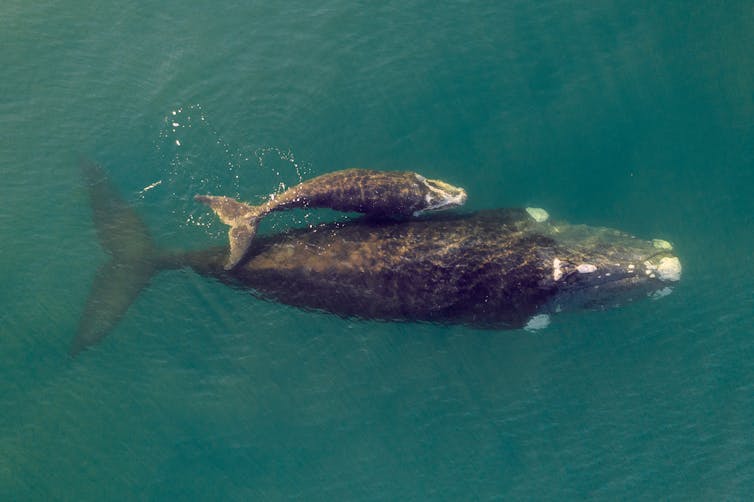
Traditionally, northern breeding grounds for humpback whales in Australian waters occur in the Kimberley region on the west coast and in the Great Barrier Reef on the east.
Globally, humpback whale breeding waters are ideal at temperatures between 21℃ and 28℃. With climate change and an expansion of warming waters, this area is increasing.
Why Do We Sometimes See Mothers With Calves Travelling North?
Sometimes we see mothers with newborn calves well south of traditional breeding grounds. This is most likely the case with the recent pygmy blue whale sighting.
On the east coast of Australia, both humpback and dwarf minke whale mothers have been observed travelling north with bubs in recent years. Perhaps this is a result of the waters being ideal and warm, or maybe some calves just can’t wait to enter the world. Maybe this happens more than we think, with efforts to document this still ongoing.
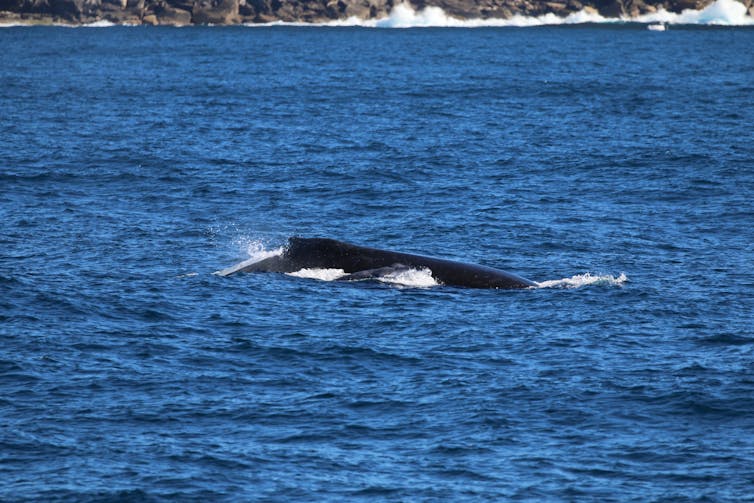
On The Swim For Multitasking Mothers
Once a calf is born, mothers continue to swim with the calf alongside her. This is the most efficient position where the calf is able to swim in her slipstream.
During this time, they may stop and rest. The calf is able to suckle milk from mum’s mammary glands. This fatty milk is perfect for putting on blubber. And don’t worry whale mums, humpback whale calves don’t have any teeth. In fact, all baleen whales, like humpback whales are toothless. Instead of teeth, they have baleen, which are long hair like structures they use to filter feed when they are older.
Breastfeeding duties also come at the time when the mother is migrating, when she must also keep an eye out for predators such as orcas, human hazards (such as ships, fishing gear/nets) and trying to avoid males who may wish to mate with her.
Impressively, she is also likely to be fasting at the same time, relying on energy stores obtained in Antarctic waters.
If conditions are favourable, she may also take the chance to feed in Australian waters. Talk about the ultimate underwater mother!
How Can You See A Mother With Calf?
You just never know what you might see when whale watching. Although your chances of spotting a mother and calf pair is highest in those northern breeding areas, you could also spot them as they migrate northward, or on their return journey south to Antarctic waters. The good news is, whale watching can be done from both land and on the water, depending on where you are in Australia.
Fortunately, all whales in Australian waters are protected. Mothers with calves afford special protection. If on the water or flying a drone, please keep them safe and keep your distance.
Whale mothers truly are tremendous multi-taskers who never cease to amaze me. ![]()
Vanessa Pirotta, Postdoctoral Researcher and Wildlife Scientist, Macquarie University
This article is republished from The Conversation under a Creative Commons license. Read the original article.
To get to net zero, policymakers need to listen to communities. Here’s what they can learn from places like Geelong
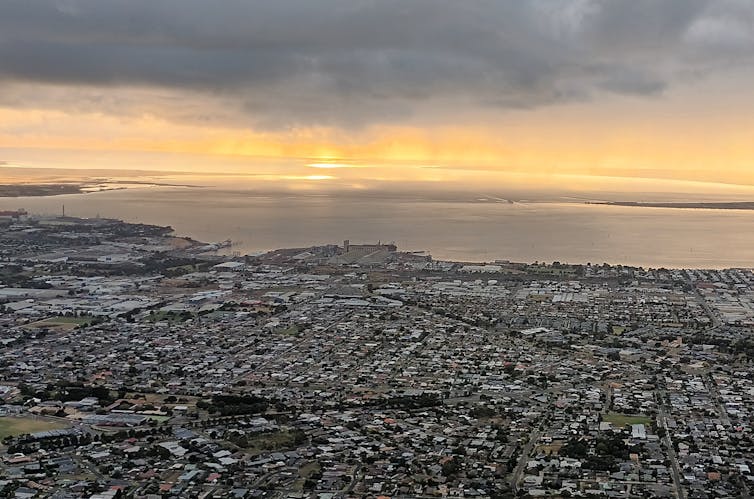
While the federal government was announcing its flagship Net Zero Authority, in the Victorian city of Geelong hundreds of people – including community groups, unions, faith organisations and business representatives – were preparing an announcement of their own this week.
Over the past six months Geelong has hosted one of Australia’s largest ever local “listening campaigns” relating to the climate transition. It’s part of the University of Sydney’s Real Deal for Australia project. The aim is to give local communities a real say in the changes they’re facing.
A report on actions to be taken, based on community feedback, was launched on May 10.
So what can this policymaking experiment teach the Net Zero Authority about how to plan Australia’s climate transition?
One clear message is that housing and its role in this transition is an overwhelming concern. Housing quality and security, cost of living and climate change are all linked by the impacts of extreme weather, energy costs and emissions, and unequal access to solar power. Job security is similarly entwined with climate policy.
But if climate is presented as a separate issue disconnected from these other sources of stress in daily life, people withdraw and see action on climate as too much to bear.
Transition Works Best As A Cooperative Process
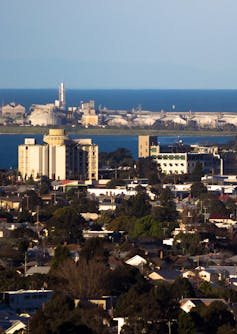
The idea of transition is not new to Geelong. The Pyramid Building Society collapse in 1990 and the closures of the Ford factory and Alcoa aluminium smelter in the 2010s brought about big changes. For many, those transitions were done “to” Geelong not “with” Geelong.
Climate change is bringing another transition. How can we ensure people are not left behind this time?
Community-led research is an approach that has gained currency in recent decades. The term covers a wide range of methods, all based on the principle that communities should be at the centre of any research or policy process that is about them. As an editorial in the journal Nature has said:
Knowledge generated in partnership with the public and policymakers is more likely to be useful to society.
Rather than treating people as the subjects of policy, this approach involves communities in designing policy. It asks everyday people to guide the research process. They shape the questions asked, the methods of engagement, the analysis of data and the creation of research and policy outcomes.
How Does The Real Deal Approach Work?
The Sydney Policy Lab began the Real Deal for Australia project in 2019, following a period of divisive, polarised climate politics in Australia.
It aims to test whether community-driven policy solutions can provide an alternative strategy amid the uncertainties of the climate crisis. Real Deal projects have also begun in Western Sydney and the Queensland port city of Gladstone.
In the Real Deal approach, “relationships must precede action”. In practice, this process has involved building a network of national climate groups, unions and community organisations. Together, they have produced a distinctive approach to community-led research, outlined in a 2020 Real Deal Report.
Between September 2022 and March 2023, the Real Deal for Geelong team conducted 38 “table talks”. These small-group conversations were held in church halls, community centres, union meeting rooms and even a local pub. Achieving this level of participation wasn’t easy.
It makes time for communities to set the agenda and shape solutions that respond to their needs. In a world focused on quick outcomes, some Geelong leaders were sceptical about a drawn-out listening process. Engagement was complicated by post-lockdown exhaustion and interrupted by the Victorian state election and school holidays.
Despite the challenges, the power of this research involving 238 residents lay in how it was done. Local community members, supported by a team of researchers, led the process. It was unlike traditional “consultation” where so-called experts present pre-packaged policy solutions.
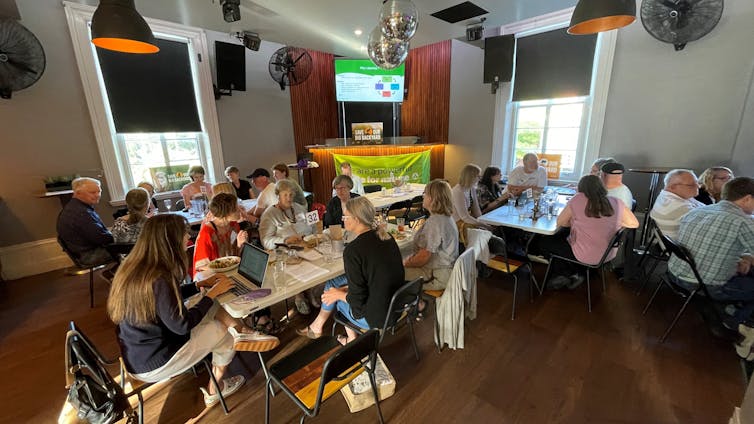
So What Are The Findings From Geelong?
The listening process found the path to net zero requires more than just creating new industries and new jobs. In Geelong, the biggest issue was anxiety about housing – 92% of participants mentioned it.
Housing was closely connected to climate. Poor housing stock, especially rental homes, was unable to handle increasingly erratic weather. There were stories of flooded homes after extreme weather events. The issue of mould alone was raised in 20% of the table talks. A participant from a local community service said:
In our organisation we have reports of substandard rental properties that experience leaks during extreme weather events and sewage coming up through plumbing as stormwater systems fail in older areas.
Housing is linked to both cost of living and climate change. For instance, people in rental homes couldn’t access cheaper, low-emissions electricity through rooftop solar systems.
Participants talked about a two-tier system: the wealthy could protect themselves with better homes, retrofitting and solar; the less well-off could not (as Tuesday’s federal budget recognised).
The listening process also unearthed the importance of good housing as a source of security in a time of uncertainty. As the climate changes, insecure, expensive, inaccessible, poor-quality housing adds to people’s fear and instability.
In addition to housing, jobs, cost of living and quality care services were seen as vital in the transition to net zero.
How Policy Is Made Matters
The findings offer a very useful lesson for the Net Zero Authority. When planning for climate transition was connected to the other daily pressures people face, participants felt more certain of their agency. They became more convinced transformative change was possible.
As Australia steps up its investment in the transition, Geelong’s experience shows it matters how policy is made. When communities have a role in shaping the course of change, climate action can reduce the stresses in their lives instead of adding to them.
Geelong has shown that local and regional community-led approaches can be a powerful way to produce more holistic, just and popular transition policies.![]()
Amanda Tattersall, Research Lead Sydney Policy Lab, Postdoctoral Fellow Geography, Host of ChangeMakers Podcast, University of Sydney
This article is republished from The Conversation under a Creative Commons license. Read the original article.
Smoke from the Black Summer fires could have made the triple La Niña more likely
Martin Jucker, UNSW SydneyThe 2019-2020 bushfire season was devastating. Vast areas of pristine forest burned, many for the first time in memory. By some estimates, a billion native animals died up and down Australia’s east coast. Dozens of people died.
While Sydney’s skies are blue again, Australia’s Black Summer has kept scientists around the globe busy. The sheer size of these megafires produced startling effects. Recently, researchers found the huge volumes of smoke ate away at our protective ozone layer.
Now, new research by American scientists suggests the Black Summer fires were massive enough to influence the El Niño Southern Oscillation cycle. It’s one of the most important drivers of unusual weather over the entire globe – and one which Australians know intimately.
The three successive years of La Niña we just had? They could have been made more likely by the Black Summer fires. The reason, strangely enough, is the smoke.
But it’s important not to say the link is proven. While groundbreaking, this research relies on a single model. It’s too early to clearly say bushfire smoke can trigger La Niña.
Where There’s Fire, There’s Smoke
We’ve long known that the huge volume of ash blown high into the upper atmosphere by a big volcanic eruption can cool Earth’s surface for many months, or even years.
We also know volcanoes can influence the tropical Pacific, and thus affect whether an El Niño or a La Niña phase develops.
How? By blocking light. Particles of ash reduce how much light gets to the surface.
Volcanic ash gets blown high into the stratosphere, the part of the atmosphere just above the clouds where long-haul airplanes fly. Then, sunlight gets reflected before it reaches the ground, thus cooling the surface much like an umbrella can.
Is Bushfire Smoke The Same As Volcanic Ash?
It’s tempting to equate smoke with ash, and assume a large enough bushfire would have similar effects to a volcano.
But there are important differences. Most obviously, a bushfire does not smell of rotten eggs.
That might sound unimportant, but the rotten egg smell – which comes from sulfur – indicates major differences in the composition of volcanic ash and bushfire smoke.
Different chemicals could mean very different responses to sunlight once in the atmosphere, which in turn could affect how much light is reflected.
Second, bushfires don’t explode.
A decent volcano erupts with enough force to blast smoke high into the stratosphere. Bushfires don’t have the same propulsive force.
Bushfire smoke is hot, though, and hot smoke rises well. Some of the smoke from the Black Summer fires reached the stratosphere, although after a much longer interval than for volcanic eruptions.
So, does a large bushfire have the same effect on climate as a volcano?
The American researchers begin by checking the similarities using climate model simulations. They found bushfire smoke does indeed shade the surface from sunlight in these simulations.
How much? Over a region of the south-eastern Pacific, about 150 terawatts of sunlight bounced back to space – the equivalent of about 100,000 coal power plants.
Clouds Matter
The surprising finding is how it happens. In contrast to eruptions, bushfire smoke didn’t reflect the sunlight directly. Instead, clouds were responsible.
How does that work? This is where the magic of the climate system kicks in. Our atmosphere, oceans and lands are constantly interacting with each other.

In their simulations, Black Summer smoke was first blown eastward by strong winds in the atmosphere. Under specific conditions, some smoke particles can interact with droplets in clouds and make clouds thicker and brighter. One region where this can happen is the subtropical south-eastern Pacific.
The researchers were able to show the brightness of the clouds over this area increased considerably just around the time when the smoke particles arrived.
These brighter, whiter clouds reflected more sunlight back into space and shaded the surface underneath. The net effect: cooler seawater.
The effect was particularly important because of the timing. Smoke-whitened clouds emerged around our summer solstice in late December, which is the same time of year when the strength of the incoming sunlight peaks in the southern hemisphere.
How is this linked to La Niña?
Follow the chain: huge volumes of smoke blow east where they whiten clouds, cool the seawater, and cause less water to evaporate.
Surface winds carried this cooler, drier air over the tropical Pacific, where it cooled the ocean surface again, and made it harder for tropical storms to form.
A cooler sea surface in the tropical Pacific is a hallmark of La Niña, the cold phase of the El Niño Southern Oscillation cycle.
That’s how this research was able to trace a link between Black Summer smoke and the rare back-to-back La Niña events in 2019-20 and 2020-21. As you know, we ended up having an even rarer triple La Niña in 2021-22, though the research period ends before this.
Is The Link Now Proven? Not Quite
This study offers a consistent physical explanation for how bushfires might influence the El Niño cycle.
It’s yet another example of how complex climate science can be, and how much we can still be surprised and challenged by what mother nature presents us.
But there are a few caveats to keep in mind.
For one, the ENSO cycle in the simulation was heading for a double La Niña even without the impact of the smoke. The simulation stops in the winter of 2021, which is before the real-world ENSO tipped into a third La Niña.
What does that mean? In short, we can’t know for sure if the effect of the bushfire smoke really did cause the triple La Niña.
Another caveat is the fact the study relied on a single climate model, and relies heavily on the representation of clouds in that model.
That’s a potential problem, because we know clouds – and especially their interactions with aerosols like smoke – are still the largest source of uncertainties and model errors.
To prove or disprove the link, we’ll have to simulate the impact of ballooning Black Summer smoke plumes across many different models. ![]()
Martin Jucker, Lecturer in Atmospheric Dynamics, UNSW Sydney
This article is republished from The Conversation under a Creative Commons license. Read the original article.
Green hydrogen funding is a step forward – but a step doesn’t win the race

It sounds like a lot. Kickstarting green hydrogen in Australia with A$2 billion to subsidise early production and making the energy-dense gas competitive. A goal of up to a gigawatt of electrolyser capacity within seven years.
Two years ago, the hydrogen announcement in Tuesday night’s federal budget might have been more significant. But since then, Russia’s war on Ukraine has driven ever-faster moves to shore up energy security by going green. France, for instance, will invest $14.6 billion in hydrogen. The United States is offering tax credits equivalent to over $4 per kilo of green hydrogen produced.
Since Labor took office, they’ve spruiked Australia as a renewable energy superpower. On solar and wind that’s true – we’re world leaders. But solar and wind are mature technologies. Green hydrogen is not. We’re still working out the best way to do it.
That means you can’t simply allocate $2 billion and expect an entirely new industry to be created. One reason is we don’t have the pipeline of expertise yet – green hydrogen engineers or experts in the electrolysers which crack water to produce hydrogen and oxygen. It will take time and investment to develop local capabilities.
Isn’t Green Hydrogen Steaming Ahead?
On paper, yes. There are now many projects across Australia, with different levels of progress and ambition. Iron ore billionaire Andrew Forrest is betting heavily on green hydrogen with his Fortescue Future Industries company.
It could work – and work well. As coal and gas come out of our power production and cheap solar and wind rush in, we could use cheap daytime energy to crack water and produce hydrogen.
But it’s not guaranteed. It’s not like iron ore, where we have the advantage of large regions of red earth full of ore. There’s nothing special about hydrogen. You don’t have to dig it up. As long as you have access to the technology, the know-how and water, you can make it.
Across the US, Japan, Korea, China and the European Union, everyone is racing ahead. They see the long game – hydrogen will be useful, but only if it’s cheap and safe. That’s why they’re all heavily subsidising the industry.
Why are subsidies needed? Because the technology is still relatively new. Solar cells have been perfected over 40 years. While electrolysers – the key production technology – are well known, they’re currently too expensive. Storage, too, has to get better so we can safely use this flammable gas.
Labor’s $2 billion in subsidies is necessary. You can see the need clearly in the fact that, to date, these startup companies don’t have anyone to buy their product as yet. That’s one reason why South Australian Premier Peter Malinauskas is in Germany at the moment, pitching his state’s product.
4 Reasons Why There’s More To It Than Subsidies
Subsidies are important. Many industries in their infancy rely on them. In fact, Australia’s place as the top liquefied natural gas exporter came about from early subsidies. But they’re not enough by themselves.
What we need is a high-level strategy, hashing out how to actually make this happen.
Here are some key problems we have to solve to make green hydrogen a reality in Australia:
1. Get expertise out of academia. To date, almost all hydrogen experts work in universities. Like me, they may consult to industry. But there’s still a big gap to overcome to ensure the green hydrogen industry has in-house expertise to make their product a commercial reality.
2. Build an ecosystem. Let’s say you want to install a large electrolyser. Who is able to certify that it meets Australian standards? Who is able to test it works under Australian conditions? It’s not as simple as install this machine and churn out green hydrogen at $2 a kilogram. The whole ecosystem needs to be built.
3. Create a domestic market. If we don’t have domestic buyers, it’s hard to jump to export volumes.
4. Make sure it’s safe. Storing a flammable gas is something we’re still figuring out. One answer is to convert it to ammonia for shipping and back to hydrogen at the other end. But the work is still being done. A better answer may to be start accelerating the development of solid state hydrogen storage.
Is It Still Worth It?
Yes. There’s a lot of scepticism about the need for green hydrogen. But in tackling climate change, we will need it. Fuel cell cars, buses and trucks don’t have to rely on batteries which slowly degrade over time.
Green hydrogen will also be needed to decarbonise industries such as steelmaking.
And we will probably need green hydrogen as a way to store energy long term. Once it’s stored, you can keep it indefinitely and use it when you need it. It could be a good complement to solar, wind and storage. Plus, green hydrogen can produce heat for industrial processes.
Like it or not, Australia is in a race to secure part of this new market. We export gas and coal, but their time is ending. Think of how Taiwan went early to secure a lead in making the silicon chips on which so much of the world’s economy relies.
If we want to be competitive, we have to act decisively and fast. Yes, the budget announcement is a step forward. But a step doesn’t win a race. ![]()
Kondo-Francois Aguey-Zinsou, Professor of Chemistry, University of Sydney
This article is republished from The Conversation under a Creative Commons license. Read the original article.
What Australia’s new gas tax will mean for new projects, the economy and the climate
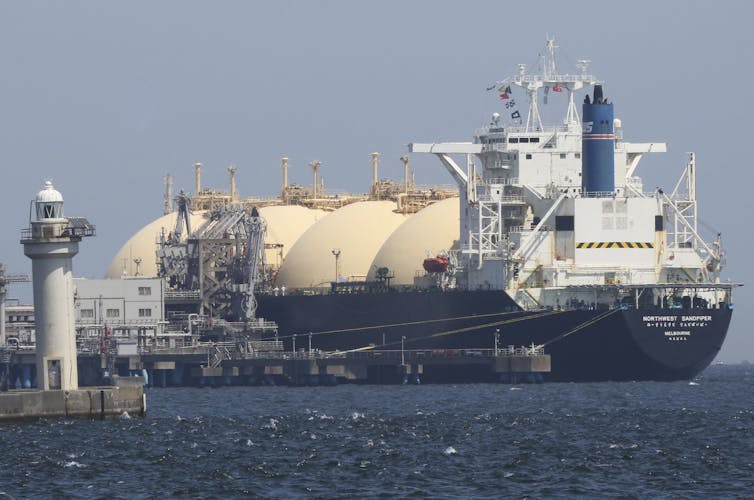
Treasurer Jim Chalmers has announced higher taxes on gas industry profits, which he says will give Australians a “fairer return” on their natural resources.
On Sunday Chalmers flagged changes to the petroleum resource rent tax (PRRT) – a tax on the profits from oil and gas exports – that he says will mean the offshore LNG industry “pays more tax, sooner”.
Many profitable LNG projects are not paying tax under the current regime. Indeed, it has been predicted that most LNG projects will never pay tax.
Changes to the tax are long overdue. As an economic “rent tax”, the mechanism seeks to capture revenue from resource extraction minus the costs of supply. Good resource tax design is a social investment that allows profits to be subject to taxes without those taxes operating as a disincentive on investment. Bad resource tax design works against this because it means those resource profits are immune from tax.
Dusting Off Review Recommendations
The changes come in response to recommendations from two reviews: the Callaghan Petroleum Resource Rent Tax review released in 2017 by then-treasurer Scott Morrison; and a subsequent Treasury review released on Sunday.
The Callaghan report recommended changes to the tax only be applied to new projects, to maintain the stability of the sector.
It said the tax was more effective for oil rather than gas projects because, under the existing scheme, profits are taxed after deducting earlier losses.
Currently, an entity’s liability is levied at 40% of the taxable profit made from its interest in the project. This 40% is levied on offshore oil and gas projects once they start making profits.
The level of deductions that oil and gas projects can carry forward is known as the uplift rate. Australia applies two uplift rates: the long-term bond rate plus 5% (for general losses), and the long-term bond rate plus 15% (for exploration losses).
The long-term bond rate can grow over time, so it effectively doubles every four years. This has meant relatively moderate exploration deductions can accumulate into significant amounts over time. This is not as much of an issue for oil projects because they start making profits relatively quickly. Gas projects accumulate deductions because they take much longer to make a return.
The Callaghan report found if a direct “netback” method was implemented (that is, profit minus extraction/liquefaction costs), an additional A$89 billion could be raised between 2023 and 2050 including an extra $68 billion between 2027 and 2039 at the higher prices.

Changes to the petroleum resource rent tax began in April 2019 when the uplift rate was reduced. Subsequently, onshore gas projects were removed from the scope of the tax, meaning offshore companies could no longer use them as deductions. No further amendments were implemented until now.
On Sunday, Chalmers finally released a final Treasury report of the tax scheme.
His government accepted eight of the 11 recommendations from that review and eight recommendations from the Callaghan Review (recommendations accepted but not implemented by the previous government).
Modest, Balanced Or Weak Reform?
Labor’s proposed changes are too modest and are only expected to net the government about $2.4 billion over the next four years. The proposed tax scheme will cap deductions to limit the proportion of PRRT assessable income that can be offset by deductions to 90%. It will also mean that producers will start paying petroleum resource rent tax immediately rather than in 2030 as is the current expectation.
How Have The Reforms Been Received?
Samantha McCulloch, chief executive of industry peak body the Australian Petroleum Production and Exploration Association, said the announcement provided greater investment certainty for industry. She went on:
The changes aim to get the balance right between the undeniable need for a strong gas sector to support reliable electricity and domestic manufacturing for decades to come and the need for a more sustainable budget.
She called on the government “to work constructively and cooperatively with the opposition”.
The alternative is negotiating with The Greens and the teals. The Greens want the government to eliminate the $284bn of accumulated credits that allow gas companies to reduce their tax liability.
The teals want to further strengthen the tax. Independent Member for Goldstein Zoe Daniel says that while increasing the revenue take from the PRRT is a good start, “lowballing it is a wasted opportunity”.
LNG exports are worth more than $90 billion per year, yet this step will yield only $600 million annually. These are Australian resources, and this is a weak step towards a fair return.
There have been claims the tax hike may threaten new gas projects.
West Australian energy giant Woodside Energy is expected to be hit the hardest. Local liquified natural gas producer Santos and multinationals including Shell, Chevron, and ConocoPhillips may also be affected, media reports suggest.
Real Change Is Desperately Needed
Significant change to the petroleum resource rent tax is desperately needed to address budget repair and blowouts.
In the decade before the Gladstone LNG port opened, when Australia’s gas exports soared, company taxes and the resource tax paid by the industry were approximately 15% of revenue. Since then, it has averaged 6%, and in 2019-20 was just 3.3%.
In 2022, Australia exported a record 81.4 million metric tonnes of LNG, earning the industry $92.8 billion (when expected revenue was $44 billion). If all of these windfall benefits were taxed, the revenue could be used to completely rewire the nation and accelerate the shift to a clean energy future.
This has not happened and the weak reform proposals by Labor do little more than scratch the surface.![]()
Samantha Hepburn, Professor, Deakin Law School, Deakin University
This article is republished from The Conversation under a Creative Commons license. Read the original article.
HECS for farmers? Nature repair loans could help biodiversity recover – and boost farm productivity
Bruce Chapman, Australian National University and David Lindenmayer, Australian National UniversityAlmost three billion hectares of farmland is in poor condition worldwide – an area the size of Russia. Biodiversity is in freefall. Extinctions are rising. Wild animal populations have fallen almost 70% since 1970.
Restoring damaged land and bringing back ecosystems is phenomenally expensive, estimated at A$21 trillion globally.
The sheer scale of the problem is beyond the capacity of traditional approaches to funding repair. That’s one reason why the Australian government is looking to alternatives such as a nature repair market. This, the government hopes, would boost biodiversity – especially on private land such as farms.
To make this market work, the government might consider creating a new version of Australia’s well-known HECS higher education loans. Call it FECS – Farm Environment Contribution Scheme.
The lead author of this article, Bruce Chapman, helped create HECS – the world’s first national income-contingent loan for higher education. Co-author David Lindemayer, ecologist and conservation biologist, has spent decades exploring ways to preserve biodiversity on farmland.
We have shown how farmers could access loans similar to HECS but based on annual revenue, not income to undertake work helping both their business and restoration of nature. This work will boost farm productivity and biodiversity with farmers repaying the loan when their revenues permit.
Why Is This Needed?
Australia has large swathes of degraded land and at least 100 species have gone extinct since European colonisation. To prevent further extinctions, the government announced it would introduce a new nature repair market.
This market could, if done well, tackle some of the drivers of biodiversity loss and land degradation – particularly on our farmland. Protecting habitat and waterways, preventing erosion and improving drought resilience would all be eligible.
Take farm dams. The vast majority of the 650,000 dams in the Murray-Darling Basin are in poor condition. To renovate one by fencing and re-vegetating around it costs about $9000.
But farmers can make this money back. Livestock with access to better quality drinking water gains weight more quickly, giving farmers more cow to sell. There’s a climate benefit too, as renovated dams change rapidly from carbon sources to carbon sinks. Plus, healthier dams provide habitat for more birds, frogs and dragonflies.
The question is – how do you fund this market? Creating tradeable certificates is one way but could be complicated. Another option is to create a rolling fund, where biodiversity loans are given to farmers to do nature repair work such as dam upgrades which help their bottom line – and wildlife.

How Would This Work With The Nature Repair Scheme?
The federal government has pitched its planned nature repair market as an offset scheme: farmers and landholders do repair work and get biodiversity certificates which can be bought by, say, another farmer wanting to clear land.
But there’s a complementary, parallel approach. All farms experience large swings in annual revenues from forces outside a farmer’s control, such as rain, drought, floods and commodity price shocks. The best financial tool to help farmers undertake nature repair is the type which smooths their income. That’s where revenue-dependent loans could work.
Farmers would get the money needed for work on restoration and biodiversity recovery, and incur a debt to be repaid only when future revenue makes it possible. During bad years when farm income is low, repayments would be low or zero. During good years, more debt would be repaid to the government.
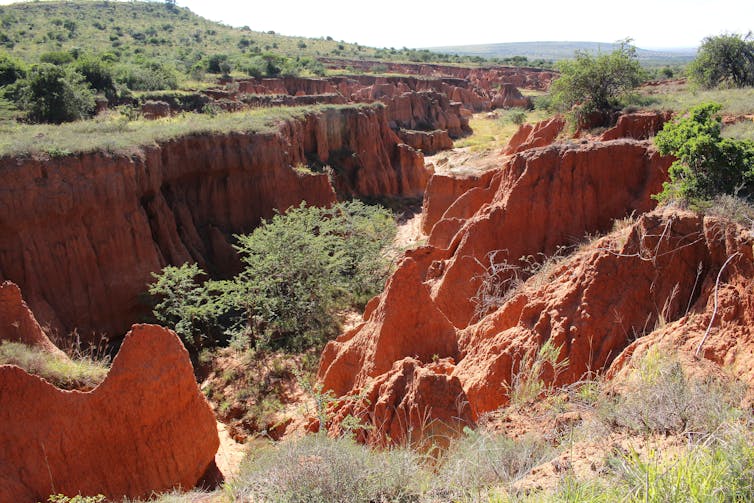
This isn’t wholly new. We already have policies allowing farmers to draw on savings from good years to help cope with poor years, coupled with associated tax benefits. By and large, this works well.
Loans like HECS have this vital income-smoothing feature – you only pay it back when you are in a position to do so. This scheme has worked well to share the cost of university education between the recipient, who will benefit directly from it, and society more broadly, which benefits from highly educated doctors, lawyers, business owners and so on.
With this type of loan, you don’t risk losing your farm if you can’t repay the debt. They’re better than extending your bank loan, because they don’t add to repayments until you’re in a position to make them.
If these loans were added to our nature market, it could get much more traction than a grant scheme. This is because most of the money outlaid by government would be returned as the loans are repaid. It creates a revolving fund, allowing the government to finance many more projects with many more farms than with a grant which, when spent, is gone.
What About The Transparency Problem?
Government schemes can attract people trying to game the system for their own financial benefit.
To avoid this, projects tied to a FECS loan would have ensure plantings, shelterbelts and dam renovations are effective and meet standards.
We could borrow from decades of monitoring hundreds of sustainable farms in endangered temperate woodlands to create robust standards.
These will be crucial to avoid perverse effects, such as the risk of promoting populations of the wrong species. Replanting along narrow strips can simply create habitat for damaging hyper-aggressive native birds like the noisy miner while introduced trees can harbour pests such as starlings. Robust monitoring will be needed to ensure restoration projects actually do produce more biodiversity.
We’ll need three types of monitoring:
- Compliance monitoring – did a landowner do what they said they would?
- Inputs monitoring – how much of the loan or grant was actually invested in fencing, planting trees or improving dams?
- Outcomes monitoring – what was the end result? Did we get more species of native animals and invertebrates (including species of conservation concern)?
As we wrestle with the best way forward for Australia’s first nature repair market, we should seriously consider rolling out revenue-dependent loans for farmers.
It could make life easier for farmers at little cost to the government – and get the ball rolling on the ever more urgent issue of restoring land and the species that rely on it.![]()
Bruce Chapman, Director, Policy Impact, College of Business and Economics, Australian National University and David Lindenmayer, Professor, The Fenner School of Environment and Society, Australian National University
This article is republished from The Conversation under a Creative Commons license. Read the original article.
Budget’s energy bill relief and home retrofit funding is a good start, but dwarfed by the scale of the task
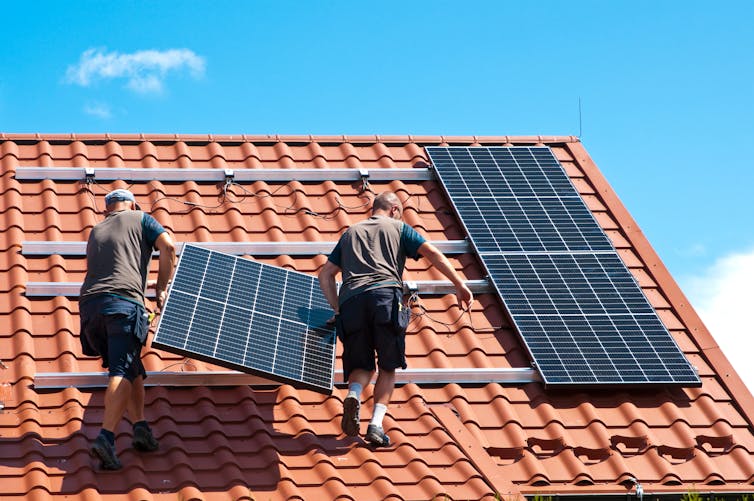
The quality and performance of our housing have big impacts on the environment, cost of living and our health and wellbeing. The 2023-24 federal budget’s announcement of $1.6 billion for energy-saving upgrades to housing recognises the broad importance of retrofitting Australian homes.
Until now, much of the focus in Australia has been on improving the quality and performance of new housing. Recent changes to the National Construction Code improve minimum standards for new housing for the first time in more than a decade.
But more than 10.8 million existing dwellings fall short of the quality and performance needed for a low-carbon and affordable future. We must urgently shift our attention to delivering a deep retrofit – including solar panels, double glazing and other insulation – of the homes 99% of us live in. This would not only be good for the environment and reduce living costs, it would also improve our health and wellbeing and help increase the reliability of the energy grid.
Most of our existing houses were built before minimum performance standards were adopted. Houses built before 1990 typically perform at a level of 1-3 stars on the Nationwide House Energy Rating Scheme (NatHERS) (0 being worst, 10 best), compared to the 7 stars required of homes built after this October in most states.
Improving a house from 1 to 5 stars would reduce the energy needed for heating and cooling by about 70% in the Melbourne climate zone. And that means the household’s energy bills and emissions would be much lower too.
All this means the budget announcements are a welcome, but long-overdue, move to start a retrofit revolution in Australia.
What Was Announced?
The 2023-24 budget includes:
$3 billion in rebates that directly reduce energy bills for over 5 million households
$1.3 billion to set up the Household Energy Upgrades Fund, which will provide $1 billion to the Clean Energy Finance Corporation to finance home energy upgrades for around 110,000 households
$300 million to co-fund 60,000 social housing retrofits with the states and territories
$36.7 million to expand and upgrade NatHERS to apply to existing homes, which will give households better information for decisions on energy upgrades and renting or buying homes
expand and modernise the Greenhouse Energy Minimum Standards (GEMS) to cover more products.
This funding will help make our existing housing more energy-efficient and cheaper to run.
It’s A Start But Much More Is Needed
Much of the budget is focused on providing short-term relief for vulnerable households facing rising energy bills. But the bigger, long-term challenge is to help existing housing become more sustainable, affordable and liveable.
The cash rebate on energy bills is a short-term fix. The money could be better spent on prevention rather than cure. Retrofitting goes to the heart of the problem – ageing, energy-guzzling homes – and is a responsible use of taxpayer money.
The benefits of retrofitting a house outlive the current residents. It should be seen as an investment in the national housing stock rather than a handout to individual households. A cash rebate to reduce energy bills does nothing to improve housing performance.
The expansion of NatHERS to better account for existing housing is a welcome incentive to upgrade these homes. We need to make sure, though, that the information provided is robust, reliable and accessible to all households. Households need practical information about the cost-efficient retrofit actions they can take.
In other parts of the world, such as the United Kingdom and Europe, information about a home’s performance must be disclosed at point of sale or lease. This helps households make informed decisions. It also provides better data to governments about the quality and performance of the housing stock.
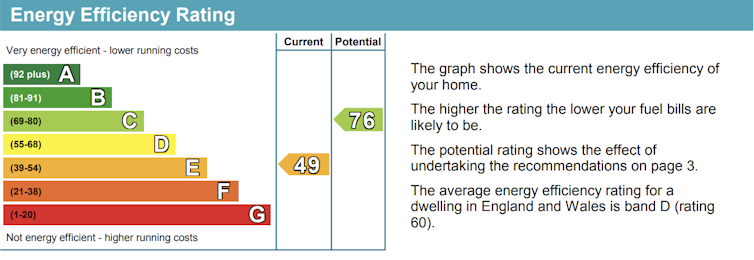
In Australia we have very poor data about our existing housing. We are developing policy and support with one hand tied behind our back.
The Scale Of The Retrofit Challenge Is Huge
Another key issue is the scale and urgency of the retrofit task we face. The budget announcement will make only a small dent in the work to be done. If we assume the performance of most of our existing homes is below-par, that means we will need to deliver deep retrofit to more than 45 homes every hour between now and 2050.
Upgrading 110,000 private homes and 60,000 social housing units is better than nothing, but we clearly need to scale up this work well beyond these numbers. This will require much more ambition and coordination from all levels of government.

We must also focus more on those who are most vulnerable, such as private renters on low incomes. Low-cost loans are good – if you qualify and have the means to repay them. What will those on the lowest incomes or without access to resources do?
We also need to make sure these loans don’t simply fund technology upgrades when there are cheaper and simpler things to do first, such as sealing gaps and cracks.
Scaling up is more than just a matter of providing support to households. We need to strengthen and develop retrofit capacity across the building industry to ensure demand can be met.
The industry needs certainty about the commitment of all levels of government to assist and sustain a low-carbon retrofit industry over time. This will allow the industry to plan and invest in capacity. This approach would help bolster the struggling construction industry while feeding into Australia’s wider net-zero ambitions.![]()
Trivess Moore, Senior Lecturer, School of Property, Construction and Project Management, RMIT University and Ralph Horne, Associate Deputy Vice Chancellor, Research & Innovation, College of Design & Social Context, RMIT University
This article is republished from The Conversation under a Creative Commons license. Read the original article.
Microplastics: we’ve found startling quantities in the ice algae that are essential for all Arctic marine life
Deonie Allen, University of Birmingham; Melanie Bergmann, Alfred Wegener Institute Helmholtz Centre for Polar and Marine Research, and Steve Allen, Dalhousie UniversityLast summer, we travelled to the remote Arctic Hausgarten observatory area in the eastern Fram Strait (west of Svalbard, Norway) on a research ship. The samples we collected there included ice cores, sea water and ice algae from large packs of floating ice called ice floes. These form 1–2 metre thick “plates” of sea ice across the Arctic Ocean, some of which melt over the summer period.
Algae grow on the underside of these ice floes. Melosira arctica – nicknamed “snot” due to its sticky, slimy and green nature – is one of the major algae species in the Arctic Ocean. It is an essential organism both in the Arctic food web and for marine life overall.
These ice algae provide nutrition for plankton and various other marine organisms in the Arctic. The algae also act as a conveyor belt of food for the organisms that live on the sea floor. As the ice melts, the algae detach and sink to the bottom where they are eaten by animals such as sea cucumbers and brittlestars.
Ice algae are also a carbon sink, using CO₂ from the atmosphere and light energy from the sun to produce organic matter through photosynthesis – a process known in ecology as “primary production”. In 2012, these algae accounted for 45% of the Arctic’s primary production.
But now we’ve found that Arctic ice algae contain microplastics. This in itself may not be surprising: plastic has been found in every environment so far investigated on Earth. But the quantities we found were startling.
We discovered an average of 31,000 microplastic particles per cubic metre of Melosira arctica – a magnitude ten times higher than recorded in the surrounding water. Most of these particles were very small (less than 10 micrometres) and included many different types of plastic. The contamination of the ice algae could have major consequences for ecosystems and the climate.
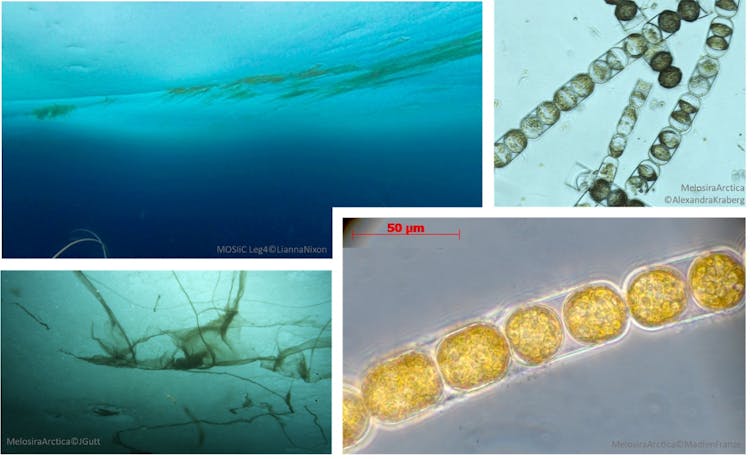
An Elevator To The Seabed
These particles may come from the surrounding sea water, the supporting sea ice (either trapped when the sea ice forms, or from the movement of liquid and particles through the ice as it melts), or from atmospheric microplastics that have been deposited on the ice and sea surface. While the process by which sea ice algae take in these microplastics is not yet well understood, it is clear they are highly effective at “collecting” these small plastic particles.
In our earlier research, we were puzzled that the largest amount of microplastic on the Arctic seabed was always found underneath the sea ice melting zone along the ice edge, even in deep-sea sediment. The movement of Melosira clumps from the sea and ice surface to the seabed helps to explain why.
The speed at which the algal clumps descend means they fall rapidly almost in a straight line below the edge of the ice. Other algae, which become “marine snow” (a term used for organic material that slowly drifts to the seafloor), fall much slower. These are often eaten as they descend and are also pushed sideways by currents, so sink to the seabed much further away from the ice edge.
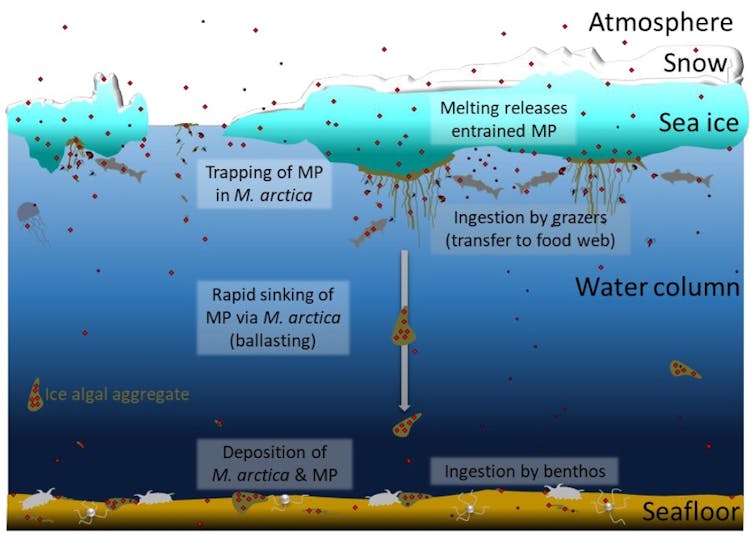
Why Is It A Problem?
Melosira feeds essential Arctic seafloor and marine ecosystems. Its position at the bottom of the food chain means there is a risk of microplastics being passed upwards through the marine food web.
This threat is particularly acute in the area we studied, as the Melosira sampled had collected even very small microplastics. Smaller microplastic particles are more likely to be transferred across cell membranes.
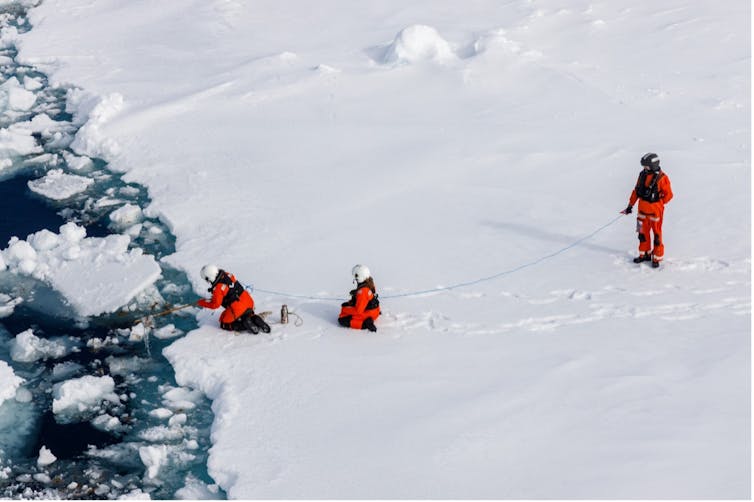
Research finds that microplastics and their associated chemicals can alter the growth, function and breeding of marine species such as plankton and fish. It is extremely difficult to perform experiments on Arctic or deep-sea species because of the challenges associated with replicating their environmental conditions. However, one laboratory study found that microplastic exposure caused egg production rates to increase by up to eight times in Arctic zooplankton – a response that is probably the result of stress.
The impact of microplastic contamination on Melosira itself is not yet known. But it’s possible that microplastics change Melosira’s abundance, lifespan and health.
Microplastics that are stuck to the outside of algae could lower photosynthetic rates by blocking out sunlight. And if particles enter the algal cells, then they could damage the parts of the cell where photosynthesis takes place (called chloroplasts) and therefore also impede this process. This could affect the export of carbon by Melosira from the air or sea to the seabed, and thus alter the processes underlying this important Arctic carbon sink.
Arctic ice algae are collecting high quantities of microplastics – a previously unknown hotspot. But our findings are likely just the “tip of the iceberg”. They should accelerate conversations about the importance, and potential impact, of microplastics in Arctic sea ice algae on the ecosystems that these vital algae support.![]()
Deonie Allen, Research Fellow, University of Birmingham; Melanie Bergmann, Senior Scientist, Alfred Wegener Institute Helmholtz Centre for Polar and Marine Research, and Steve Allen, Ocean Frontier Institute researcher, Dalhousie University
This article is republished from The Conversation under a Creative Commons license. Read the original article.
Thousands of badgers being farmed in South Korea could be a disease risk
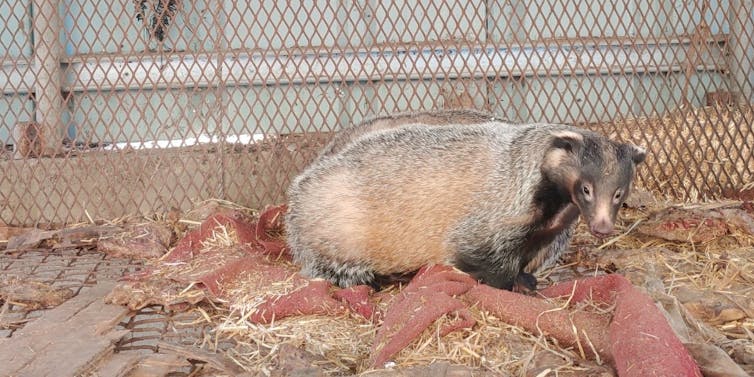
Campaigners in South Korea are celebrating news that the country will ban bear farming by 2026. This follows three decades of uncertainty over an industry dogged by claims of poor welfare conditions, animal abuse and illegal breeding.
However, colleagues and I just published the first ever scientific assessment of a form of wildlife farming that, by contrast, has gone completely under the radar: the farming of badgers.
While wildlife trade involving badgers is probably best-known from the fur used in luxury shaving brushes (most of which comes from farms in China), the use and trade of badgers has a surprisingly long – and global – history. For example, apothecaries in medieval France sold badger bones, dried blood, brains, testicles and livers as cures for a range of ailments.
In the 21st century, wildlife market surveys in China, Vietnam, Laos and Indonesia have reported several different species of badger being sold as bushmeat.
Asian badgers, which are closely related to European badgers, have historically been hunted and traded on the Korean Peninsula for their meat or for use in traditional medicine. In the 1990s, however, this trade took a new turn with the emergence of badger farms in South Korea.
This development coincided with increased restrictions on bear bile farming, following the country’s accession to the convention on international trade in endangered species (Cites). Though badger is valued in its own right for traditional medicine, it is also marketed as a potential substitute for bear.
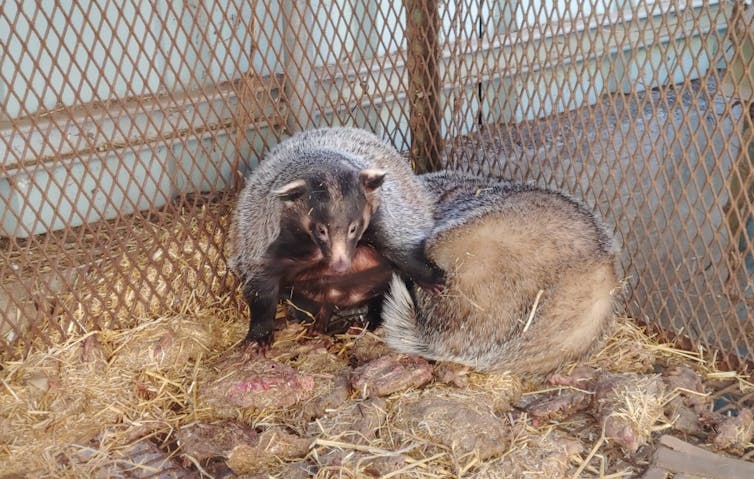
While there are questions about the reliability of official records of the number of animals on badger farms, the two data sets that are collected annually both agree that in 2019 there were about 4,000 farmed badgers in South Korea, ten times the number of farmed bears.
The number of animals involved has surprised researchers and raises concerns over the welfare of captive badgers, which are highly social and territorial animals. Badgers are difficult to breed in captivity, and very dated advice for badger farmers still published online by the South Korean government includes the use of hormone injections on females to induce breeding.
Badgers famously dig underground setts, so farmers are advised to construct pens with wire or concrete floors to prevent their escape. There is even some evidence of badger cubs being sold as pets, despite their highly unsuitable temperament.

While wild badgers have some legal protection in South Korea, products such as badger gallbladders soaked in liquor, which are sold online, claim to come from either domestic farms or, sometimes, wild animals from Russia or China.
However, we know that badger poaching still occurs in rural South Korea. There would be almost no way for a discerning buyer to distinguish between legal products and those from illegally harvested wild animals.
The trade now also supplies less traditional products. Perhaps the most startling are badger-derived cosmetics, such as soaps, oils and creams which are typically marketed as moisturisers, skin whiteners or as anti-ageing products.

This trade comes with a number of important risks which have so far been almost entirely overlooked, in what can best be summarised as a complete absence of government regulation beyond the collection of basic agricultural records on the number of badgers held by farms.
Farming Badgers Is A Potential Biosecurity Risk
Researchers have previously warned that wildlife farms could provide the ideal environments for the emergence of future zoonotic diseases.
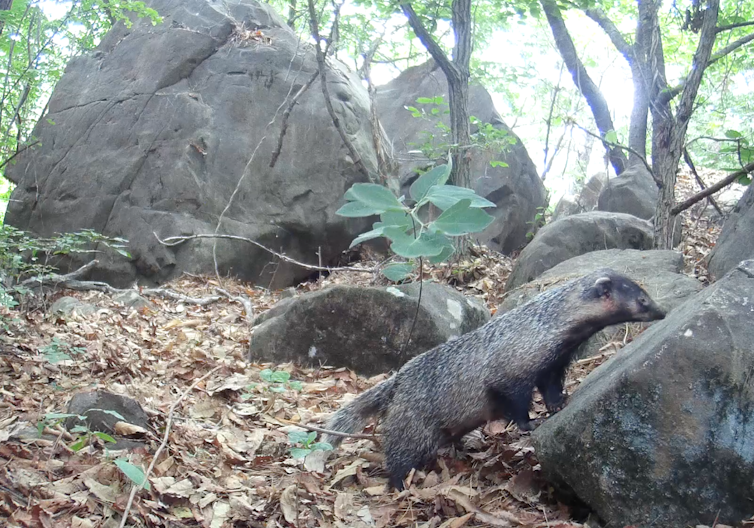
Badgers belong to a family of mammals known as mustelids. Recent outbreaks of zoonotic diseases on mustelid farms, such as the COVID outbreak on a Danish mink farm in 2020 that led to millions of animals being slaughtered, show how this could have implications for both animal and human health.
There are several reasons to be concerned about the transmission of disease (either to animals or humans) on badger farms specifically. The most important is the current lack of sufficient biosecurity protocols, such as checks on the disease status of live animals being sold between farms or to the public, and the hygiene standards required of slaughter facilities.
And there are reports of both wild badgers having been used to stock farms and farmed badgers having been released into the wild, which could facilitate the spread of disease.
From tigers to the giant panda, there can be a tendency for conservation to focus on large, charismatic species. This can sometimes help protect habitat for other species, or draw attention to particular issues.
However, sometimes it can obscure less well-known species and the impacts that we might be having on them. The Asian badger would seem to be one such species.
In South Korea, badger farming appears to present many of the same conservation, welfare and health risks as bear farming does. Unlike bears, badgers have so far been largely overlooked. Hopefully that will now change.![]()
Joshua Elves-Powell, PhD Researcher, Conservation Biology, UCL
This article is republished from The Conversation under a Creative Commons license. Read the original article.
Tiny aquatic athletes: how baby Nemo can ‘just keeping swimming’ from the open ocean to the reef
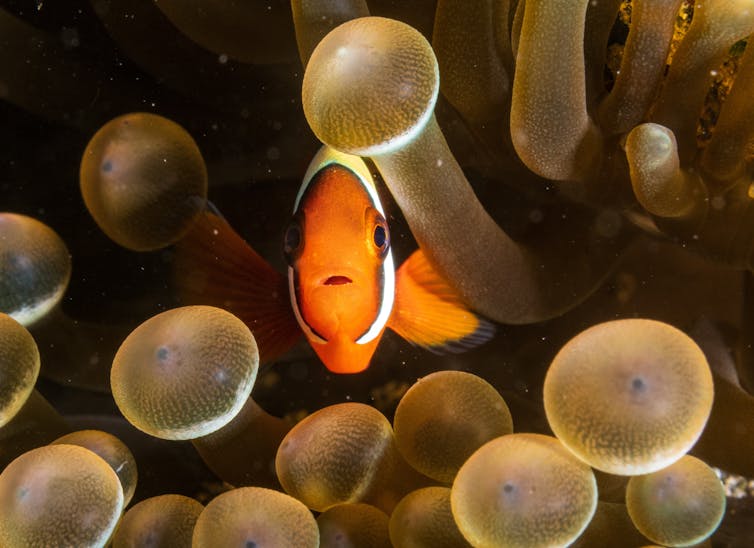
If you’ve seen the hit animated film Finding Nemo, you might recall the character Dory singing the catchy tune “Just Keep Swimming” to help her clownfish friend Marlin make the long journey from the Great Barrier Reef to Sydney.
In this case, art imitates life. Marathon swimming performances are a vital part of early life for the vast majority of coral reef fish. Baby (larval) reef fish – smaller than the size of your thumbnail – hatch from eggs laid on the reef and spend a few weeks in the open ocean before swimming back to the reef.
But how does such a small creature make this impressive journey? Our research published today set out to answer this question.
We found larval clownfish dramatically alter their physiology to complete their journey from the ocean back to the reef. In particular, they take in more oxygen per breath and at a faster rate than any other fish species studied to date. Essentially, this makes baby clownfish some of the smallest athletes on the planet.
Mini Athletes Swimming 10-50 Body Lengths Per Second
Reef fish are vital to coral reef ecosystems. They play important roles in the food web, help keep the reef clean and recycle nutrients. Plus, their vibrant colours attract millions of tourists annually.
Adult reef fish keep to a small patch. Their eggs are carried off by wave action into the open ocean, where they hatch and develop.
Within a few weeks the tiny fish larvae must return to the reef. It’s a long, arduous journey that can last weeks to months. Depending on the species, they cover distances as far as 64 kilometres. So how do they do it?
Until the 1990s, scientists believed the development of larval reef fish was like that of other fish such as herring, cod and flatfish. These species “go with the flow”, passively riding ocean currents until they become large and developed enough to actively swim on their own, against the currents.
However, landmark studies from the early 1990s documented the impressive swimming capabilities of baby reef fish. It turns out reef fish are not passive particles after all.
Previous research has provided overwhelming evidence coral reef fishes are capable of amazing swimming performance as babies.
Some of these tiny athletes are capable of swimming 10-50 body lengths per second as a larva. For comparison, Olympic multi-gold medallist Michael Phelps races at just under two body lengths per second.
When paired with well-developed sensory systems such as vision and the sense of smell, such impressive athletic performance enables these babies to “just keep swimming” with or against ocean currents until they find an optimal reef on which to settle.
But 30 years after the discovery, we were still wondering how they manage it. Now we know.
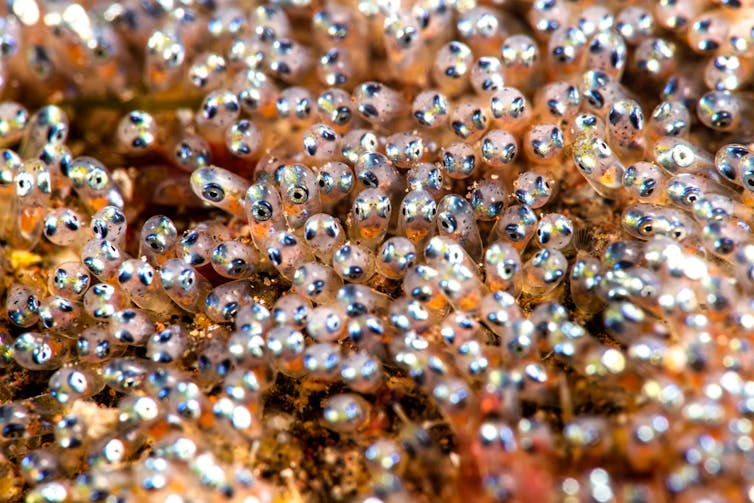
Measuring The Traits Of An Athlete
My colleagues and I measured physiological traits required to be an athletic swimmer across the entire larval phase of a clownfish. These traits included swimming speed, oxygen uptake rates, gene expression patterns, and tolerance to low oxygen (hypoxia).
Why hypoxia? At night, when it’s no longer possible to use sunshine and carbon dioxide to make energy by photosynthesis, corals and plants breathe in oxygen to make energy. This lowers oxygen levels on reefs. Larval reef fish returning home from the open ocean must prepare for such conditions.
We found larval clownfish have the highest oxygen uptake rates of any fish to date. This supports elite swimming, growth and development.
As they develop and swim faster, thousands of genes change. Genes that code for proteins that transport and store oxygen, such as haemoglobin and myoglobin (also found in our bodies), are especially important. They enable oxygen to be transported and stored during intense exercise and help retain oxygen in tissues when the fish experience hypoxia in their reef habitats.
The changes in haemoglobin and myoglobin genes also correspond to when these baby fish start to increase their hypoxia tolerance.
We’ve seen this before, in reverse. Salmon are one of the most studied fish of all time and, as adults, they’re pretty amazing athletes as well. However, baby salmon endure low oxygen conditions in the first few weeks of life, right after hatching, while they are hiding in the gravel of the freshwater riverbeds.
And, sure enough, back in the 1980s, research showed salmon switch their haemoglobin too – right when the baby salmon have to transition from being hypoxia tolerant, to training to become elite swimmers.
Why Our Research Matters
The changes in physiological machinery that we uncovered are key to survival for clownfish. It’s likely other coral reef fish follow similar developmental pathways.
Reef fish – of all shapes, sizes, and colours – are integral for maintaining coral reef health and persistence of future coral reefs. This is crucial as climate change threatens these beautiful, delicate ecosystems.![]()
Adam T. Downie, Marine Biologist, James Cook University and Jodie L. Rummer, Professor of Marine Biology, James Cook University
This article is republished from The Conversation under a Creative Commons license. Read the original article.
Pittwater Reserves: Histories + Notes + Pictorial Walks
A History Of The Campaign For Preservation Of The Warriewood Escarpment by David Palmer OAM and Angus Gordon OAM
A Stroll Through Warriewood Wetlands by Joe Mills February 2023
A Walk Around The Cromer Side Of Narrabeen Lake by Joe Mills
America Bay Track Walk - photos by Joe Mills
An Aquatic June: North Narrabeen - Turimetta - Collaroy photos by Joe Mills
Angophora Reserve Angophora Reserve Flowers Grand Old Tree Of Angophora Reserve Falls Back To The Earth - History page
Annie Wyatt Reserve - A Pictorial
Avalon's Village Green: Avalon Park Becomes Dunbar Park - Some History + Toongari Reserve and Catalpa Reserve
Bairne Walking Track Ku-Ring-Gai Chase NP by Kevin Murray
Bangalley Headland Bangalley Mid Winter
Banksias of Pittwater
Barrenjoey Boathouse In Governor Phillip Park Part Of Our Community For 75 Years: Photos From The Collection Of Russell Walton, Son Of Victor Walton
Barrenjoey Headland: Spring flowers
Barrenjoey Headland after fire
Bayview Baths
Bayview Wetlands
Beeby Park
Bilgola Beach
Botham Beach by Barbara Davies
Bungan Beach Bush Care
Careel Bay Saltmarsh plants
Careel Bay Birds
Careel Bay Clean Up day
Careel Bay Playing Fields History and Current
Careel Creek
Careel Creek - If you rebuild it they will come
Centre trail in Ku-ring-gai Chase National Park
Chiltern Track- Ingleside by Marita Macrae
Clareville Beach
Clareville/Long Beach Reserve + some History
Coastal Stability Series: Cabbage Tree Bay To Barrenjoey To Observation Point by John Illingsworth, Pittwater Pathways, and Dr. Peter Mitchell OAM
Cowan Track by Kevin Murray
Curl Curl To Freshwater Walk: October 2021 by Kevin Murray and Joe Mills
Currawong and Palm Beach Views - Winter 2018
Currawong-Mackerel-The Basin A Stroll In Early November 2021 - photos by Selena Griffith
Currawong State Park Currawong Beach + Currawong Creek
Deep Creek To Warriewood Walk photos by Joe Mills
Drone Gives A New View On Coastal Stability; Bungan: Bungan Headland To Newport Beach + Bilgola: North Newport Beach To Avalon + Bangalley: Avalon Headland To Palm Beach
Duck Holes: McCarrs Creek by Joe Mills
Dunbar Park - Some History + Toongari Reserve and Catalpa Reserve
Dundundra Falls Reserve: August 2020 photos by Selena Griffith - Listed in 1935
Elsie Track, Scotland Island
Elvina Track in Late Winter 2019 by Penny Gleen
Elvina Bay Walking Track: Spring 2020 photos by Joe Mills
Elvina Bay-Lovett Bay Loop Spring 2020 by Kevin Murray and Joe Mills
Fern Creek - Ingleside Escarpment To Warriewood Walk + Some History photos by Joe Mills
Iluka Park, Woorak Park, Pittwater Park, Sand Point Reserve, Snapperman Beach Reserve - Palm Beach: Some History
Ingleside
Ingleside Wildflowers August 2013
Irrawong - Ingleside Escarpment Trail Walk Spring 2020 photos by Joe Mills
Irrawong - Mullet Creek Restoration
Katandra Bushland Sanctuary - Ingleside
Lucinda Park, Palm Beach: Some History + 2022 Pictures
McCarrs Creek
McCarr's Creek to Church Point to Bayview Waterfront Path
McKay Reserve
Mona Vale Beach - A Stroll Along, Spring 2021 by Kevin Murray
Mona Vale Headland, Basin and Beach Restoration
Mona Vale Woolworths Front Entrance Gets Garden Upgrade: A Few Notes On The Site's History
Mount Murray Anderson Walking Track by Kevin Murray and Joe Mills
Mullet Creek
Narrabeen Creek
Narrabeen Lagoon Catchment: Past Notes Present Photos by Margaret Woods
Narrabeen Lagoon State Park
Narrabeen Lagoon State Park Expansion
Narrabeen Rockshelf Aquatic Reserve
Nerang Track, Terrey Hills by Bea Pierce
Newport Bushlink - the Crown of the Hill Linked Reserves
Newport Community Garden - Woolcott Reserve
Newport to Bilgola Bushlink 'From The Crown To The Sea' Paths: Founded In 1956 - A Tip and Quarry Becomes Green Space For People and Wildlife
Pittwater Reserves: The Green Ways; Bungan Beach and Bungan Head Reserves: A Headland Garden
Pittwater Reserves, The Green Ways: Clareville Wharf and Taylor's Point Jetty
Pittwater Reserves: The Green Ways; Hordern, Wilshire Parks, McKay Reserve: From Beach to Estuary
Pittwater Reserves - The Green Ways: Mona Vale's Village Greens a Map of the Historic Crown Lands Ethos Realised in The Village, Kitchener and Beeby Parks
Pittwater Reserves: The Green Ways Bilgola Beach - The Cabbage Tree Gardens and Camping Grounds - Includes Bilgola - The Story Of A Politician, A Pilot and An Epicure by Tony Dawson and Anne Spencer
Pittwater spring: waterbirds return to Wetlands
Pittwater's Lone Rangers - 120 Years of Ku-Ring-Gai Chase and the Men of Flowers Inspired by Eccleston Du Faur
Pittwater's Parallel Estuary - The Cowan 'Creek
Resolute Track at West Head by Kevin Murray
Resolute Track Stroll by Joe Mills
Riddle Reserve, Bayview
Salvation Loop Trail, Ku-Ring-Gai Chase National Park- Spring 2020 - by Selena Griffith
Seagull Pair At Turimetta Beach: Spring Is In The Air!
Stapleton Reserve
Stapleton Park Reserve In Spring 2020: An Urban Ark Of Plants Found Nowhere Else
Stony Range Regional Botanical Garden: Some History On How A Reserve Became An Australian Plant Park
The Chiltern Track
The Resolute Beach Loop Track At West Head In Ku-Ring-Gai Chase National Park by Kevin Murray
Topham Track Ku-Ring-Gai Chase NP, August 2022 by Joe Mills and Kevin Murray
Towlers Bay Walking Track by Joe Mills
Trafalgar Square, Newport: A 'Commons' Park Dedicated By Private Landholders - The Green Heart Of This Community
Tranquil Turimetta Beach, April 2022 by Joe Mills
Turimetta Beach Reserve by Joe Mills, Bea Pierce and Lesley
Turimetta Beach Reserve: Old & New Images (by Kevin Murray) + Some History
Turimetta Headland
Warriewood Wetlands - Creeks Deteriorating: How To Report Construction Site Breaches, Weed Infestations + The Long Campaign To Save The Warriewood Wetlands & Ingleside Escarpment March 2023
Warriewood Wetlands and Irrawong Reserve
Whale Beach Ocean Reserve: 'The Strand' - Some History On Another Great Protected Pittwater Reserve
Wilshire Park Palm Beach: Some History + Photos From May 2022
Winji Jimmi - Water Maze

Pittwater's Birds
Australian Predators of the Sky by Penny Olsen - published by National Library of Australia
Australian Raven Australian Wood Duck Family at Newport
A Week In Pittwater Issue 128 A Week In Pittwater - June 2014 Issue 168
Baby Birds Spring 2015 - Rainbow Lorikeets in our Yard - for Children Baby Birds by Lynleigh Greig, Southern Cross Wildlife Care - what do if being chased by a nesting magpie or if you find a baby bird on the ground
Baby Kookaburras in our Backyard: Aussie Bird Count 2016 - October
Balloons Are The Number 1 Marine Debris Risk Of Mortality For Our Seabirds - Feb 2019 Study
Bangalley Mid-Winter Barrenjoey Birds Bird Antics This Week: December 2016
Bird of the Month February 2019 by Michael Mannington
Birdland Above the Estuary - October 2012 Birds At Our Window Birds at our Window - Winter 2014 Birdland June 2016
Birdsong Is a Lovesong at This time of The Year - Brown Falcon, Little Wattle Bird, Australian Pied cormorant, Mangrove or Striated Heron, Great Egret, Grey Butcherbird, White-faced Heron
Bird Songs – poems about our birds by youngsters from yesterdays - for children Bird Week 2015: 19-25 October
Bird Songs For Spring 2016 For Children by Joanne Seve
Birds at Careel Creek this Week - November 2017: includes Bird Count 2017 for Local Birds - BirdLife Australia by postcode
Black Cockatoo photographed in the Narrabeen Catchment Reserves this week by Margaret G Woods - July 2019
Black-Necked Stork, Mycteria Australis, Now Endangered In NSW, Once Visited Pittwater: Breeding Pair shot in 1855
Black Swans on Narrabeen Lagoon - April 2013 Black Swans Pictorial
Endangered Little Tern Fishing at Mona Vale Beach
‘Feather Map of Australia’: Citizen scientists can support the future of Australia's wetland birds: for Birdwatchers, school students and everyone who loves our estuarine and lagoon and wetland birds
Fledgling Common Koel Adopted by Red Wattlebird -Summer Bird fest 2013 Flegdlings of Summer - January 2012
Flocks of Colour by Penny Olsen - beautiful new Bird Book Celebrates the 'Land of the Parrots'
Friendly Goose at Palm Beach Wharf - Pittwater's Own Mother Goose
Front Page Issue 177 Front Page Issue 185 Front Page Issue 193 - Discarded Fishing Tackle killing shorebirds Front Page Issue 203 - Juvenile Brush Turkey Front Page Issue 208 - Lyrebird by Marita Macrae Front Page Issue 219 Superb Fairy Wren Female Front Page Issue 234: National Bird Week October 19-25 and the 2015 the Aussie Back Yard Bird Count: Australia's First Bird Counts - a 115 Year Legacy - with a small insight into our first zoos Front Page Issue 236: Bird Week 2015 Front Page Issue 244: watebirds Front Page Issue 260: White-face Heron at Careel Creek Front Page Issue 283: Pittwater + more birds for Bird Week/Aussie Bird Count Front Page Issue 284: Pittwater + more birds for Bird Week/Aussie Bird Count Front Page Issue 285: Bird Week 2016 Front Page Issue 331: Spring Visitor Birds Return
G . E. Archer Russell (1881-1960) and His Passion For Avifauna From Narrabeen To Newport
Glossy Black-Cockatoo Returns To Pittwater by Paul Wheeler Glossy Cockatoos - 6 spotted at Careel Bay February 2018
Grey Butcher Birds of Pittwater
INGLESIDE LAND RELEASE ON AGAIN BUT MANY CHALLENGES AHEAD by David Palmer
Issue 60 May 2012 Birdland - Smiles- Beamings -Early -Winter - Blooms
Jayden Walsh’s Northern Beaches Big Year - courtesy Pittwater Natural Heritage Association
John Gould's Extinct and Endangered Mammals of Australia by Dr. Fred Ford - Between 1850 and 1950 as many mammals disappeared from the Australian continent as had disappeared from the rest of the world between 1600 and 2000! Zoologist Fred Ford provides fascinating, and often poignant, stories of European attitudes and behaviour towards Australia's native fauna and connects these to the animal's fate today in this beautiful new book - our interview with the author
July 2012 Pittwater Environment Snippets; Birds, Sea and Flowerings
Juvenile Sea Eagle at Church Point - for children
King Parrots in Our Front Yard
Kookaburra Turf Kookaburra Fledglings Summer 2013 Kookaburra Nesting Season by Ray Chappelow Kookaburra Nest – Babies at 1.5 and 2.5 weeks old by Ray Chappelow Kookaburra Nest – Babies at 3 and 4 weeks old by Ray Chappelow Kookaburra Nest – Babies at 5 weeks old by Ray Chappelow Kookaburra and Pittwater Fledglings February 2020 to April 2020
Lion Island's Little Penguins (Fairy Penguins) Get Fireproof Homes - thanks to NSW National Parks and Wildlife Service and the Fix it Sisters Shed
Lyre Bird Sings in Local National Park - Flock of Black Cockatoos spotted - June 2019
Magpie's Melodic Melodies - For Children (includes 'The Magpie's Song' by F S Williamson)
Masked Lapwing (Plover) - Reflected
May 2012 Birdland Smiles Beamings Early Winter Blooms
Musk Lorikeets In Pittwater: Pittwater Spotted Gum Flower Feast - May 2020
Nankeen Kestrel Feasting at Newport: May 2016
National Bird Week 2014 - Get Involved in the Aussie Backyard Bird Count: National Bird Week 2014 will take place between Monday 20 October and Sunday 26 October, 2014. BirdLife Australia and the Birds in Backyards team have come together to launch this year’s national Bird Week event the Aussie Backyard Bird Count! This is one the whole family can do together and become citizen scientists...
National Bird Week October 19-25 and the 2015 the Aussie Back Yard Bird Count: Australia's First Bird Counts - a 115 Year Legacy - with a small insight into our first zoos
Nature 2015 Review Earth Air Water Stone
New Family of Barking Owls Seen in Bayview - Church Point by Pittwater Council
Noisy Visitors by Marita Macrae of PNHA
Odes to Australia's Fairy-wrens by Douglas Brooke Wheelton Sladen and Constance Le Plastrier 1884 and 1926
Oystercatcher and Dollarbird Families - Summer visitors
Painted Button-Quail Rescued By Locals - Elanora-Ingleside escarpment-Warriewood wetlands birds
Palm Beach Protection Group Launch, Supporters Invited: Saturday Feb.16th - Residents Are Saying 'NO' To Off-Leash Dogs In Station Beach Eco-System - reports over 50 dogs a day on Station Beach throughout December-January (a No Dogs Beach) small children being jumped on, Native birds chased, dog faeces being left, families with toddlers leaving beach to get away from uncontrolled dogs and 'Failure of Process' in council 'consultation' open to February 28th
Pardalote, Scrub Wren and a Thornbill of Pittwater
Pecking Order by Robyn McWilliam
Pelican Lamps at Narrabeen Pelican Dreamsong - A Legend of the Great Flood - dreamtime legend for children
Pittwater Becalmed Pittwater Birds in Careel Creek Spring 2018 Pittwater Waterbirds Spring 2011 Pittwater Waterbirds - A Celebration for World Oceans Day 2015
Pittwater's Mother Nature for Mother's Day 2019
Plastic in 99 percent of seabirds by 2050 by CSIRO
Plover Appreciation Day September 16th 2015
Powerful and Precious by Lynleigh Grieg
Red Wattlebird Song - November 2012
Restoring The Diamond: every single drop. A Reason to Keep Dogs and Cats in at Night.
Sea Birds off the Pittwater Coast: Albatross, Gannet, Skau + Australian Poets 1849, 1898 and 1930, 1932
Sea Eagle Juvenile at Church Point
Seen but Not Heard: Lilian Medland's Birds - Christobel Mattingley - one of Australia's premier Ornithological illustrators was a Queenscliff lady - 53 of her previously unpublished works have now been made available through the auspices of the National Library of Australia in a beautiful new book
7 Little Ducklings: Just Keep Paddling - Australian Wood Duck family take over local pool by Peta Wise
Shag on a North Avalon Rock - Seabirds for World Oceans Day 2012
Short-tailed Shearwaters Spring Migration 2013
South-West North-East Issue 176 Pictorial
Spring 2012 - Birds are Splashing - Bees are Buzzing
Spring Becomes Summer 2014- Royal Spoonbill Pair at Careel Creek
Spring Notes 2018 - Royal Spoonbill in Careel Creek
Station Beach Off Leash Dog Area Proposal Ignores Current Uses Of Area, Environment, Long-Term Fauna Residents, Lack Of Safe Parking and Clearly Stated Intentions Of Proponents have your say until February 28, 2019
Summer 2013 BirdFest - Brown Thornbill Summer 2013 BirdFest- Canoodlers and getting Wet to Cool off Summer 2013 Bird Fest - Little Black Cormorant Summer 2013 BirdFest - Magpie Lark
New Shorebirds WingThing For Youngsters Available To Download
A Shorebirds WingThing educational brochure for kids (A5) helps children learn about shorebirds, their life and journey. The 2021 revised brochure version was published in February 2021 and is available now. You can download a file copy here.
If you would like a free print copy of this brochure, please send a self-addressed envelope with A$1.10 postage (or larger if you would like it unfolded) affixed to: BirdLife Australia, Shorebird WingThing Request, 2-05Shorebird WingThing/60 Leicester St, Carlton VIC 3053.

 Shorebird Identification Booklet
Shorebird Identification Booklet
The Migratory Shorebird Program has just released the third edition of its hugely popular Shorebird Identification Booklet. The team has thoroughly revised and updated this pocket-sized companion for all shorebird counters and interested birders, with lots of useful information on our most common shorebirds, key identification features, sighting distribution maps and short articles on some of BirdLife’s shorebird activities.
The booklet can be downloaded here in PDF file format: http://www.birdlife.org.au/documents/Shorebird_ID_Booklet_V3.pdf
Paper copies can be ordered as well, see http://www.birdlife.org.au/projects/shorebirds-2020/counter-resources for details.
Download BirdLife Australia's children’s education kit to help them learn more about our wading birdlife
Shorebirds are a group of wading birds that can be found feeding on swamps, tidal mudflats, estuaries, beaches and open country. For many people, shorebirds are just those brown birds feeding a long way out on the mud but they are actually a remarkably diverse collection of birds including stilts, sandpipers, snipe, curlews, godwits, plovers and oystercatchers. Each species is superbly adapted to suit its preferred habitat. The Red-necked Stint is as small as a sparrow, with relatively short legs and bill that it pecks food from the surface of the mud with, whereas the Eastern Curlew is over two feet long with a exceptionally long legs and a massively curved beak that it thrusts deep down into the mud to pull out crabs, worms and other creatures hidden below the surface.
Some shorebirds are fairly drab in plumage, especially when they are visiting Australia in their non-breeding season, but when they migrate to their Arctic nesting grounds, they develop a vibrant flush of bright colours to attract a mate. We have 37 types of shorebirds that annually migrate to Australia on some of the most lengthy and arduous journeys in the animal kingdom, but there are also 18 shorebirds that call Australia home all year round.
What all our shorebirds have in common—be they large or small, seasoned traveller or homebody, brightly coloured or in muted tones—is that each species needs adequate safe areas where they can successfully feed and breed.
The National Shorebird Monitoring Program is managed and supported by BirdLife Australia.
This project is supported by Glenelg Hopkins Catchment Management Authority and Hunter Local Land Services through funding from the Australian Government’s National Landcare Program. Funding from Helen Macpherson Smith Trust and Port Phillip Bay Fund is acknowledged.
The National Shorebird Monitoring Program is made possible with the help of over 1,600 volunteers working in coastal and inland habitats all over Australia.
The National Shorebird Monitoring program (started as the Shorebirds 2020 project initiated to re-invigorate monitoring around Australia) is raising awareness of how incredible shorebirds are, and actively engaging the community to participate in gathering information needed to conserve shorebirds.
In the short term, the destruction of tidal ecosystems will need to be stopped, and our program is designed to strengthen the case for protecting these important habitats.
In the long term, there will be a need to mitigate against the likely effects of climate change on a species that travels across the entire range of latitudes where impacts are likely.
The identification and protection of critical areas for shorebirds will need to continue in order to guard against the potential threats associated with habitats in close proximity to nearly half the human population.
Here in Australia, the place where these birds grow up and spend most of their lives, continued monitoring is necessary to inform the best management practice to maintain shorebird populations.
BirdLife Australia believe that we can help secure a brighter future for these remarkable birds by educating stakeholders, gathering information on how and why shorebird populations are changing, and working to grow the community of people who care about shorebirds.
To find out more visit: http://www.birdlife.org.au/projects/shorebirds-2020/shorebirds-2020-program
Aussie Bread Tags Collection Points


NSW Youth Advisory Council: Applications Close 21 May 2023
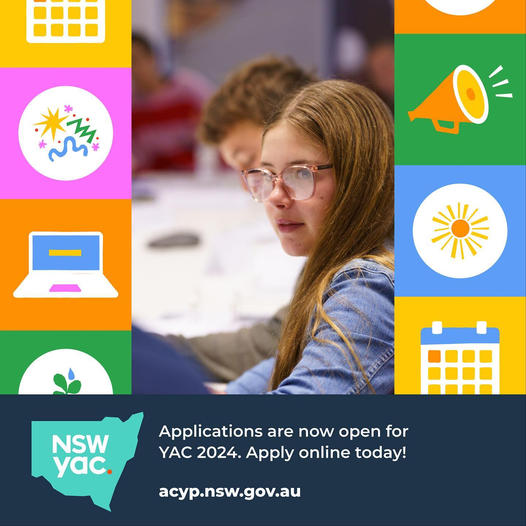 The NSW Youth Advisory Council (YAC) plays an important role in advising the NSW Government on issues that are relevant to young people across the state.
The NSW Youth Advisory Council (YAC) plays an important role in advising the NSW Government on issues that are relevant to young people across the state.- Advise the Minister and the Advocate on the planning, development, integration and implementation of government policies and programs concerning young people.
- Consult with young people, community groups and government agencies on issues and policies concerning young people.
- Monitor and evaluate legislation and government policies and programs concerning young people and recommend changes if required.
- Conduct forums, approved by the Minister, on issues of interest to young people.
- Collect, analyse and provide the Minister and the Advocate with information on issues and policies concerning young people.
The Big Bike Film Night At Warriewood
Surfing NSW Supports The New Wave Of Female Surf Coaches And Judges

Surfing NSW is pleased to announce that it has received funding from the NSW Government’s ‘Investing in Women’ initiative. The funding will go towards Surfing NSW’s Coaching Career Development Strategy, aimed at improving economic opportunities and advancement for women and supporting diverse and flexible employment opportunities for women in NSW.
The Coaching Career Development Strategy is focused on increasing opportunities for women and girls in the area of surf coaching. It will grow and open pathways for women who may wish to enter or return to the surf industry. The initiative will increase the number of women coaches and encourage and develop the participation of females in the sport.
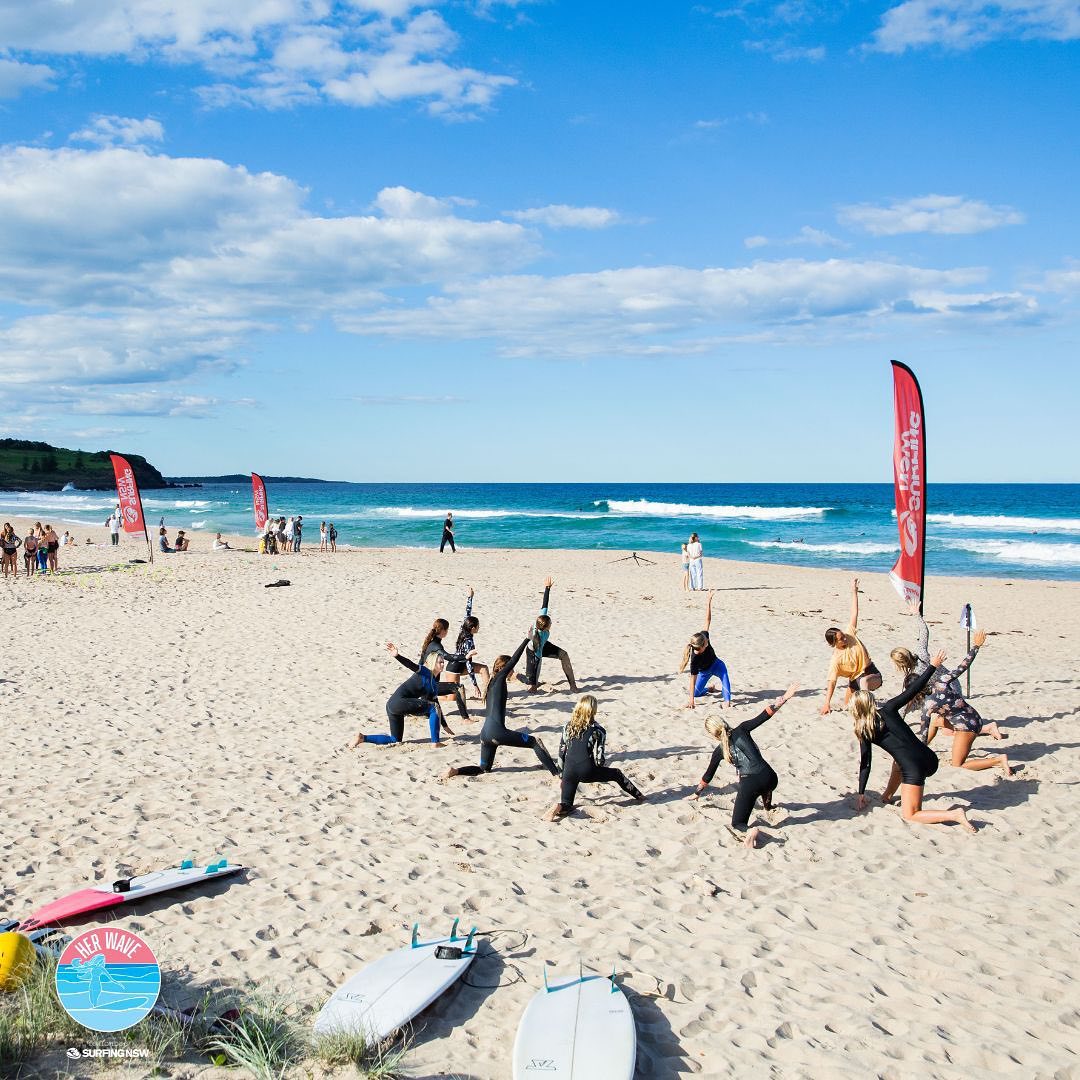
“We are thrilled to receive this funding from the NSW Government’s ‘Investing in Women’ initiative,” said Matt Lawson, Surfing NSW’s Head of Programs and Community. “This funding will enable us to expand our Coaching Career Development Strategy and create more opportunities for women to pursue a career in the surf industry. We are committed to promoting gender equality and empowering women in surfing, and this funding will help us achieve our goals.”
The funding comes after the recent success of the Her Wave Teams Classic events, two weekend events that saw over 500 females participate in surfing, with an all-female judging panel. The success of these events highlights the growing interest in women’s surfing and the need for greater opportunities for women in the sport.
“We are excited to build on the success of the Her Wave Teams Classic events and use this funding to support the development of women in surfing,” said Kate Cass, General Manager at Surfing NSW. “We believe that this initiative will not only increase the number of female coaches but also create a more inclusive and diverse surfing community.”

The Coaching Career Development Strategy is part of Surfing NSW’s commitment to creating a better community through surfing. The goal is to increase the number of coaches that are desperately needed within our system, by supporting the interest and need for females to be included in this space. Surfing NSW looks forward to working with the NSW Government and surfing community to create a more equitable future for passionate members.
Under the Surfing NSW Her Wave banner, this crucial funding provides the organisation with the opportunity to provide 150 aspiring female coaches to undertake the necessary courses to be accredited for free.
The Foundation Surf Coaching Course will increase the number of female coaches in NSW by 150, in addition to the surf coaching course Surfing NSW is offering a range of other training and accreditation courses that will equip coaches with crucial knowledge and expertise in this field.
These courses include:
- CPR
- First Aid
- Surf Safety Supervisor Course
- Surfers Rescue 24/7 Course
- Spinal Management
- Trauma Bleeding Control Overview.
Surfing NSW will then organise to provide this training in regions where the applying coaches reside. Collectively the above resources and training are valued at over $600 per person.
For more information on the free foundation courses, please email Surfing NSW’s Programs and Community Manager, Adam Seminara at adams@surfingnsw.com.au or apply via the link here.

History Of The Harbord Beach Tramline
By BackTracks Channel more in; Tram Memorabilia - Historic Daylight Run For Sydney Light Rail Begins 80 Years After Last Tram To Narrabeen Closed - 2018 PON History page
Webb Looks For Fomalhaut's Asteroid Belt And Finds Much More

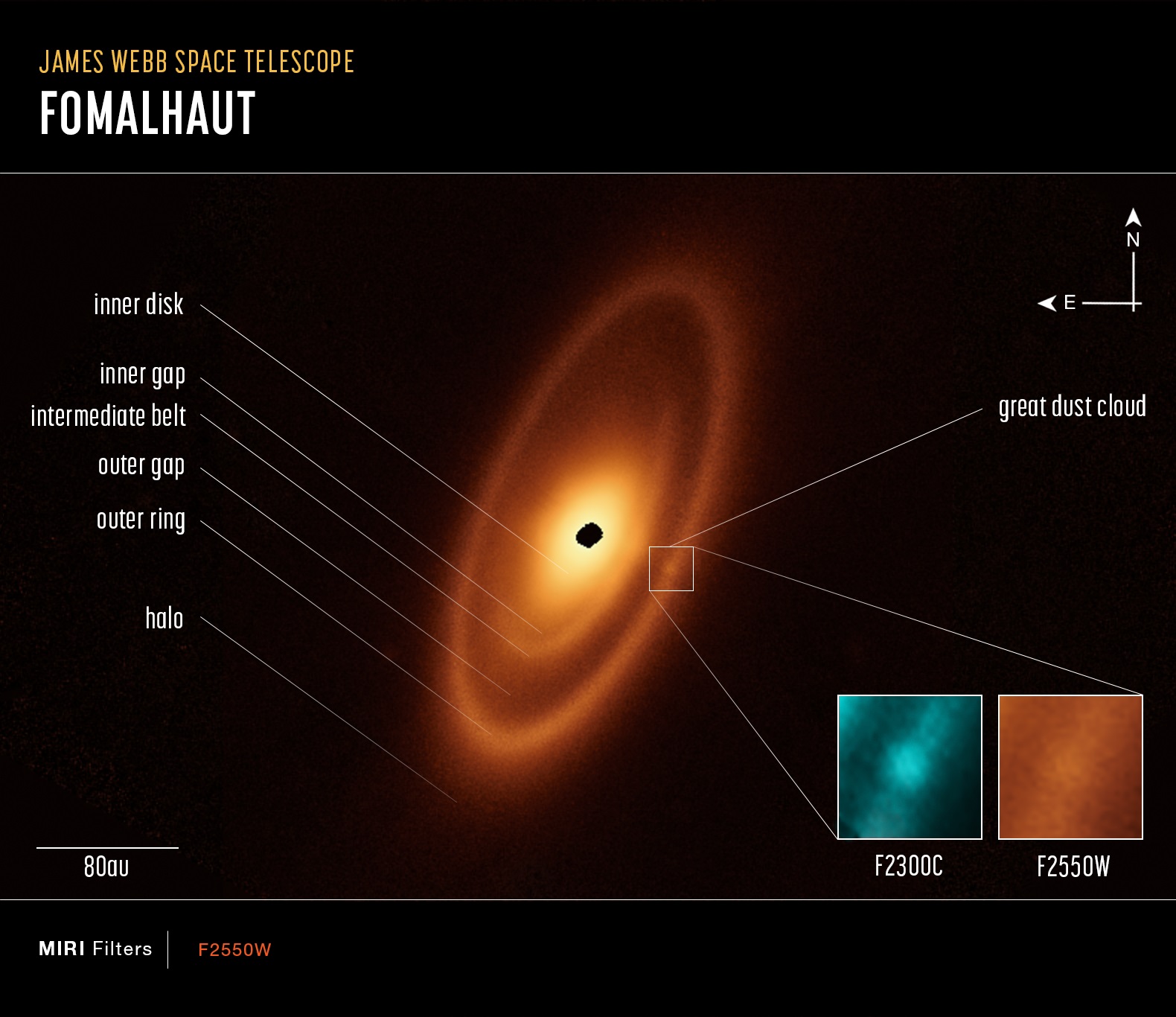
School Leavers Support
- Download or explore the SLIK here to help guide Your Career.
- School Leavers Information Kit (PDF 5.2MB).
- School Leavers Information Kit (DOCX 0.9MB).
- The SLIK has also been translated into additional languages.
- Download our information booklets if you are rural, regional and remote, Aboriginal or Torres Strait Islander, or living with disability.
- Support for Regional, Rural and Remote School Leavers (PDF 2MB).
- Support for Regional, Rural and Remote School Leavers (DOCX 0.9MB).
- Support for Aboriginal and/or Torres Strait Islander School Leavers (PDF 2MB).
- Support for Aboriginal and/or Torres Strait Islander School Leavers (DOCX 1.1MB).
- Support for School Leavers with Disability (PDF 2MB).
- Support for School Leavers with Disability (DOCX 0.9MB).
- Download the Parents and Guardian’s Guide for School Leavers, which summarises the resources and information available to help you explore all the education, training, and work options available to your young person.
School Leavers Information Service
- navigate the School Leavers Information Kit (SLIK),
- access and use the Your Career website and tools; and
- find relevant support services if needed.
Word Of The Week: Hope
noun
from late Old English hopa "confidence in the future," especially "God or Christ as a basis for hope," from hope (v.). From c. 1200 as "expectation of something desired;" also "trust, confidence; wishful desire;" late 14c. as "thing hoped for," also "grounds or basis for hope." Personified since c. 1300. Compare Old Frisian and Middle Dutch hope, Danish haab, Dutch hoop, all from their respective verbs. ARCHAIC: a feeling of trust.
Compare; In English, hope is a somewhat abstract idea of expectation. The word for hope in Hebrew, Tikvah, is more concrete. In Hebrew, the word means expectation—and it also means cord or rope, which comes from a root word that means to bind or to wait for or upon.
verb
Old English hopian "have the theological virtue of Hope; hope for (salvation, mercy), trust in (God's word)," also "to have trust, have confidence; assume confidently or trust" (that something is or will be so), a word of unknown origin. Not the usual Germanic term for this, but in use in North Sea Germanic languages (cognates: Old Frisian hopia, Middle Low German, Middle Dutch, Dutch hopen; Middle High German hoffen "to hope," which is borrowed from Low German).
Hope is also a given name derived from the Middle English hope, ultimately from the Old English word hopian referring to a positive expectation or to the theological virtue of hope. It was used as a virtue name by the Puritans. Puritans also used Hope as an element in phrase names, such as Hope-for, Hopeful, and Hope-still.
Faith, Hope and Charity, the three theological virtues, are names traditionally given to triplet girls, just as Faith and Hope remain common names for twin girls.
Hope is an optimistic state of mind that is based on an expectation of positive outcomes with respect to events and circumstances in one's life or the world at large. As a verb, its definitions include: "expect with confidence" and "to cherish a desire with anticipation".
Hope, and more specifically, particularised hope, has been shown to be an important part of the recovery process from illness; it has strong psychological benefits for patients, helping them to cope more effectively with their disease. For example, hope motivates people to pursue healthy behaviours for recovery, such as eating fruits and vegetables, quitting smoking, and engaging in regular physical activity. This not only helps to enhance people's recovery from illnesses but also helps prevent illness from developing in the first place. Patients who maintain high levels of hope have an improved prognosis for life-threatening illness and an enhanced quality of life. Belief and expectation, which are key elements of hope, block pain in patients suffering from chronic illness by releasing endorphins and mimicking the effects of morphine. Consequently, through this process, belief and expectation can set off a chain reaction in the body that can make recovery from chronic illness more likely. This chain reaction is especially evident with studies demonstrating the placebo effect, a situation when hope is the only variable aiding in these patients’ recovery.
Overall, studies have demonstrated that maintaining a sense of hope during a period of recovery from illness is beneficial. Additionally, having a greater amount of hope before and during cognitive therapy has led to decreased PTSD-related depression symptoms in war veterans. Hope has also been found to be associated with more positive perceptions of subjective health.
Hope is the thing with feathers that perches in the soul and sings the tune without the words and never stops at all. — Emily Dickinson
A classic reference to hope which has entered modern language is the concept that "Hope springs eternal" taken from Alexander Pope's Essay on Man, the phrase reading "Hope springs eternal in the human breast, Man never is, but always to be blest:" Another popular reference, "Hope is the thing with feathers," is from a poem by Emily Dickinson.
The swallow has been a symbol of hope, in Aesop's fables and numerous other historic literature. It symbolizes hope, in part because it is among the first birds to appear at the end of Winter and the start of Spring. Other symbols of hope include the anchor and the dove.
Professor of Psychology Barbara Fredrickson argues that hope comes into its own when crisis looms, opening us to new creative possibilities. Frederickson argues that with great need comes an unusually wide range of ideas, as well as such positive emotions as happiness and joy, courage, and empowerment, drawn from four different areas of one's self: from a cognitive, psychological, social, or physical perspective. Hopeful people are "like the little engine that could, [because] they keep telling themselves "I think I can, I think I can". Such positive thinking bears fruit when based on a realistic sense of optimism, not on a naive "false hope".
The psychologist Charles R. Snyder linked hope to the existence of a goal, combined with a determined plan for reaching that goal. As a specialist in positive psychology, Snyder studied how hope and forgiveness can impact several aspects of life such as health, work, education, and personal meaning. He postulated that there are three main things that make up hopeful thinking:
- Goals – Approaching life in a goal-oriented way.
- Pathways – Finding different ways to achieve your goals.
- Agency – Believing that you can instigate change and achieve these goals.
In other words, hope was defined as the perceived capability to derive pathways to desired goals and motivate oneself via agency thinking to use those pathways. Snyder argues that individuals who are able to realise these three components and develop a belief in their ability are hopeful people who can establish clear goals, imagine multiple workable pathways toward those goals, and persevere, even when obstacles get in their way.
Derived from Wikipedia

Georgiana Maria Leicester as Hope, by Thomas Lawrence, c. 1811
Mothers’ lives in ancient Greece were not easy – but celebrations of their love have survived across the centuries

As a father of three and the husband of an amazing woman, I know that one day a year is far too little to recognize everything mothers do. But my work as a scholar of ancient Greek literature has shown me how much harder it was to be a mother in antiquity.
The ancient Greeks may not have had the kind of Mother’s Day celebrated in the United States and United Kingdom today – holidays that began at the turn of the 20th century and in the Middle Ages, respectively. But they did have festivals to honor motherhood, focused primarily on the goddess Hera or the earth mother Cybele – though more often than not, women did the lion’s share of the labor for those events.
The stories that remain of both real and mythical mothers let us know how important they were. Thanks in part to their connection to the life cycle, women in ancient Greece were both symbols of mortality and a force to humanize heroes.
Historical Lives
What we know of women’s lives in ancient Greece is generally not good. According to the poet Hesiod, typically dated to around 700 B.C., it was thought good practice for women to be married off to older men “four or five years after puberty.” Philosophical and medical traditions of the time saw women as inferior and defined by their ability to give birth, even though the popular notion was that male semen contained everything needed for a baby.
We have uncertain evidence for what lives were like after marriage. Some accounts estimate an average of six births per woman, and as many as 40% of infants may not have survived to a marriageable age, though estimates of infant mortality vary. Most historians agree that child loss was common enough in antiquity to be an expectation rather than a surprise.

Information about maternal mortality is equally obscure, though demographic data suggests that at times more than 30% of mothers died from complications related to childbirth. But there is anecdotal evidence from funeral inscriptions gathered from all over antiquity’s Greek-speaking world. The 21-year-old Prakso, wife of Theocritus, died in labor and left a 3-year-old behind. Kainis died from prolonged childbirth at 20, “just barely experienced in life.” Plauta also passed away at 20, during her second birth – but her fame “sings on, as deep as her dear husband’s endless grief,” according to her tombstone.
Classics students often learn that ancient Greek men did not usually spend much time with very young children, given the high rate of loss. Some ritual practices may have been responses to the precariousness of early life, such as holding a naming ceremony only on the 10th day after birth or officially registering the child as a member of the father’s family in municipal records during the first year.
As a parent, however, I am less convinced that high rates of loss led parents to be more distant. I suspect that the sense of uncertainty made children more precious to all family members and that those early years only tightened the bonds between mothers and children in particular.
Women In Stories
When people think of the field I study, epic poetry, I suspect they generally think of violent male heroes and victimized women. While this image is certainly not wrong, it overlooks other ways that women, and mothers in particular, were crucial to the world of Greek poetry and myth.
Ancient Greece had a whole genre of catalog poetry – basically, lists of people and their stories in brief – dedicated to telling the stories of heroic families based on brides and mothers, which helped humanize heroes for their audiences.

In “The Odyssey,” for example, Odysseus taps into this tradition during a voyage to the underworld and tells the stories of all the heroic mothers he met among the dead – listing his own mother as one of the first. During his brief visit to speak with the dead, he learns that his mother, Anticleia, died of a broken heart over his long absence. And throughout the epic, Odysseus spends much of his time struggling to get home to Penelope: his wife, but also a protective mother of their son, Telemachus.
In “The Iliad,” the powerful warrior Achilles’ mother, Thetis, is instrumental in appealing to Zeus on his behalf when Agamemnon, the leader of the Greeks, dishonors him. Once the almost invincible fighter goes to face Hektor, Thetis laments his short life nearing its end.

Throughout the stories of war and honor in “The Iliad,” mothers remind listeners of the real consequences of war. In one arresting moment, Hektor, the prince of Troy, waits to face Achilles and likely death. Hecuba, his mother, stands on the walls of the city and bares her breast to her son, begging him to remember the care he received from her and to stay in the city to protect her.
But the one scene that has driven me to tears are the words of Hektor’s wife, Andromache, after she learns of her husband’s death. She laments their son’s future suffering as an orphan, denied a seat at other men’s tables, left to wander and beg. This moment was even more heart-wrenching for ancient audiences who knew the fate of their son, Astyanax: After Troy fell to the Greeks, he was hurled from the walls of the city.
Heroic mothers helped ancient Greeks define themselves and understand their place in the world, almost always to their own detriment. They remind listeners of the meaning of labor and sacrifice.
As a son, as well as a father, I know how complex family relationships can get. We generally see the modern world as being so very different from the past, but there is still little in human life as transformative as giving birth or raising a child.
Some words from ancient playwrights drive home how much remains the same. In one fragment, referred to as 685, Sophocles claims that “children are the anchors of a mother’s life.” In a fragment of his own, 358, Euripides writes, “Love your mother, children, there’s no love anywhere that could be sweeter than this.”![]()
Joel Christensen, Professor of Classical Studies, Brandeis University
This article is republished from The Conversation under a Creative Commons license. Read the original article.
Here’s why The Legend of Zelda: Tears of the Kingdom is big news – even among those who don’t see themselves as ‘gamers’

Early this morning, millions of people around the world rushed to their Nintendo Switch to play The Legend of Zelda: Tears of the Kingdom and immerse themselves anew in this game’s vast, mythical kingdom of Hyrule.
This fresh release, a sequel to 2017’s The Legend of Zelda: Breath of the Wild, has been long awaited by Zelda fans around the globe, and the subject of breathless coverage in both specialist gaming media and the mainstream press.
So, why is this game such big news – even among those who don’t necessarily see themselves as “gamers”?
I’m a game design researcher focused on creating and developing systems that allow games to be played by anyone – and there cannot be a better example of that than The Legend of Zelda: Tears of the Kingdom.
Who Is This Game For?
This game situates itself in the action-adventure genre, but that descriptor only scratches the surface. It offers an unparalleled open world, both in size and detail, and is uniquely able to cater to a huge audience.
Want to explore and discover a breathtakingly beautiful world? This game has you covered. Want to absorb a rich story built up over many years? This game lets you do that. Want to test your mettle and take down tough foes? This game is for you.
From the limited game play footage already released, it’s obvious Tears of the Kingdom allows the player to use their critical thinking skills to overcome puzzles their own way.
Taken together, Tears of the Kingdom and Breath of the Wild suggest Nintendo is pioneering a model focused on inclusivity and approachability. Players can take things at their own pace. The open-world exploration, engaging storytelling, mind-bending challenges and serene atmosphere draw audiences ranging from franchise veterans to those completely new to games.
Accessibility and creativity combine to give players an unparalleled level of freedom. The puzzles around every corner of the kingdom of Hyrule make this game compelling for newcomers and old hands alike.
What Is The Legend Of Zelda: Tears Of The Kingdom?
Despite the franchise name, the game’s protagonist is the young knight Link (Zelda is the name of the princess he must help to set free). His task is to save the mythical kingdom of Hyrule by ridding it of the tyrannical overlord Ganon. In the previous game, Link must travel across the kingdom, seeking aid from the diverse species and tribes of the lands to uproot and vanquish Ganon.
From the promotional videos and early game play footage of the new game, we know Ganon has returned and Link must embark on a new adventure to defeat him.
To do so, players must navigate and explore new mysterious sky islands high above Hyrule, as well as the familiar sprawling landscapes of the previous game.
With the shift to the skies, Link has also received an updated suite of skills. He can now rewind time, ascend through ceilings, and – most importantly – combine items to create new and exciting weapons or vehicles.
This game allows you to combine real-world and in-game knowledge to literally invent your own solutions.
Why Was Breath Of The Wild Such A, Well, Game-Changer?
The Legend of Zelda: Breath of the Wild caused genre-defining waves when it was released in 2017, forcing many to rethink what an open world game is.
Most open world games at the time featured much more linear narratives, forcing players to experience the world one small area after another. Many blocked players from content until they have progressed further in the story. This denies players from the freedom and choice Breath of the Wild relishes in.
At its core, Breath of the Wild allows you to do what you want, when you want, without forcing you down a particular path. After brief tutorials, you’re off on your quest to find Ganon – but what you do between now and then is completely up to you. You can spend the entire time picking and cooking mushrooms, if you like.
Subtle environmental cues help deliver a gripping narrative, and there are plenty of side quests along the way. Players who want the story can seek it out, while those who’d rather skip it are free to wander around deserts, oceans, forests and plains on their own personal voyage.
Another reason this game garnered such a vast and loyal fanbase is it allows players to do as much or as little as they feel up to that day.
Had a hard week and just want to relax? You can take to the skies with your paraglider and soar around breathtaking landscapes or hop on your horse to explore the nooks and crannies of Hyrule. In the mood for a challenge? Try your hand at one of hundreds of expertly designed puzzles (many of which have more than one solution). Keen for some biffo? Battle one of Ganon’s minions or practise your skills with a new weapon.
Unplanned interactions between game characters, landscapes or puzzles abound. That’s how this game can keep surprising even those players who have sunk hundreds of hours into it.
“What would happen if I do this?” you ask. This game always has an answer.
What Do We Know So Far About Tears Of The Kingdom?
Building on the previous game’s focus on discovery, players in The Legend of Zelda: Tears of the Kingdom will be spending a lot of time exploring the mysterious sky islands floating high above the land, bringing both new challenges and stunning scenery.
Players will have a range of new abilities that focus on invention and experimentation. Using the new “fuse” ability, you can combine a weapon with items found throughout the game to create new possibilities. Found a spiky metal ball? Why not stick it to the end of your sword and see what it does?
The new “ultrahand” feature allows you to combine a huge variety of vehicle components and in-game objects to create vehicles. Found a wooden board drifting in the ocean? Attach some fans, a sail and voilà! You’ve got a powerboat.
This allows player to apply knowledge from the real world and the game world to come up with creative solutions.
This game is extremely approachable, yet has the depth to keep players interested for years to come. ![]()
Padraic Heaton, Casual Academic, University of Technology Sydney
This article is republished from The Conversation under a Creative Commons license. Read the original article.
How fast is the Universe really expanding? Multiple views of an exploding star raise new questions
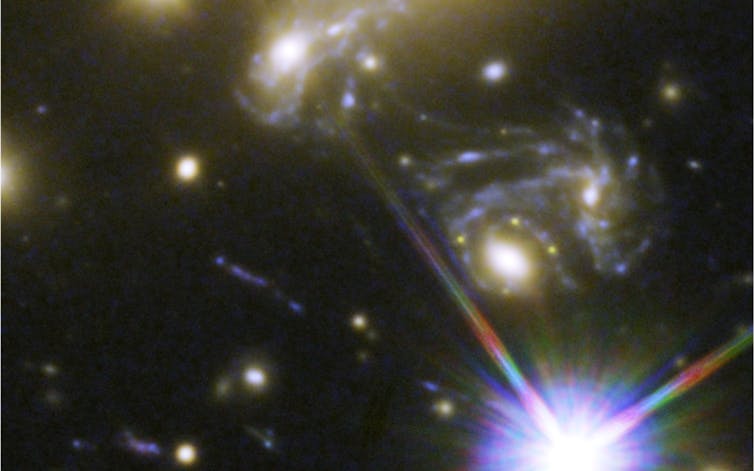
How did we get here? Where are we going? And how long will it take? These questions are as old as humanity itself, and, if they’ve already been asked by other species elsewhere in the Universe, potentially very much older than that.
They are also some of the fundamental questions we are trying to answer in the study of the Universe, called cosmology. One cosmological conundrum is how fast the Universe is expanding, which is measured by a number called the Hubble constant. And there is quite a bit of tension around it.
In two new papers led by my colleague Patrick Kelly at the University of Minnesota, we have successfully used a new technique – involving light from an exploding star that arrived at Earth via multiple winding routes through the expanding Universe – to measure the Hubble constant. The papers are published in Science and The Astrophysical Journal.
And if our results don’t quite resolve the tension, they do give us another clue – and more questions to ask.
Standard Candles And The Expanding Universe
We have known since the 1920s that the Universe is expanding.
Around 1908, US astronomer Henrietta Leavitt found a way to measure the intrinsic brightness of a kind of star called a Cepheid variable – not how bright they appear from Earth, which depends on distance and other factors, but how bright they really are. Cepheids grow brighter and dimmer in a regular cycle, and Leavitt showed the intrinsic brightness was related to the length of this cycle.
Leavitt’s Law, as it is now called, lets scientists use Cepheids as “standard candles”: objects whose intrinsic brightness is known, and therefore, whose distance can be calculated.

How does this work? Imagine it is night, and you are standing on a long, dark street with only a few light poles going down the road. Now imagine every light pole has the same type of light bulb, with the same power. You’ll notice the distant ones appear fainter than the nearby ones.
We know that light fades proportionately to its distance, in something called the inverse-square law for light. Now, if you can measure how bright each light appears to you, and if you already know how bright it should be, you can then figure out how far away each light pole is.
In 1929, another US astronomer, Edwin Hubble, was able to find a number of these Cepheid stars in other galaxies and measure their distance – and from those distances and other measurements, he could determine that the Universe was expanding.
Different Methods Give Different Results
This standard candle method is a powerful one, allowing us to measure the vast Universe. We are always looking for different candles that can be better measured, and seen at much greater distances.
Some recent efforts to measure the Universe further from Earth, like the SH0ES project I was a part of, led by Nobel laureate Adam Riess, have used Cepheids alongside a type of exploding star called a Type Ia supernova, which can also be used as a standard candle.
There are also other methods to measure Hubble’s constant, such as one that uses the cosmic microwave background – relic light or radiation that began to travel through the Universe shortly after the Big Bang.
The problem is that these two measurements, one nearby using supernovae and Cepheids, and one much farther away using the microwave background, differ by nearly 10%. Astronomers call this difference the Hubble tension, and have been looking for new measurement techniques to resolve it.
A New Method: Gravitational Lensing

In our new work, we have successfully used a new technique to measure this expansion rate of the Universe. The work is based on a supernova called Supernova Refsdal.
In 2014, our team spotted multiple images of the same supernova – the first time such a “lensed” supernova had been observed. Instead of the Hubble Space Telescope seeing one supernova, we saw five!
How does this happen? The light from the supernova went out in all directions, but it travelled through space warped by the enormous gravitational fields of a huge cluster of galaxies, which bent some of the light’s path in such a way that it ended up coming to Earth via multiple routes. Each appearance of the supernova had reached us along a different path through the Universe.
Imagine three trains leaving the same station at the same time. However, one goes directly to the next station, the other makes a wide trip through the mountains, and another via the coast. They all leave and arrive at the same stations, but take different trips and so while they leave at the same time, they will arrive at different times.

So our lensed images show the same supernova, that exploded at one certain point in time, but each image has travelled a different path. By looking at the arrival at Earth of each appearance of the supernova – one of which happened in 2015, after the exploding star had been spotted already – we were able to measure their travel time, and therefore how much the Universe had grown while the image was in transit.
Are We There Yet?
This gave us a different, but unique measurement of the growth of the Universe. In the papers, we find this measurement is closer to the cosmic microwave background measurement, rather than the nearby Cepheid and supernova measurement. However, based on its location, it should be closer to the Cepheid and supernova measurement.
While this does not settle the debate at all, it gives us another clue to look at. There could be a problem with the supernova value, or our understanding of galaxy clusters and the models to apply to lensing, or something else entirely.
Like the kids in the back of the car on a road trip asking “are we there yet”, we still don’t know.![]()
Brad E Tucker, Astrophysicist, Australian National University
This article is republished from The Conversation under a Creative Commons license. Read the original article.
Australia has a National Quantum Strategy. What does that mean?

Imagine a world where computers can solve complex problems in seconds, making our current devices seem like mere typewriters. These supercomputers would revolutionise industries, create new medicines, and even help combat climate change.
Imagine as well we could observe the workings of our own bodies in unprecedented detail, and communicate online without fear of hacking. This may be starting to sound like a sci-fi novel, but quantum technologies have the potential to make it all real.
Australia has just unveiled its first National Quantum Strategy. The strategy aims to make Australia “a leader of the global quantum industry” by 2030, by encouraging research, applications and commercialisation.
So what does that actually mean?
What Are Quantum Technologies?
Quantum technologies build on the science of quantum mechanics, which studies the behaviour of subatomic particles at a microscopic scale.
At this level, particles behave strangely: they can exist in multiple states simultaneously (called superposition), and be “entangled” with each other. When particles are entangled, their properties are linked together regardless of the distance between them.
Quantum technologies make use of these counterintuitive properties to achieve things that might otherwise be impossible. Three main areas of quantum technology are gaining the most attention: quantum sensing, quantum communications, and quantum computing.
Quantum sensing can detect tiny changes in the environment, measuring things like gravity, magnetic fields and temperature with incredible accuracy. This technology could have a huge impact on industries like healthcare, mining and navigation.
For instance, quantum sensors may be able to help us detect early signs of diseases in our bodies and locate valuable minerals hidden deep underground.
Unlike traditional computers, which store and process information using bits (zeroes and ones), quantum computers use “qubits”, which can exist as zeroes, ones, or combinations of both at once.

Fully functioning quantum computers don’t exist yet – but scientists believe they will be able to perform certain kinds of calculations at lightning speed, solving some problems that would take today’s computers millions of years to crack. This would have huge implications for fields including cryptography, AI, drug discovery, and climate modelling.
Researchers are also working on super-secure quantum communication networks that are almost impossible to hack or eavesdrop on. On networks like these, attempts to intercept messages would be instantly detectable to the sender and the receiver.
The Quantum Race
Australia’s National Quantum Strategy sees us join other countries and regions, racing to unlock the potential of quantum technology and dominate the market. The United States, China, and Europe are investing billions of dollars in quantum research and development.
If Australia wants to keep up, it needs to act now. But why is keeping up so important?
First, we don’t want to be left behind in the rapidly growing quantum technology industry. According to CSIRO projections, the quantum industry could be worth A$4.6 billion by the end of the decade. By 2045, it might employ as many people as the oil and gas sector does today, with revenues of $6 billion and 19,400 direct jobs.
As other nations push forward, Australia risks missing out on the potential economic benefits. We could also lose talented workers to countries that are investing more in quantum research. Projects like the ambitious attempt to build the world’s first complete quantum computer aim to provide local opportunities and funding alongside their top-line goals.
Moreover, Australia has a responsibility to ensure quantum technologies are developed and used ethically, and their risks managed.
For example, quantum computers could enable hackers to break existing encryption protocols, leaving internet services vulnerable. Data harvesting by companies is already a concern, and quantum computing could exacerbate this issue. Even national security could be jeopardised by quantum decryption.
Responsible Innovation
To make the most of the power of quantum technology, we need to be proactive, focus on the public good, and think about it from many perspectives to ensure “responsible innovation”.
Collaboration and broad dialogue will be necessary. Conversations between experts in fields like quantum computing, cybersecurity, ethics and social sciences – perhaps via regular conferences or workshops – will help us tackle the technical and ethical risks.
Engaging with society and focusing on the public good will also be essential. The public must be involved in discussions to ensure new quantum technologies benefit everyone, not just businesses. Town hall meetings, public forums or online chats can help scientists, policymakers and citizens share views.
And we must make sure that “responsibility” always sits right alongside “innovation” in quantum technologies. Organisations working on quantum tech could have “responsible quantum committees” to address risks and involve stakeholders, ensuring responsible innovation in quantum technology.
Success in quantum technology will be all about striking the right balance: encouraging both innovation and responsibility. By investing in quantum technology and working together to ensure its responsible development, Australia can continue to be a leader in scientific innovation while benefiting from these emerging technologies’ transformative potential.
Australia’s National Quantum Strategy is a step in this direction.![]()
Jarryd Daymond, Lecturer, University of Sydney
This article is republished from The Conversation under a Creative Commons license. Read the original article.
What’s the latest on GMOs and gene-edited foods – and what are the concerns? An expert explains
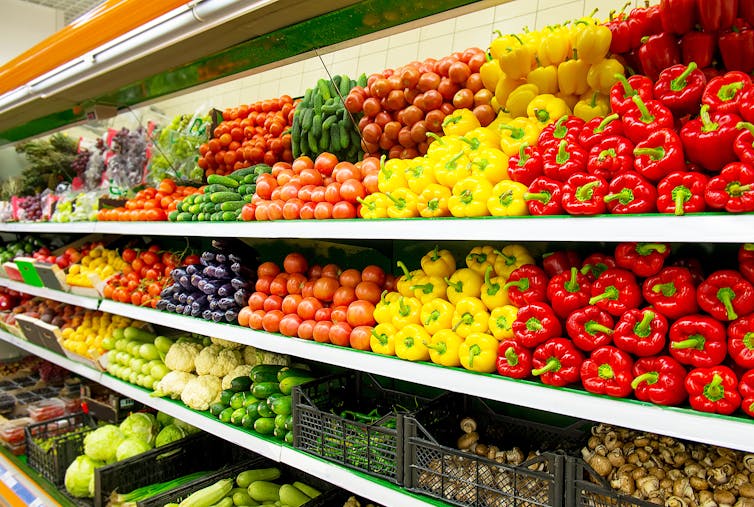
Advances in genetic engineering have given rise to an era of foods – including genetically modified organisms (GMOs) and gene-edited foods – that promise to revolutionise the way we eat.
Critics argue these foods could pose risks to human health and the environment. Proponents point to their potential for enhancing yields, reducing food waste, and even combating climate change.
What are GMOs and gene-edited foods? And how are they shaping the future of our food systems?
GMOs And Gene-Edited Foods Aren’t The Same
GMOs are organisms whose genetic material has been artificially altered by inserting a piece of foreign DNA. This DNA may be synthetic in origin or sourced from other organisms.
Gene editing involves making precise changes to an organism’s genome without the integration of foreign DNA elements. Using techniques such as CRISPR/Cas, scientists make precise “cuts” in the DNA to create new genetic variation. Unlike with GMOs, this introduces only minor modifications, which are indistinguishable from natural mutations.
Although GMOs and gene-edited foods have been in circulation for almost three decades, research in this space continues to deliver breakthroughs. These technologies are being applied to provide a range of benefits, from improved nutrition in food, to reduced food waste and increased crop tolerance against climate stresses.
What Are The Concerns?
The major criticisms of GMOs are related to the overuse of specific herbicides.
GMOs are mainly used to produce crops that are herbicide-resistant or produce pesticides. Farmers can then use herbicides on those crops to control weeds more effectively, without the plants themselves dying. This leads to higher yields on less land, and often with less chemicals used overall.
However, these crops rely on the use of said lab-made chemicals. And although the government regulates them, ethical and safety debates continue. People raise concerns over potential long-term health impacts, impacts on biodiversity and ecosystems, and the increased corporate control over agriculture.
Concerns generally aren’t related to the actual manipulation of the plants’ DNA.
Is Genetic Modification Itself Unsafe?
When it comes to the food we eat, how much do we really know about its DNA? Even among experts with genome-sequencing information, most have only one or a few sequenced “reference” varieties, and these often aren’t the same as the plants we eat.
The fact is, we don’t really understand the genomes of many plants and animals we eat. So there’s no reason to suggest tweaking their gene sequences will make consumption harmful. Moreover, there’s currently no evidence regulator-approved GMOs or gene-edited foods aren’t safe for human consumption.
In regards to food safety, one valid concern would be the potential creation of new allergens: proteins within the crop the body recognises and creates an immune response to.
But it’s important to remember many foods we eat are already allergenic. Common examples include wheat, peanuts, soy, milk and eggs. Some common foods are even toxic if consumed in large quantities or without appropriate preparation, such as rhubarb leaves, raw cassava, raw kidney beans and raw cashews.
Ironically, researchers are using gene editing to work towards eliminating proteins that cause allergies and intolerances. Gluten-free wheat is one example.
GMOs And Gene-Edited Foods Are Widespread
Due to inconsistent rules about labelling GMOs and gene-edited foods around the world, many consumers may not realise they’re already eating them.
For example, the most widely used enzyme in cheese-making, rennet, is produced from a GMO bacterium. GMO microbial rennet produces a specific enzyme called chymosin, which helps coagulate milk and form curds. Historically, chymosin was extracted from young cow stomachs, but in the 1990s scientists managed to genetically engineer a bacterium to synthesise it.
GMOs and gene-edited cereal and oilseed products are also widely used in stockfeeds. There is ongoing research to improve feed through enhanced nutrition, and produce crops that will decrease methane emissions from cattle.
When it comes to modifying animals themselves, ethical considerations must be balanced alongside potential benefits.
In Australia, about 70% of cattle are genetically polled (hornless). Having polled cows improves meat quality through less injury to meat, and is considered better for animal welfare. In the US, fast-growing genetically modified salmon has been approved for consumption.
In a horticultural context, the genetically modified rainbow papaya stands out. It was developed in the late 1990s in response to a ringspot virus outbreak that nearly wiped out the global papaya industry. Researchers created the virus-resistant “transgenic” papaya, which now makes up the majority of papayas consumed worldwide.
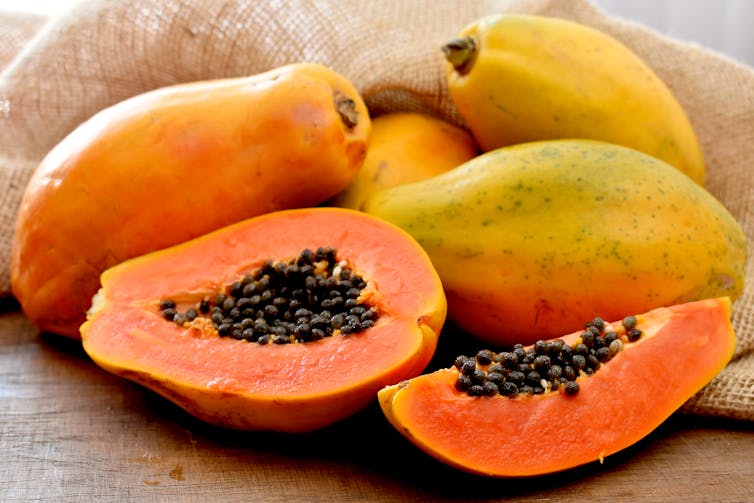
In terms of boosting nutritional content, “golden rice” biofortified with Vitamin A (GMO) is being cultivated in the Philippines, as are tomatoes biofortified with Vitamin D (GE) in the United Kingdom, and GABA-enriched tomatoes (GE) in Japan.
Research is also being done to create non-browning mushrooms, apples and potatoes. A simple gene edit can help inhibit the browning oxidation reaction, leading to a longer shelf-life and less food waste.
Regulation In Australia And New Zealand
So why don’t you see non-browning mushrooms at your local supermarket?
In Australia, the Office of the Gene Technology Regulator regulates GMOs. It has approved four GMO crops for cultivation: cotton, canola, safflower and Indian mustard. However, many more are imported for food ingredients (including modified soy, cottonseed oil, corn and sugar beet) and stockfeed (canola, maize and soy).
Gene-edited foods can be cultivated without any regulatory restrictions or labelling in Australia. The Gene Technology Act 2000 deregulated these products in 2019.
On the other hand, New Zealand’s Environmental Protection Authority has maintained regulatory restrictions on both gene-edited foods and GMOs. Divergent definitions have led the bi-national agency Food Standards Australia New Zealand (FSANZ) to adopt a cautious approach, regulating gene-edited foods and feeds as GMOs.
The lack of alignment in definitions in Australian has confused producers and consumers alike. FSANZ has said it will continue to monitor developments in gene-editing technology, and will consider reviewing its regulatory approach.
Responsible Research
Both GMOs and gene-edited foods offer great promise. Of course there are valid concerns, such as the potential to create new allergens, unintended consequences for ecosystems, and growing corporate control over food. But these can be addressed through responsible research and regulatory frameworks.
Ultimately, the development of future foods must be guided by a commitment to sustainability, social justice and scientific rigour.![]()
Karen Massel, Research Fellow, Centre for Crop Science, The University of Queensland
This article is republished from The Conversation under a Creative Commons license. Read the original article.
Gen Z goes retro: Why the younger generation is ditching smartphones for ‘dumb phones’

There is a growing movement among Gen Z to do away with smartphones and revert back to “less smart” phones like old-school flip and slide phones. Flip phones were popular in the mid-1990s and 2000s, but now seem to be making a comeback among younger people.
While this may seem like a counter-intuitive trend in our technology-reliant society, a Reddit forum dedicated to “dumb phones” is steadily gaining in popularity. According to a CNBC new report, flip phones sales are on the rise in the U.S.
Gen Z’s interest in flip phones is the latest in a series of obsessions young people are having with the aesthetic of the 1990s and 2000s. Y2K fashion has been steadily making a comeback over the past few years and the use of vintage technology, like disposable cameras, is on the rise.
There are a few reasons why, including nostalgia and yearning for an idealized version of the past, doing a “digital detox” and increasing privacy concerns.
The Power Of Nostalgia
Nostalgia is a complex emotion that involves reconnecting with the happy emotions of an idealized past by recalling positive memories.
Over the years, marketers have realized that nostalgia is a powerful way to evoke positive emotions — so much so that nostalgia marketing has become a recognized marketing strategy. It leverages positive memories and feelings associated with the past to create an emotional connection with consumers.
A wealth of research shows that nostalgia can result in consumers being willing to pay more, enhance brand ties, increased purchase intention and increased digital brand engagement.
Nostalgia may be a driving factor behind people purchasing flip phones because they evoke memories of a previous era in mobile communication.
But nostalgia marketing doesn’t just target the younger generation — it’s also a powerful tool for advertising to those who grew up using older mobile devices. Nokia is an example of a company that understands this well.
A YouTube advertisement for Nokia’s 2720 V Flip shows how brands can use nostalgia marketing to appeal to customers and drive product sales.
When older generations speak about objects from the past, they usually hearken back to “the golden era” or “golden time.” The comment section of the Nokia video showcases this kind of thinking.
One comment reads: “My first phone was a Nokia 2760! It was also a flip phone. This brings back good memories.” Another says: “I am definitely getting this just for good old memories. When life was easy.”
Digital Detox
Another reason why people might be purchasing flip phones is to do a digital detox and cut down on screen time. A digital detox refers to a period of time when a person refrains from using their electronic devices, like smartphones, to focus on social connections in the physical world and reduce stress.
In 2022, people in the U.S. spent more than 4.5 hours daily on their mobile devices. In Canada, adults self-reported spending about 3.2 hours per day in front of screens in 2022. Children and youth had about three hours of screen time per day in 2016 and 2017.
Excessive smartphone usage can result in a number of harmful side effects, such as sleep disruption. Just over 50 per cent of Canadians check their smartphones before they go to sleep.
The blue-light emitted from smartphones may suppress melatonin production, making it harder to sleep and causing physiological issues including reduced glucose tolerance, increased blood pressure and increased inflammatory markers.

The increased level of digital connectivity and the pressure to respond instantly, especially in a post-pandemic world where many people work remotely, can lead to increased levels of anxiety and stress. Being constantly online can also lead to reduced social connectivity and can negatively impact personal relationships and social skills.
The constant digital noise and multi-tasking nature of smartphones and apps like TikTok can lead to decreased attention spans. From my personal observations in the classroom, I’ve noticed students find it difficult to concentrate for prolonged periods of time.
A condition known as text neck can also occur when a person spends extended periods of time looking down at an electronic device. The repetitive strain of holding the head forward and down can cause discomfort and pain in the neck.
As people become more aware of the potential side effects of excessive screen time and constant digital connectivity, some are choosing to digitally detox. Flip phones are a way people can limit their exposure to digital noise and build a healthier relationship with technology.
Privacy Concerns
Smartphones have a long list of advanced features such as cameras, GPS and tons of mobile applications — all of which can store and access a significant list of personal data.
In some cases, personal data can be used for targeted advertisements, but in worst cases that information can be leaked as part of a data breach. More and more people are growing concerned with how their data is being collected, shared and used by companies and online platforms.

It’s natural to feel worried about the potential misuse of our personal information. That’s why some people are taking matters into their own hands and seeking out creative ways to limit the amount of data being collected about them.
Old-fashioned flip phones generally have fewer features that collect and store personal data compared to smartphones. That can make them a more attractive option for people concerned with privacy, data breaches or surveillance.
But this trend doesn’t mean smartphones are going out of style. There are still millions of smartphones being shipped worldwide every year. The trend may result in users opting to own both a smartphone and a flip phone, allowing users to digitally detox and reduce screen time without sacrificing the benefits of social media.![]()
Omar H. Fares, Lecturer in the Ted Rogers School of Retail Management, Toronto Metropolitan University
This article is republished from The Conversation under a Creative Commons license. Read the original article.
Can a photograph change the world?
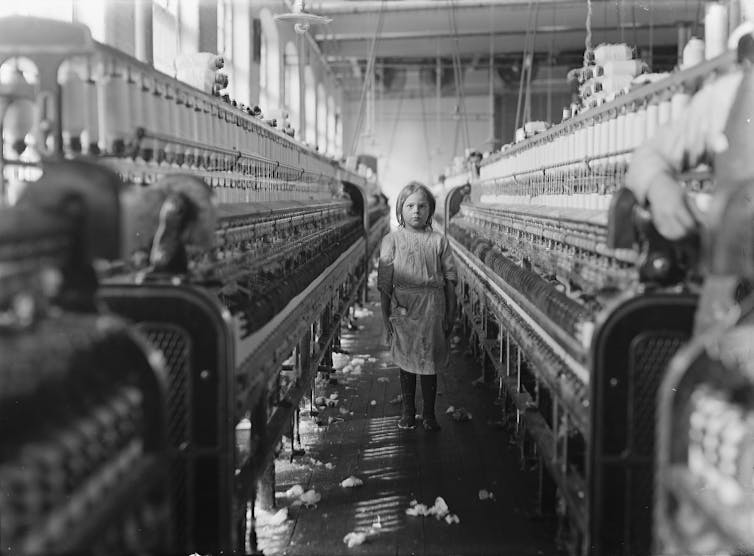
“Photography is a small voice, at best, but sometimes one photograph, or a group of them, can lure our sense of awareness.”
Portraying injustices is not something novel. From the beginning of the twentieth century to present day, many photographers have been concerned about leaving their mark. But can we try to change the world – even make it a better place – through a photograph?
You would be surprised to know how many photographers have tried to use their images to persuade us of the need for change. In these cases, photography is intended to make amends, to denounce certain situations and to elicit a response.
From The World To Utopia
The term “documentary photography” refers to images made with the aim of reflecting the world, respecting facts and seeking veracity. As such, documentary photography is an image that confirms, certifies an event and is based on its ability to bring reality closer. This does not mean that documentary photography shows the whole truth nor is it the only photographic possibility. On top of that, those photographs need to be disseminated and need an audience to be challenged by them.
Utopian documentary is an aspect of documentary photography, but it goes further. Photographs are not only taken to indicate something, to show reality, but they also rely on an image’s potential ability to convince, its powers of persuasion to improve the world.
How can a photograph have such an impact on us? On one hand, the mechanical component of photography (the camera) makes perceived facts more believable. On the other, photography is socially considered to be more accurate than other means of art. The photographer focuses on reality, obtaining an image that, by analogy with the portrayed subject, will be synonymous with veracity. Moreover, there is another idea that in order to capture said image, the photographer had to be an eyewitness – they had to be there.
The Beginnings Of Documentary Photography
The first images produced with a camera were obtained nearly two centuries ago. From the very beginning, photography swayed between being documentary, getting closer to reality and representing facts, and being artistic, expressing feelings and building scenes. In other words, truth or beauty.
Documentary intention in photography, however, did not emerge until the late nineteenth and early twentieth centuries. It all began in New York, with Jacob August Riis (1849 - 1914) and Lewis Hine (1874-1940). Both photographed social themes with the ultimate aim of highlighting certain inequalities in order to change them. It is important to understand that during those years the transition to an industrialised society created massive inequalities.

In 1890, Jacob A. Riis, an immigrant of Danish origin who was aware of the limits of the written word to describe facts, began taking photographs to show the vulnerability and living conditions of urban immigrants.
A few years later in New York he published How the Other Half Lives. The book was highly significant and led to urban reform in the city’s less favoured areas, for example with the creation of playgrounds or gardens.
At the beginning of the twentieth century, Lewis Hine, the first sociologist to make himself “heard” with a camera, took photographs of immigrants arriving at Ellis Island, showing how they adapted to a new life. However, his most important works were on child labour in mines and textile factories. Thanks to these images he was able to promote the Child Labor Protection Act.
This intention of reform would be maintained in the 1930s, also in the US, through the Farm Security Administration – a set of reforms and subsidies approved during the Roosevelt administration with the aim of alleviating the suffering caused by the crash of 1929. In this programme, a number of photographers were recruited to raise awareness among citizens, through images, of the need for such aid. Dorothea Lange, Walker Evans and Margaret Bourke-White, among others, are worth noting.
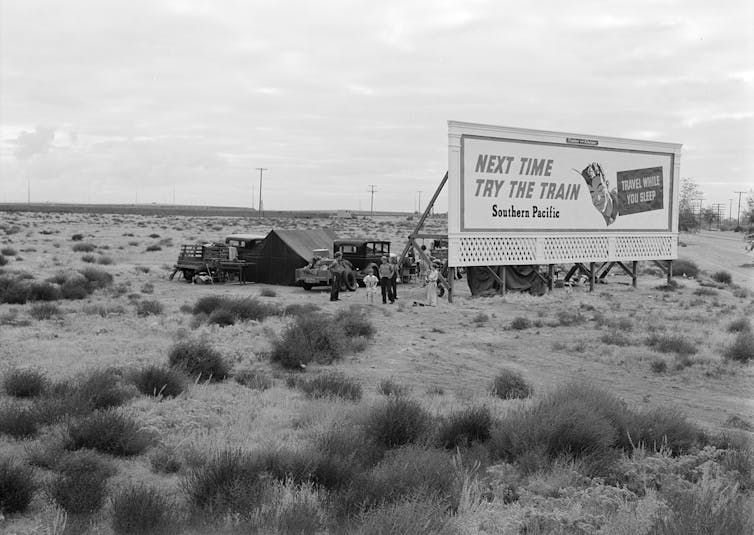
From Documentary Photography To Photojournalism
After World War II, documentary photography lost some of its vigour. Photojournalism, however, took up its principles, and illustrated magazines, which were a booming success, published topics of human interest.
Sebastião Salgado (Brazil, 1944) was one of the noteworthy photographers at the end of the century. His main work focused on portraying the suffering of humans who experienced situations of exile, emigration, hard working conditions or the misery of certain communities. It shows the Western world what life is like in places where our gazes do not fall. The Spaniard Gervasio Sánchez, with his long-term project Mined Lives, and James Nachtwey, with his work in Afghanistan, are notable contributors to this field.

Nowadays there are photographers with the same concerns who seek to persuade their contemporaries to change the world and mobilise consciences. Furthermore, it is already fully accepted that documentary photographs can offer many possibilities and that they are not governed by one specific formula.
Since the end of the twentieth century, the meaning of the word ‘documentary’ in photography has been evolving, although the same confidence in the communication capacity of photographs runs through every definition.
It could be said that documentaries that aim to improve and stimulate responses are still valid and relevant. There are still photographers who are interested in reforming and persuading their contemporaries of the need to make the world a better place and who still believe that documentary photography has to be committed to this goal. In short, they have not given up on utopia.
However, wherever there is a photographer, there must also be an audience that recognises those images as documents and is able to read them, giving meaning to the images and acting accordingly.
Obviously, it will depend on each person and the life moment they are experiencing at that time. We will not all be affected in the same way. Nevertheless, as individuals, if we ultimately feel challenged by these photographs and we are moved, even just a little, we can do great good.![]()
Beatriz Guerrero González-Valerio, Profesora de Fotografía y Estética, Universidad CEU San Pablo
This article is republished from The Conversation under a Creative Commons license. Read the original article.
Research shows giraffes can use statistical reasoning. They’re the first animal with a relatively small brain known to do this

Humans make decisions using statistical information every day. Imagine you’re selecting a packet of jellybeans. If you prefer red jellybeans, you will probably try to find a packet that shows the most red (and less of the dreaded black ones) through the small window.
Since you can’t see all the jellybeans at once, you’re using statistical reasoning to make an informed decision. Even infants have this capability.
And as it turns out, humans aren’t alone in using statistical inferences to make decisions. Great apes, long-tailed macaques and keas have all been shown to use the relative frequencies of items to predict sampling events.
Now a new study has added giraffes to this list. The research, published today in Scientific Reports, shows giraffes can use statistical inferences to increase their likelihood of receiving carrot slices rather than zucchini – much like a human picking jellybeans.

Brain Size And Statistical Skills
Until now, primates and birds were the only animals to show evidence of statistical reasoning. Both are considered to have large brains relative to body size, which is often linked with higher intelligence.
Researchers at the University of Barcelona, University of Leipzig, and Max Planck Institute for Evolutionary Anthropology wanted to test whether an animal with a small brain relative to its body size could perform statistical reasoning.
Giraffes were an ideal choice. They have already demonstrated an ability to perform quantity discrimination (being able to tell a larger amount of items from a smaller amount), and their social systems and dietary breadth have been linked with the emergence of complex cognition.
How Does A Giraffe Demonstrate Statistical Reasoning?
As it turns out, giraffes love carrots but have only a lukewarm appreciation for zucchinis, making these foods ideal to use in a statistical reasoning task.
Working with four giraffes, the researchers placed different proportions of carrot and zucchini slices into transparent containers to test if the giraffes could predict a higher likelihood of receiving a carrot in three tests of different treat quantities.
Each test consisted of 20 trials in which a researcher selected a piece of food from each container without showing the giraffe. The giraffe then touched the hand it wanted to eat from, using only the information it had from the containers.
The giraffes were reliably able to select the correct container in the trials of the first test, wherein the correct choice had both a higher quantity of carrots and lower quantity of zucchini slices.
In the second test, the quantity of carrots was the same in both containers, but the correct choice had fewer zucchini slices. Again, the giraffes were able to select correctly.
In the third test, the quantity of zucchini slices remained the same, but the correct container had a larger quantity of carrots. Yet again the giraffes chose correctly.

The combined results informed the researchers whether giraffes were using relative frequencies (statistical reasoning) or simply comparing absolute quantities of their preferred or non-preferred food.
Since the giraffes succeeded in all three tests, the researchers concluded they had used statistical inferences. If the giraffes had only been looking at the absolute quantities of the carrots, they would have succeeded in the first and second tests only, and failed the third.
Do You Need A Large Brain For Statistical Reasoning?
Evidence of statistical reasoning in giraffes suggests relatively large brains are not required to evolve complex statistical skills – at least in vertebrates (animals with backbones). Furthermore, the authors propose the ability to make statistical inferences may actually be widespread in the animal kingdom.
The question now is: how many other animals with small brains relative to their body size could also succeed in this task?![]()
Scarlett Howard, Lecturer, School of Biological Sciences, Monash University
This article is republished from The Conversation under a Creative Commons license. Read the original article.
Delivering The Largest Ever Pay Rise To Aged Care Workers: Federal Government Statements
- $11.3b to deliver 15% pay increase
- $487m to extend Disability Support for Older Australians
- $98.7m for provider viability support
- $12.9m to strengthen nutrition for aged care residents
- improve aged care residents’ dining experiences and food and nutrition reporting ($12.9 million over 2 years)
- require residential aged care services to provide residents with Monthly Care Statements on care provided and occurrences of significant change.
- enable continuous improvement and enhance Star Ratings for older Australians, and work to expand the Quality Indicator program to in-home care services ($139.9 million over 4 years)
- Fair Work Commission – Aged Care Work Value Case $11.3 billion over 4 years
- Residential Aged Care funding increase $8.5 billion over 4 years
- Home Care Packages program subsidy increase $2.2 billion over 4 years
- Commonwealth Home Support Programme grant increase $310 million over 4 years
- Flexible aged care programs funding increase $236.8 million over 4 years
- Veterans’ Home Care and Community Nursing fees increase $82.5 million over 4 years
- Funding for leave liabilities $98.7 million in 2023–24
- Establish a National Worker Registration Scheme for Aged Care $59.5 million over 5 years
- Building a strong regulatory framework for aged care $59.4 million in 2023–24
- Improving transparency, Star Ratings $139.9 million over 4 years
- Strengthening nutrition $12.9 million over 2 years
- Development and delivery of a Bill for a new Aged Care Act and associated ICT changes $81.9 million over 3 years
- Home Care Reform (Support at Home) $172 million over 4 years
- Aged Care Taskforce $0.7 million in 2023–24
- Trial of an assistive technology loans program $10.9 million over 2 years
- ICT Capability Development $73.1 million in 2023–24
- Single Comprehensive Assessment $15.7 million over 2 years
- Additional Home Care Packages $166.8 million in 2023–24
- Places to People: Embedding Choice in Residential Aged Care $41.3 million over 4 years
- General Practice Incentive in Aged Care $112 million over 4 years
- Aged Care Viability Support $98.7 million over 2 years
- Aged Care Prudential Reform $12.9 million in 2023–24
- Preliminary Report on the capability review of the Aged Care Quality and Safety Commission $25.3 million in 2023–24
- Supporting First Nations Elders in Aged Care $77.3 million over 4 years
- Disability Support for Older Australians $487 million over 4 years
A Tripartite Approach To Address Workforce Shortages In Aged Care
COTA: Budget 2023 Delivers Positive News For Older Australians – Particularly Older Women
Heart Health Assessment Rebate Extended
The aged-care budget delivers for workers but meeting our future needs will require bold funding reforms
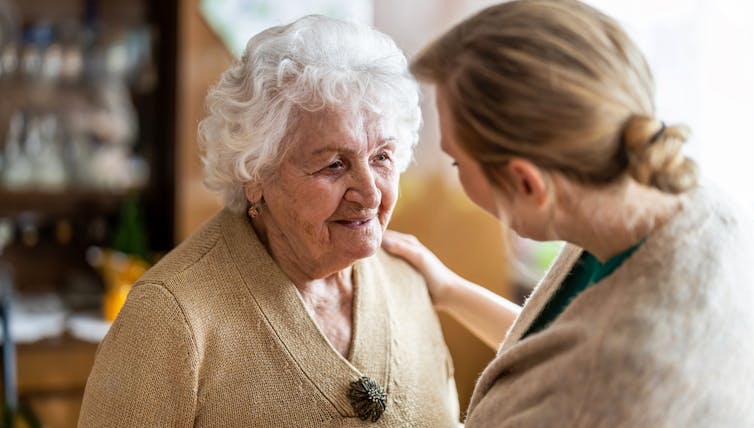
The 2023-24 federal budget takes a step in the right direction for aged care, with a much-needed pay boost for workers in the sector.
But there are major medium- to long-term challenges to overcome from cost increases. Despite a royal commission, major commitments from a new government and significant additional funding, around two-thirds of residential aged providers and one-quarter of home care providers are losing money.
If we’re going to have a functioning aged-care system in a decade or two that meets the needs of the ageing population, we need to consider bold reform to make it fit for purpose.
What’s The Problem?
Around 60% of government aged care funding is spent on residential care. Impersonal, large scale, “big box” aged-care institutions still dominate the system.
But older people in residential care are still getting less than the mandated three hours and 20 minutes of care per day. Only around $12 a day is spent on food. The commitment to have a registered nurse in all residential-care facilities won’t be met in the time period promised.
Not surprisingly, most people want care at home instead. There has been a massive increase in the number of home care packages in response. This part of the aged-care industry has proven much more profitable.
Even so, home care packages for more older people with more complex needs remain cumbersome and inefficient. Administrative costs are high, funding is too low for people with very complex needs and there are risks with the rapid introduction of new providers and the “uberisation” of services through new online platforms.
A new government Support at Home program is due to reform and replace the existing home care packages, home support program, respite care and short-term restorative care program. But it has again been delayed – now until 2025. There are ongoing concerns about the design and implementation of the program.
A major underlying problem for aged care is that workers are undervalued. Pay is not competitive with the disability and health-care sector and providers struggle to get staff. Career structures, supervision and training are all underdone.

What’s In The Budget For Aged Care?
The Fair Work Commission determined that wages for direct care workers should be increased by 15%. The budget includes $12.4 billion for aged care, mainly to fund pay increases for 250,000 aged-care workers in residential and home care.
Daily payment rates for aged-care residents will increase by 17.6% to cover pay increases and inflation and an additional 9,500 home care packages will be introduced over the next year.
This year’s federal budget is a step in the right direction, particularly in improving pay rates for aged-care workers. But the medium to longer term future for aged care remains bleak without significant further reform.
What’s Missing From The Budget?
Demand will increase dramatically as the number of people over 80 grows, the availability of informal carers decreases and community expectations increase. And there are continuing concerns about the way services are designed, organised and delivered.
Estimates suggest Australia will need to increase aged-care spending by $10 billion a year to implement the aged care royal commissions recommendations.
It would need to double to around 3% of GDP to be in line with high-quality aged care in comparable OECD countries.
Current funding is a complicated and unsustainable mix of Commonwealth government payments, means-tested user contributions and capital contributions for residential care.
Commonwealth payments are generated from general revenue. Effectively this is a pay-as-you-go model where today’s taxpayers meet the costs. Inevitably that means growth in spending is an ongoing political balancing act in the hurly burly of the annual budget process. There is no guarantee growth funding will be provided in the medium to longer term.
What Are The Alternatives?
There are alternatives, but none of them are likely in Australia.
A social insurance model like the transport accident, workers’ compensation and superannuation schemes could be introduced to fund aged care, at least in part. That would mean workers (and potentially their employers) would contribute to their potential future aged-care costs during their working lives. Social insurance models exist in Germany, Japan, Korea and the Netherlands.
In Australia, there have been calls for a superannuation levy on contributions to fund future aged-care costs. But this would fly in the face of the federal government’s intention to make it clear that the purpose of superannuation is to provide a decent retirement income rather than using it as a piggy bank to fund health and aged care.
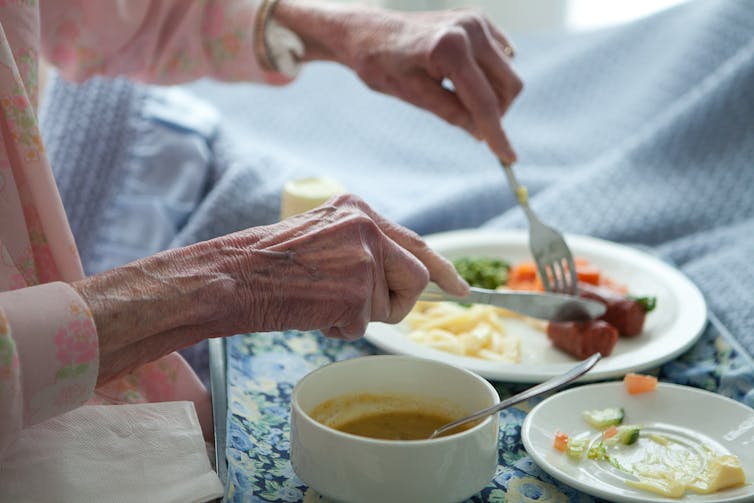
An other alternative is wealth taxes to pay for aged care. The current capital contribution schemes for residential care (Refundable Accommodation Deposit and Daily Accommodation Payment schemes) are an inefficient, inequitable and half baked model. More equitable, targeted universal estate taxes could be introduced to fund aged care, but that would raise the politically uncomfortable spectre of death duties.
The most palatable option to provide future growth funding for aged care would be the introduction of an aged-care levy as part of the general tax mix. A 1% levy, similar to the Medicare levy, would raise around $8 billion a year.
While Treasury generally opposes hypothecated levies, levy revenue already partially funds health and disability care. It would be reasonably easy to introduce (and popular with the community) for aged care.![]()
Hal Swerissen, Emeritus Professor, La Trobe University
This article is republished from The Conversation under a Creative Commons license. Read the original article.
Older Australians; Budget 2023
Scientists Develop AI Tool To Predict Parkinson's Disease Onset
Here’s how a new AI tool may predict early signs of Parkinson’s disease
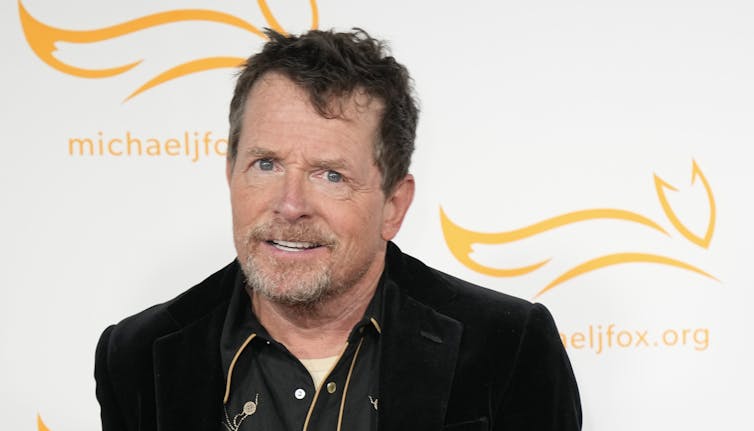
In 1991, the world was shocked to learn actor Michael J. Fox had been diagnosed with Parkinson’s disease.
He was just 29 years old and at the height of Hollywood fame, a year after the release of the blockbuster Back to the Future III. This week, documentary Still: A Michael J. Fox Movie will be released. It features interviews with Fox, his friends, family and experts.
Parkinson’s is a debilitating neurological disease characterised by motor symptoms including slow movement, body tremors, muscle stiffness, and reduced balance. Fox has already broken his arms, elbows, face and hand from multiple falls.
It is not genetic, has no specific test and cannot be accurately diagnosed before motor symptoms appear. Its cause is still unknown, although Fox is among those who thinks chemical exposure may play a central role, speculating that “genetics loads the gun and environment pulls the trigger”.
In research published today in ACS Central Science, we built an artificial intelligence (AI) tool that can predict Parkinson’s disease with up to 96% accuracy and up to 15 years before a clinical diagnosis based on the analysis of chemicals in blood.
While this AI tool showed promise for accurate early diagnosis, it also revealed chemicals that were strongly linked to a correct prediction.
More Common Than Ever
Parkinson’s is the world’s fastest growing neurological disease with 38 Australians diagnosed every day.
For people over 50, the chance of developing Parkinson’s is higher than many cancers including breast, colorectal, ovarian and pancreatic cancer.
Symptoms such as depression, loss of smell and sleep problems can predate clinical movement or cognitive symptoms by decades.
However, the prevalence of such symptoms in many other medical conditions means early signs of Parkinson’s disease can be overlooked and the condition may be mismanaged, contributing to increased hospitalisation rates and ineffective treatment strategies.
Our Research
At UNSW we collaborated with experts from Boston University to build an AI tool that can analyse mass spectrometry datasets (a technique that detects chemicals) from blood samples.
For this study, we looked at the Spanish European Prospective Investigation into Cancer and Nutrition (EPIC) study which involved over 41,000 participants. About 90 of them developed Parkinson’s within 15 years.
To train the AI model we used a subset of data consisting of a random selection of 39 participants who later developed Parkinson’s. They were matched to 39 control participants who did not. The AI tool was given blood data from participants, all of whom were healthy at the time of blood donation. This meant the blood could provide early signs of the disease.
Drawing on blood data from the EPIC study, the AI tool was then used to conduct 100 “experiments” and we assessed the accuracy of 100 different models for predicting Parkinson’s.
Overall, AI could detect Parkinson’s disease with up to 96% accuracy. The AI tool was also used to help us identify which chemicals or metabolites were likely linked to those who later developed the disease.
Key Metabolites
Metabolites are chemicals produced or used as the body digests and breaks down things like food, drugs, and other substances from environmental exposure.
Our bodies can contain thousands of metabolites and their concentrations can differ significantly between healthy people and those affected by disease.
Our research identified a chemical, likely a triterpenoid, as a key metabolite that could prevent Parkinson’s disease. It was found the abundance of triterpenoid was lower in the blood of those who developed Parkinson’s compared to those who did not.
Triterpenoids are known neuroprotectants that can regulate oxidative stress – a leading factor implicated in Parkinson’s disease – and prevent cell death in the brain. Many foods such as apples and tomatoes are rich sources of triterpenoids.
A synthetic chemical (a polyfluorinated alkyl substance) was also linked as something that might increase the risk of the disease. This chemical was found in higher abundances in those who later developed Parkinson’s.
More research using different methods and looking at larger populations is needed to further validate these results.

A High Financial And Personal Burden
Every year in Australia, the average person with Parkinson’s spends over A$14,000 in out-of-pocket medical costs.
The burden of living with the disease can be intolerable.
Fox acknowledges the disease can be a “nightmare” and a “living hell”, but he has also found that “with gratitude, optimism is sustainable”.
As researchers, we find hope in the potential use of AI technologies to improve patient quality of life and reduce health-care costs by accurately detecting diseases early.
We are excited for the research community to try our AI tool, which is publicly available.
This research was performed with Mr Chonghua Xue and A/Prof Vijaya Kolachalama (Boston University).![]()
Diana Zhang, Fulbright and Scientia PhD Scholar, UNSW Sydney and William Alexander Donald, Associate Professor, ARC Future Fellow & UNSW Scientia Fellow, UNSW Sydney
This article is republished from The Conversation under a Creative Commons license. Read the original article.
‘Queue Jumpers’ Who Opt To Retire Early Are Catching Companies Off Guard
Bold and innovative planning is delivering Australia’s newest city. But it will be hot – and can we ditch the colonial name?
Tooran Alizadeh, University of Sydney; Glen Searle, University of Sydney, and Rebecca Clements, University of SydneyA massive project is unfolding in Sydney’s Western Parkland region. The building of a new city from the ground up is central to an infrastructure-led restructuring of metropolitan Sydney. The catalysts are the Western Sydney City Deal and the Western Sydney Airport being built alongside the new Bradfield City.
Bradfield city is being developed on unceded Aboriginal land with complex ongoing settler-colonial legacies and high stakes for diverse First Nations communities – including the largest urban Indigenous population in Australia. Yet it is named after a colonial figure with no connection to the land.
Our case study research acknowledges what is happening in the Western Parkland development as being at the forefront of urban and infrastructure governance across Australia. It’s particularly notable how all three tiers of government – federal, state and local – have come together in this massive project.
Yet we have also identified a range of concerns, including public consultation, project funding, urban heat and water demand, the need for affordable and public housing, and other social equity issues.
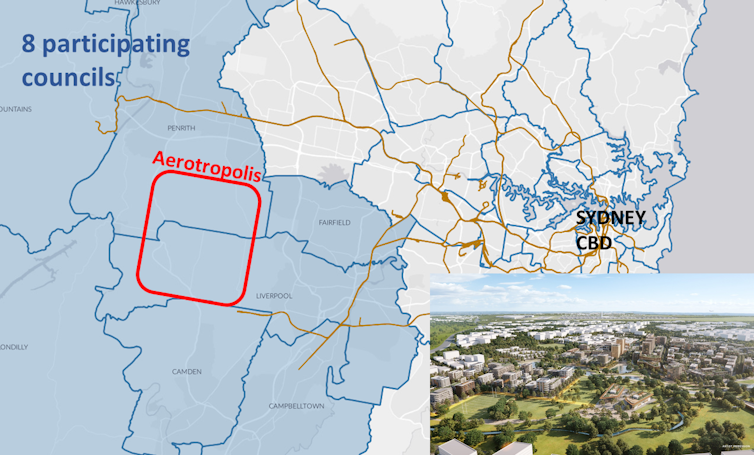
City’s Name Is Not A Good Start
The case study is part of a three-year (2020-2023) research project, the Infrastructure Governance Incubator, across three universities – Sydney, Melbourne and Monash. Our study includes 55 interviews with key stakeholders from all tiers of government, as well as non-government and community voices.
Participants from across the board have seen the “Bradfield” naming as a shameful decision. It’s in stark contrast to the positive steps towards supporting Indigenous voices throughout the project. These steps include the award-winning Recognise Country guidelines, Indigenous-led design projects, a Koori Perspectives Circle, and new Indigenous roles within government authorities to support engagement efforts.
In Australian cities, it is critical we explore the role of infrastructure in perpetuating settler-coloniality and in making space for Indigenous-led futures. The complex challenges of a case like this can inform important discussions about how we might improve infrastructure planning to produce just and sustainable approaches.
Our research participants saw a need for governments to give meaningful attention to building relationships and developing cross-cultural understandings. This involves early conversations with Aboriginal groups and adequate resourcing for engagement. Too often, these groups are brought on late in processes after key decisions are already made.
Interviewees stressed the importance of governments “learning to listen”. This requires having the openness to hear what is being said even if inconvenient. Many participants wanted to see Indigenous voices empowered in decision-making, not simply advisory.
“Listening” also means “listening to Country”. Part of demonstrating commitment to relationship building involves sustainably protecting Country. Early and ongoing public scrutiny is essential to ensure the project’s short-term approaches align with long-term perspectives on sustainable outcomes. It may also mean taking steps more slowly and carefully to get it right.
The state government could take some key actions. These include committing resources to advancing the many Indigenous land claims and applying exemptions to development barriers such as biodiversity offset obligations. These currently treat First Nation stakeholders like a developer, ignoring their long and ongoing care for Country.
Many participants also raised serious environmental concerns, including water management and extreme heat in the new city. Heatwaves can be 5-10℃ hotter there than the rest of Sydney.
Some fundamentally questioned a massive greenfield development in such a vulnerable environment. Others saw this as a chance to make much-needed transformational changes to our planning systems.
Focus On Jobs Overshadows Other Issues
The political focus is on creating jobs in Western Sydney. Participants generally agreed it’s important to rebalance the metropolitan job market and economy.
However, many were concerned this focus has come at the expense of attention to other aspects of inequity, including access to affordable and public housing, public health and social services.
In terms of metropolitan planning, the centralised way the new strategy was adopted is a problem. The concept came from the then Greater Sydney Commission and was supported by the region’s councils.
The communities of the wider Sydney region, however, were not given strategic alternatives to consider. In particular, the concept was not put to traditional Indigenous custodians before being adopted.
One of the alternatives might have acknowledged the outer west as the hottest part of Sydney. It could instead have considered development in cooler parts such as Dural or the Central Coast. These sites might have been better placed to manage global warming challenges.
Governance Is Still A Work In Progress
Our participants agreed the complexity of urban challenges requires a concerted effort to better integrate infrastructure decision-making. Part of the challenge is to overcome legacies of fragmented urban governance. It’s a result of divisions of responsibilities between tiers of government and siloed decision-making across and within these tiers.
The Western Sydney City Deal is generally seen as a major step towards better integration of all levels of government. Nevertheless, participants note important shortfalls.
City Deal funding committed to date is likely too little, given the major place-making ambitions. While it’s useful for short-term projects, local governments need solutions for their major long-term funding issues, especially in the face of new growth pressures. Lack of funding fuels existing cultures of competition between authorities.
The Western Sydney City Deal has had some welcome successes in improving collaboration between the three levels of government. Local governments have secured “seats at the table”, where they have been able to renegotiate the terms of collaboration and governance.
However, important questions remain about how governments collaborate with community infrastructure sectors, non-government organisations and community advocates. Many have raised concerns about lack of meaningful inclusion or being engaged too late for meaningful impact.
An example of these issues is the three-year review required under the Western Sydney City Deal signed in 2018. An independent university group completed the review in 2021. It has never been released to the public.
Interviewees told us the review was productive and made useful governance recommendations. However, some suggested it was not released due to state government discomfort with the findings.
We strongly urge the newly elected state government to make the review public and commit to a timely release of all similar documents in future. This will help build trust with the community.![]()
Tooran Alizadeh, Associate Professor in Urbanism and Infrastructure, ARC Future Fellow, University of Sydney; Glen Searle, Honorary Associate Professor in Planning, University of Queensland, University of Sydney, and Rebecca Clements, Postdoctoral Research Associate, Faculty of Architecture, Building and Planning, University of Sydney
This article is republished from The Conversation under a Creative Commons license. Read the original article.
We Need To Talk About Ovarian Cancer; Our Deadliest Gynaecological Cancer
Why Are Electricity Prices Rising Again?
 Customers on standard energy plans in New South Wales, Queensland, and South Australia could see increases of up to 24 per cent on their bills next financial year, according to a draft determination by Australian Energy Regulator (AER) – the body which manages wholesale electricity and gas markets across Australia. The Victorian regulator – the Essential Services Commission – has also flagged a hike of up to 30 per cent in the state.
Customers on standard energy plans in New South Wales, Queensland, and South Australia could see increases of up to 24 per cent on their bills next financial year, according to a draft determination by Australian Energy Regulator (AER) – the body which manages wholesale electricity and gas markets across Australia. The Victorian regulator – the Essential Services Commission – has also flagged a hike of up to 30 per cent in the state.T Cells Can Activate Themselves To Fight Tumours
Researchers Discover A Cause Of Rapid Ice Melting In Greenland
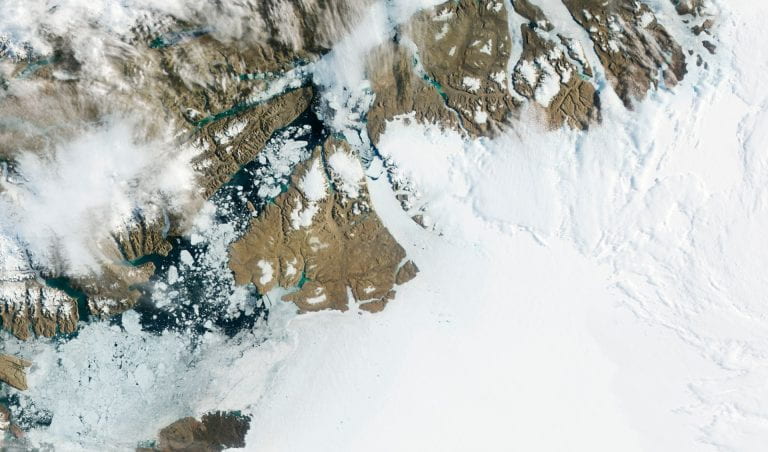
Smallest Shifting Fastest: Bird Species Body Size Predicts Rate Of Change In A Warming World
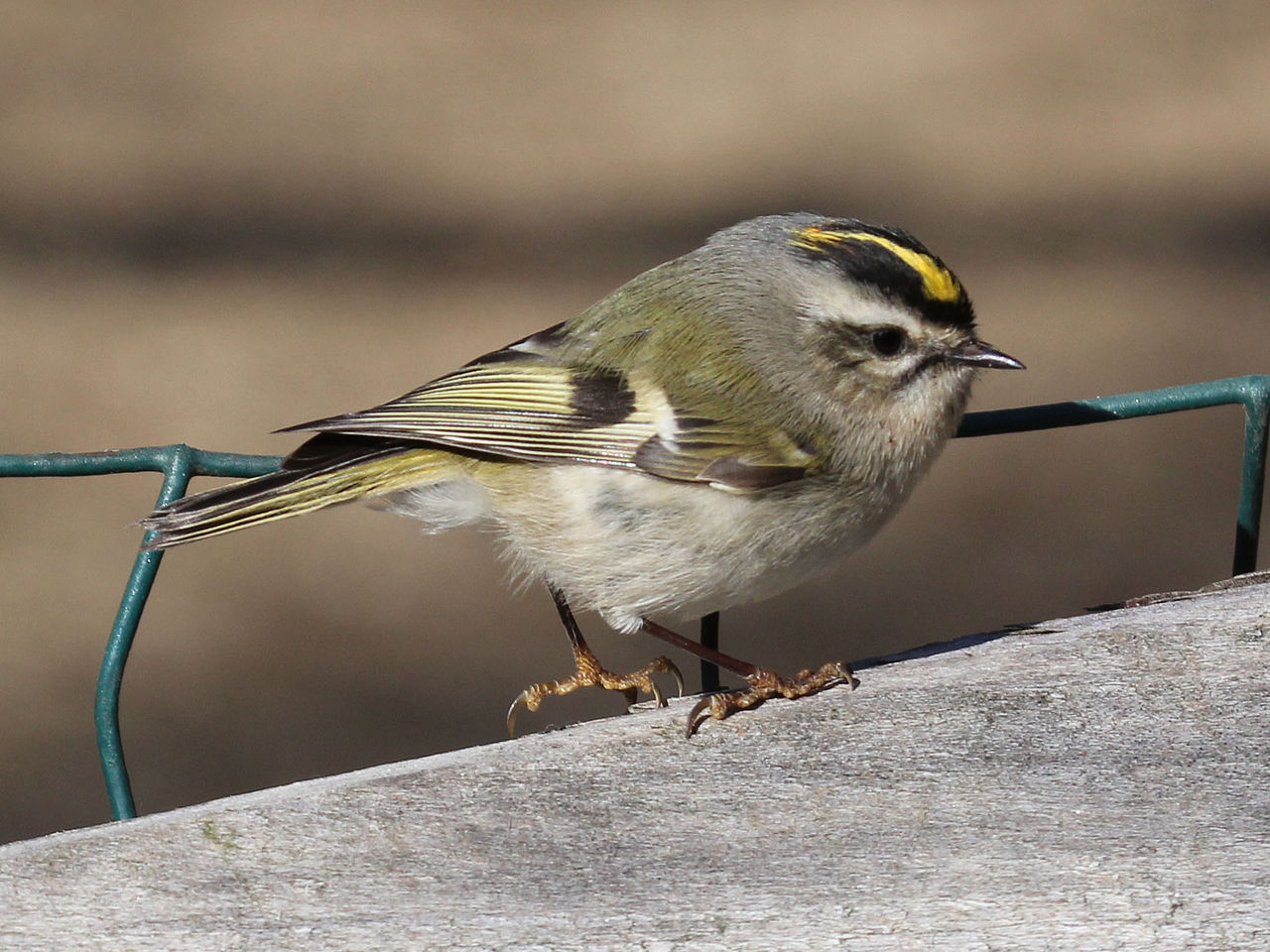
Potential Found To Counter Depression By Restoring Key Brain Rhythm
Kangaroo Island Ants 'Play Dead' To Avoid Predators
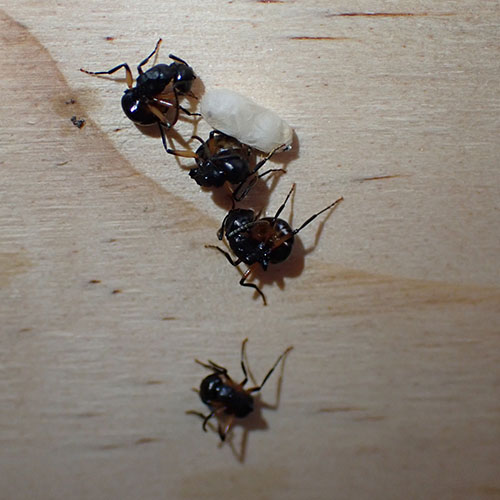
Disclaimer: These articles are not intended to provide medical advice, diagnosis or treatment. Views expressed here do not necessarily reflect those of Pittwater Online News or its staff.